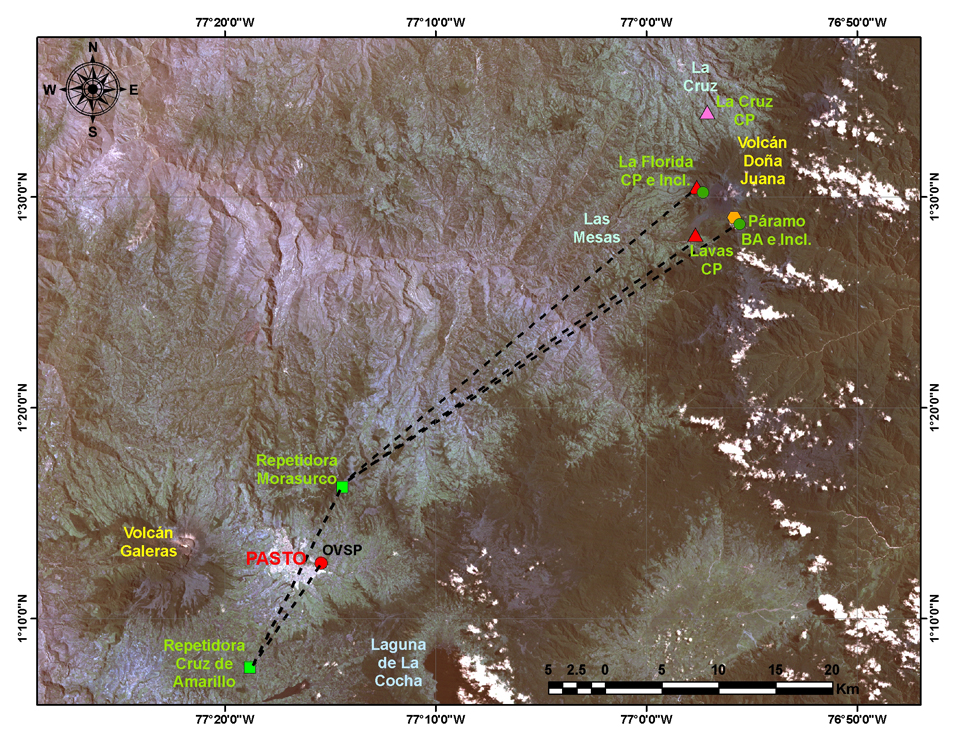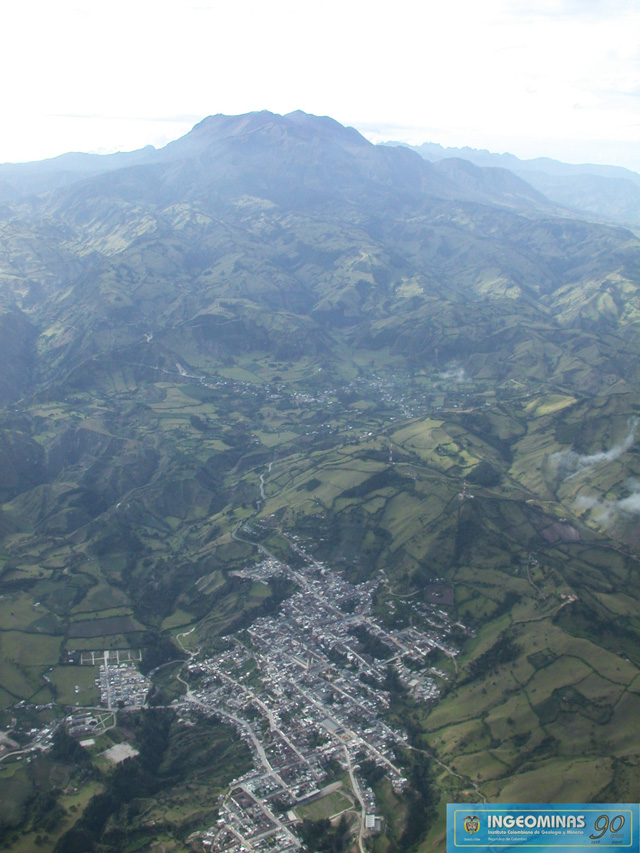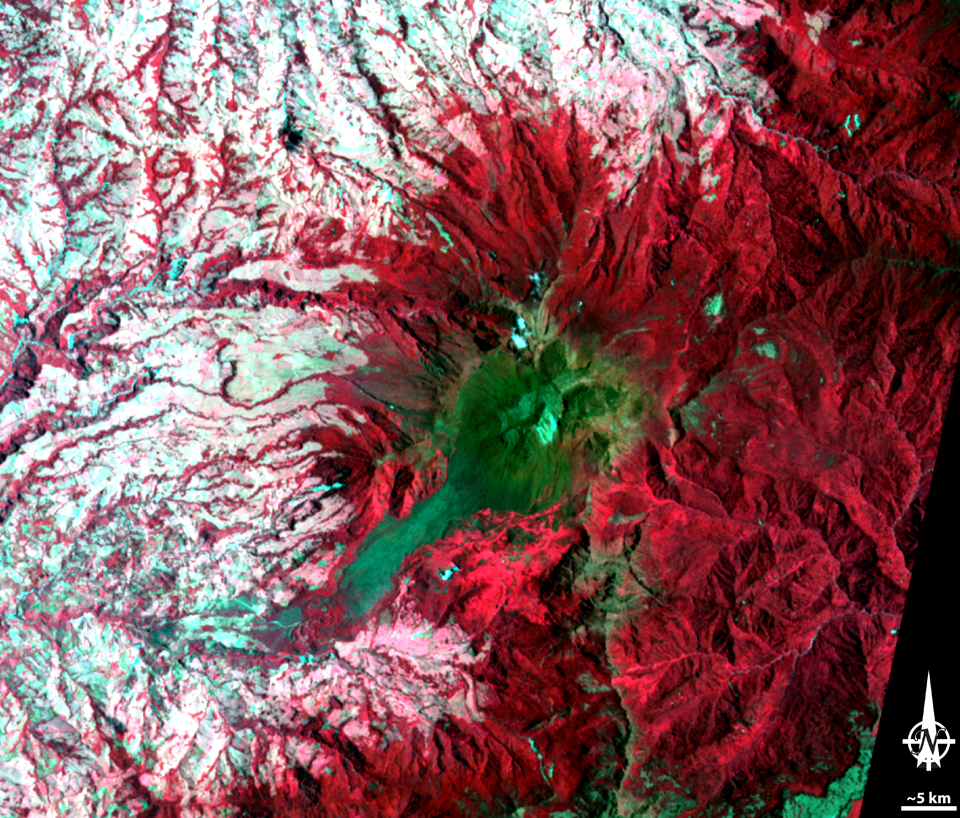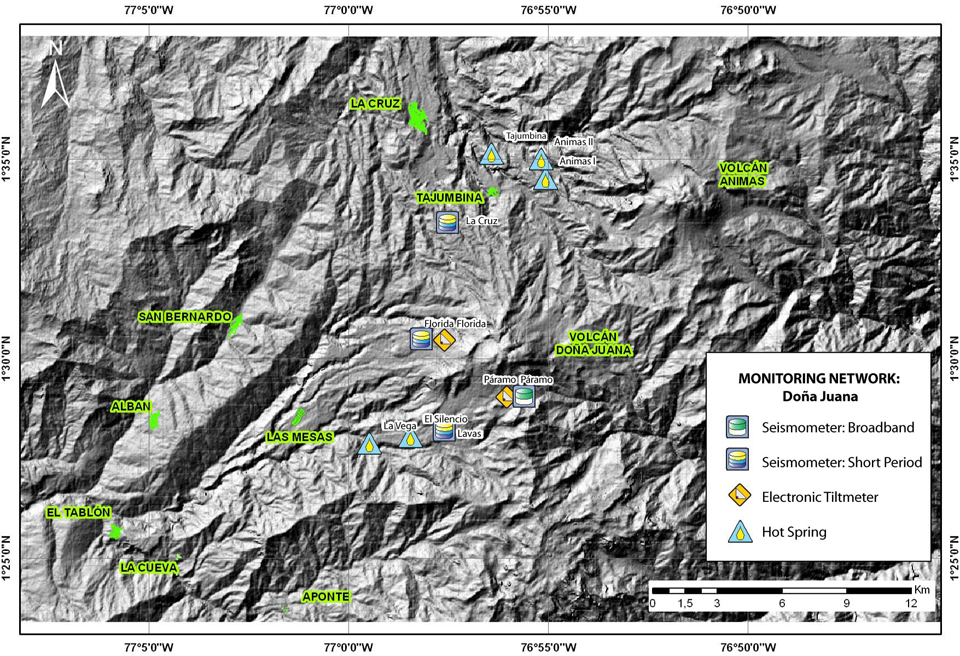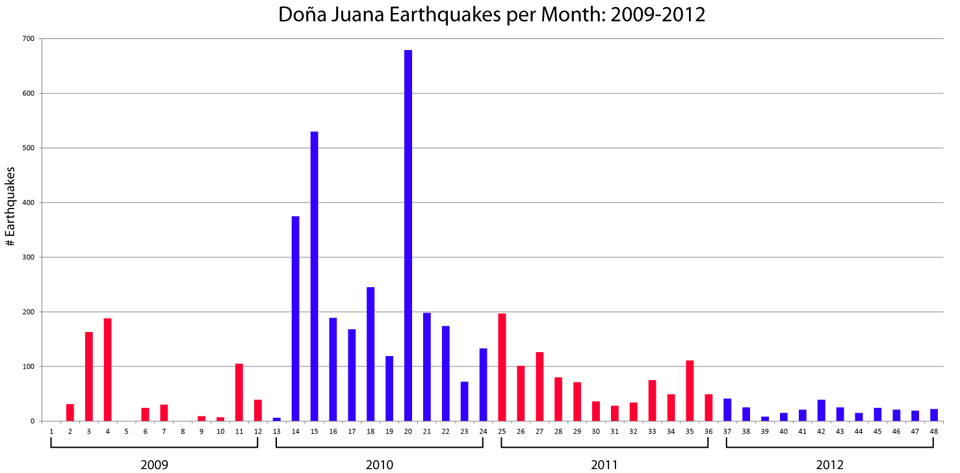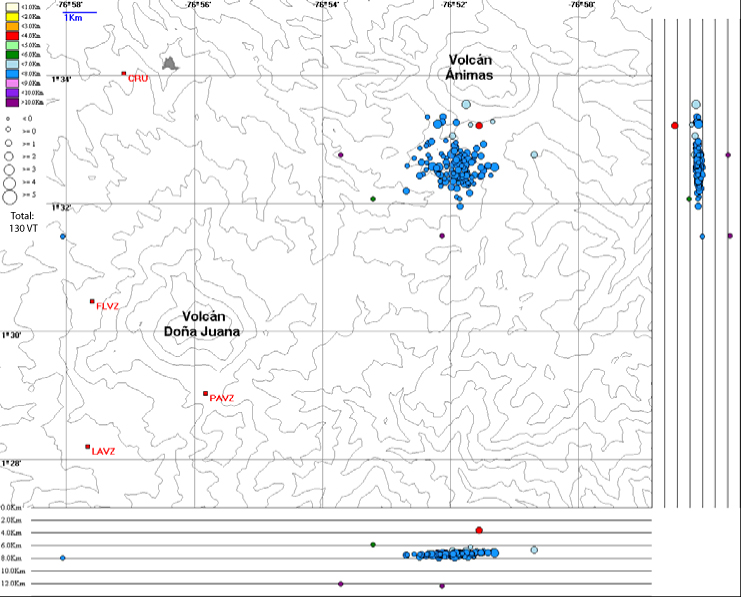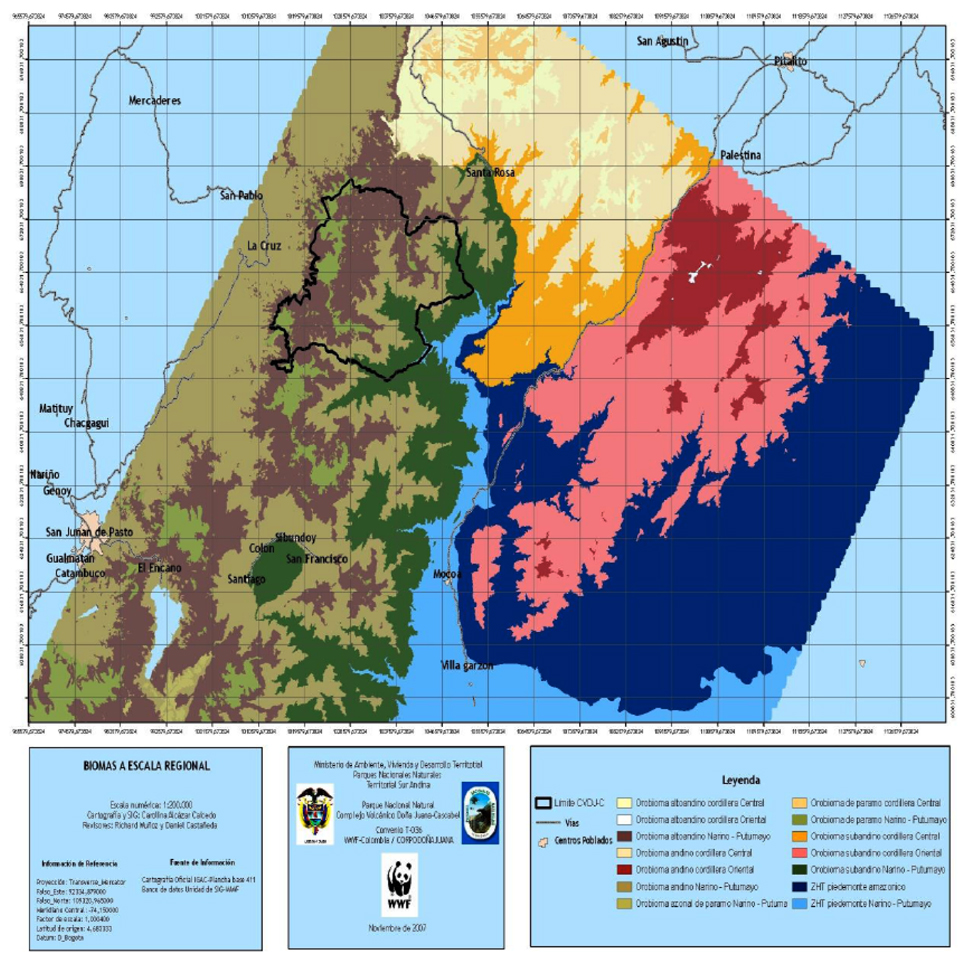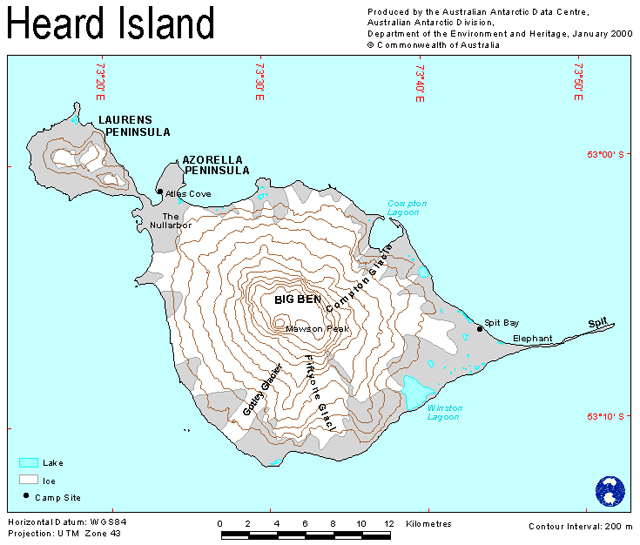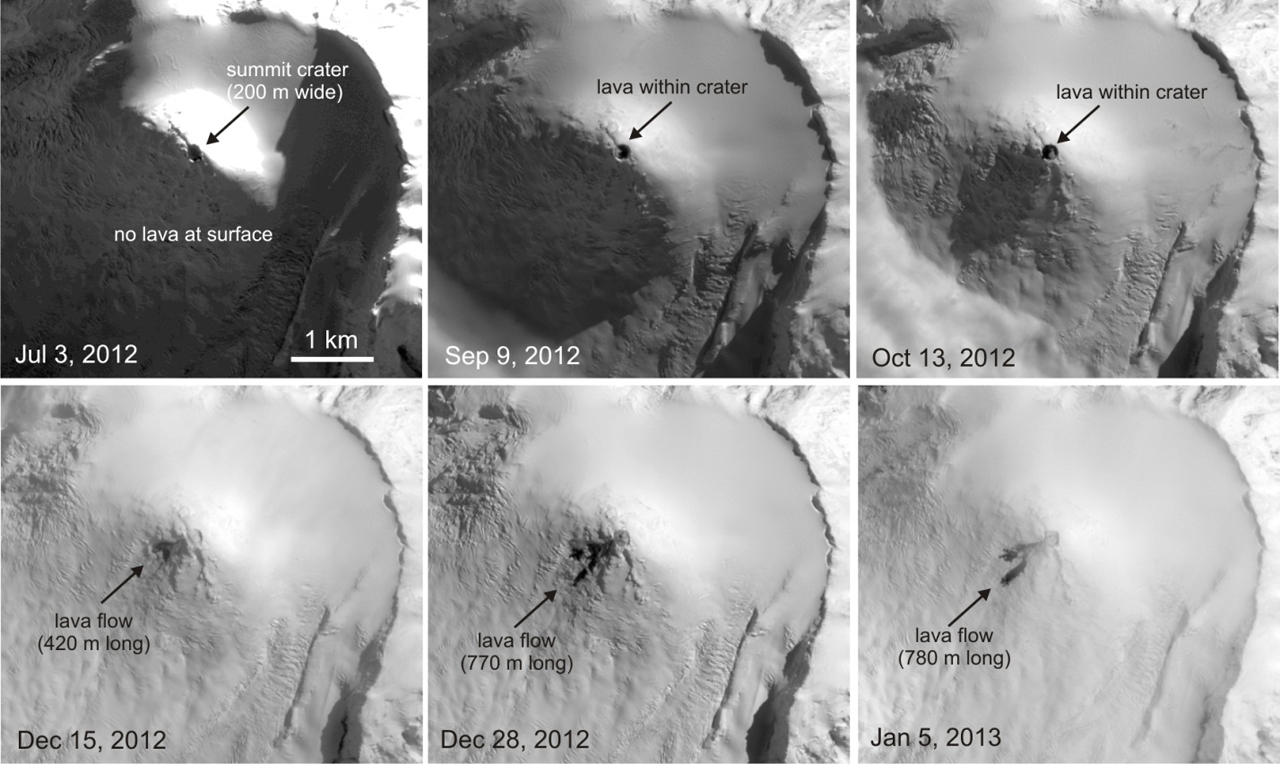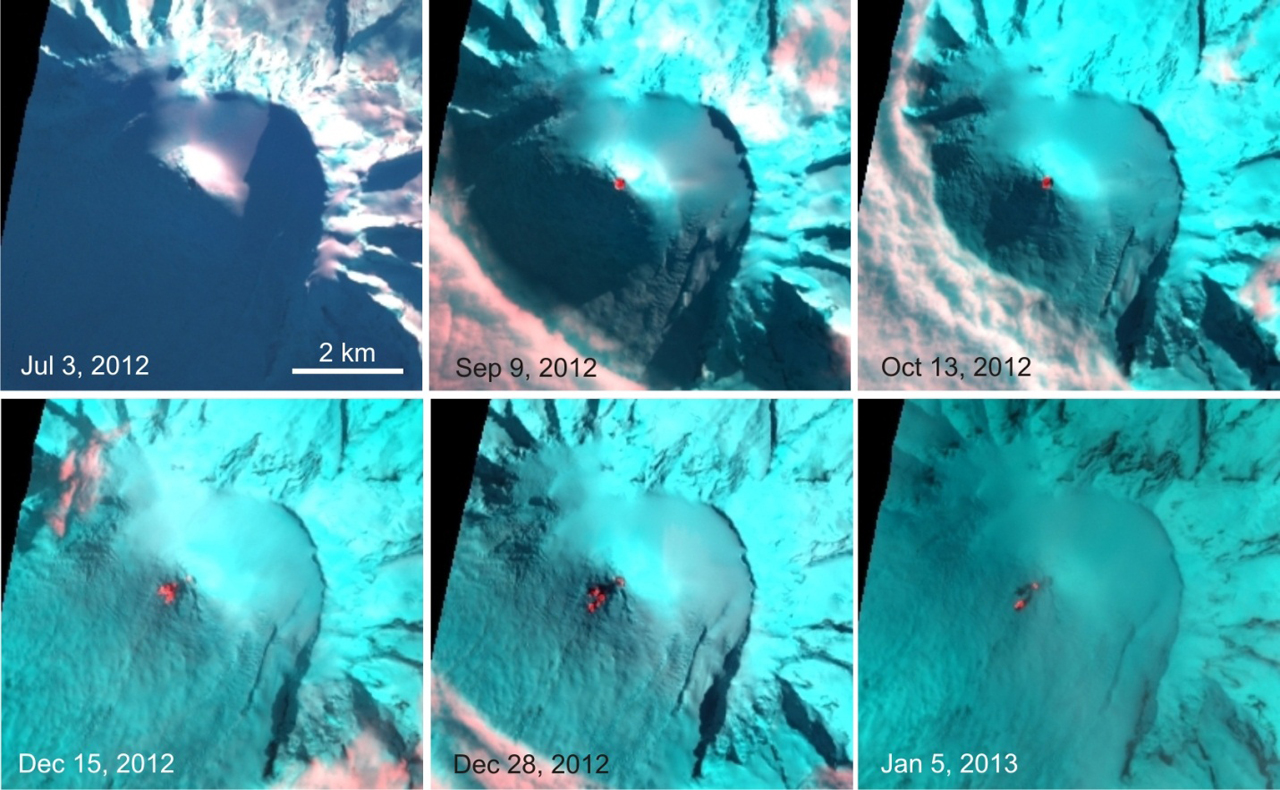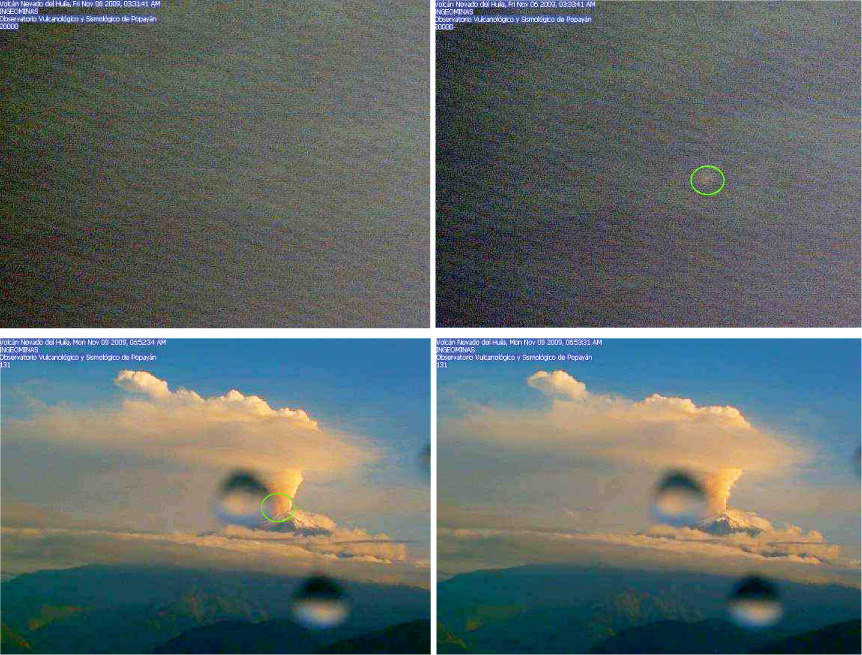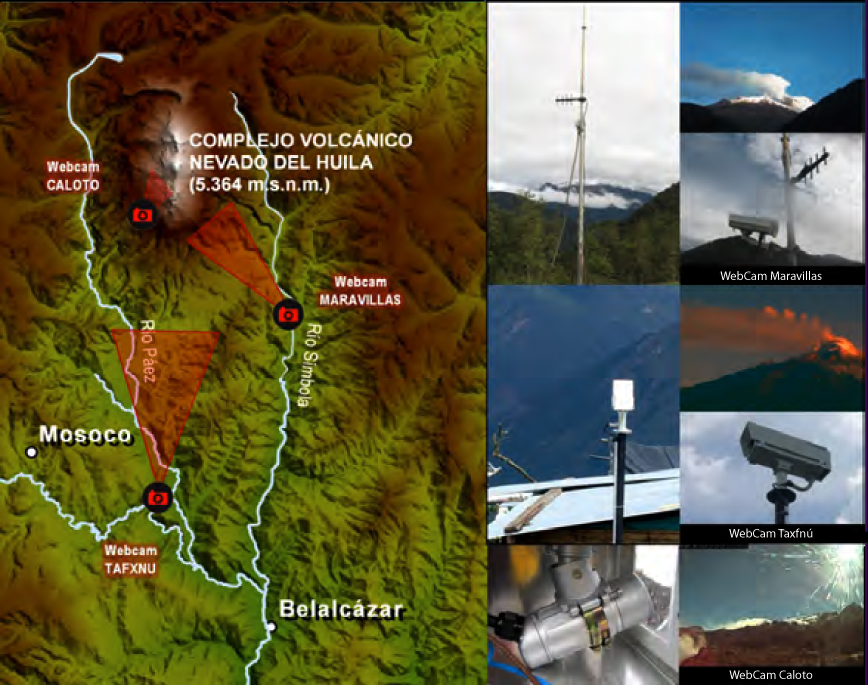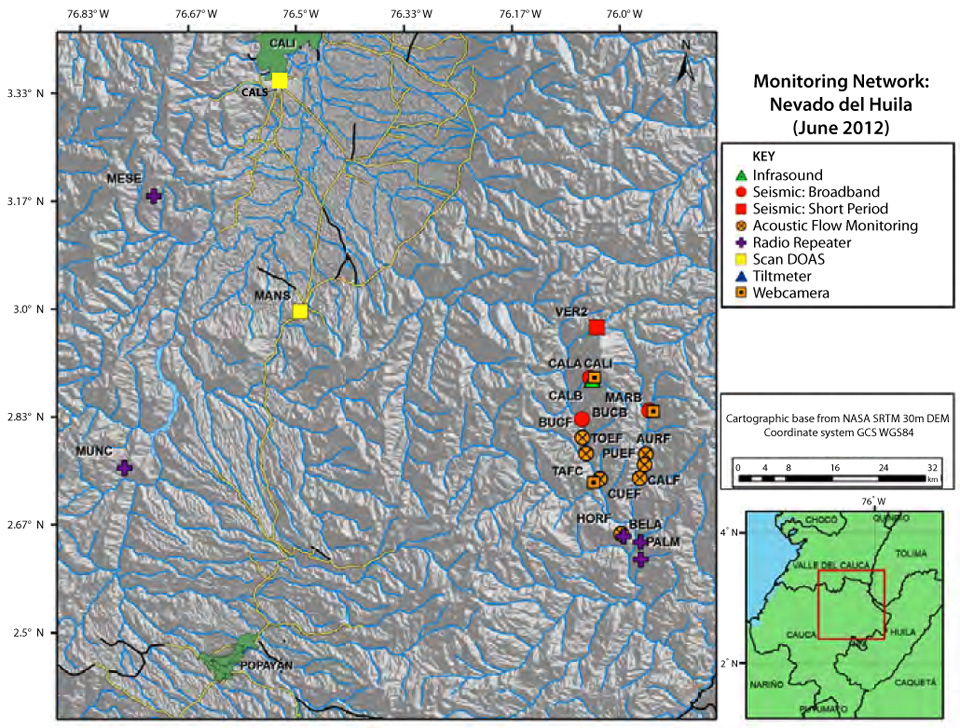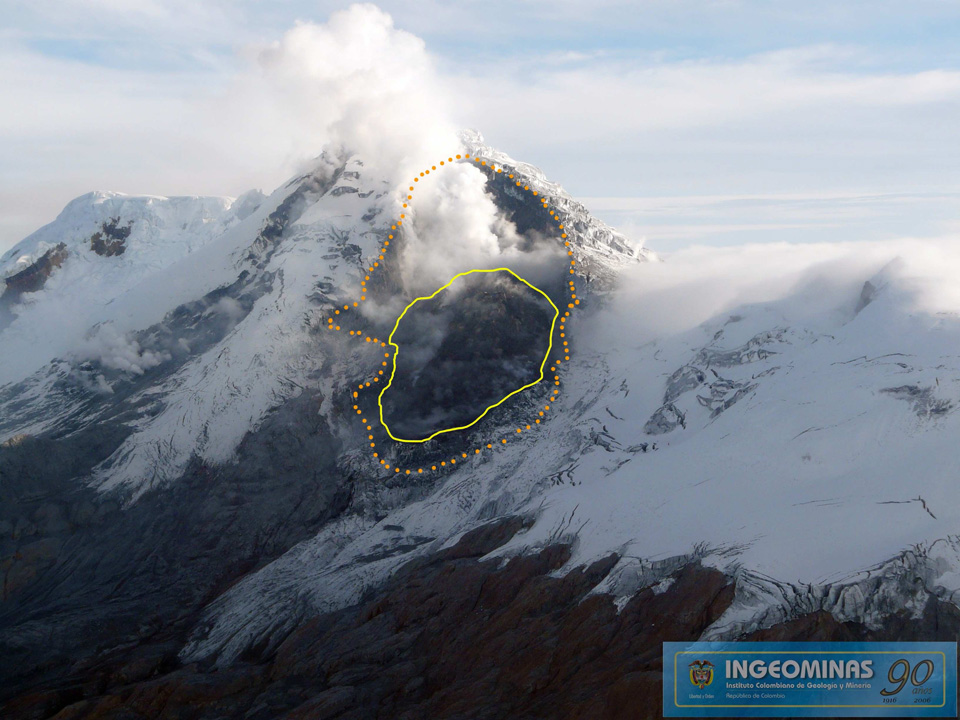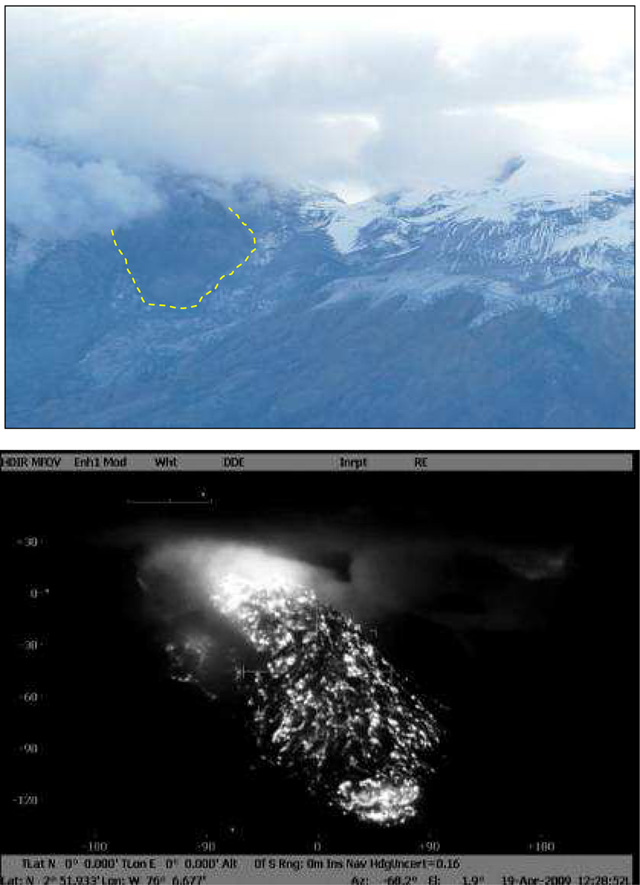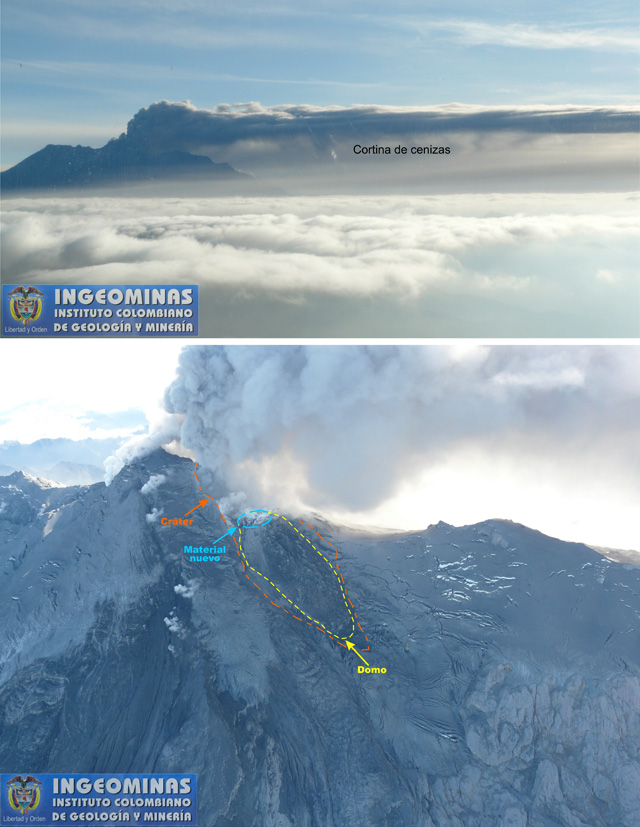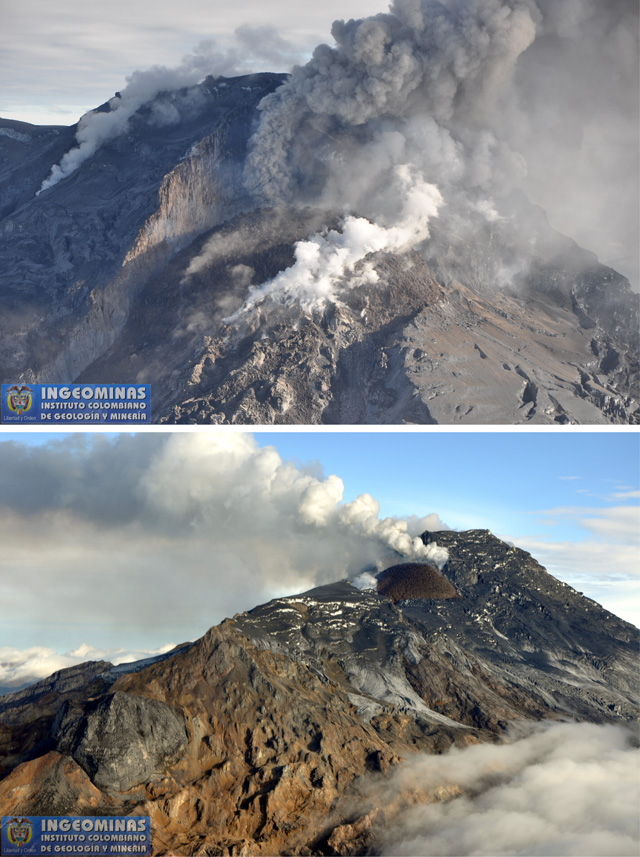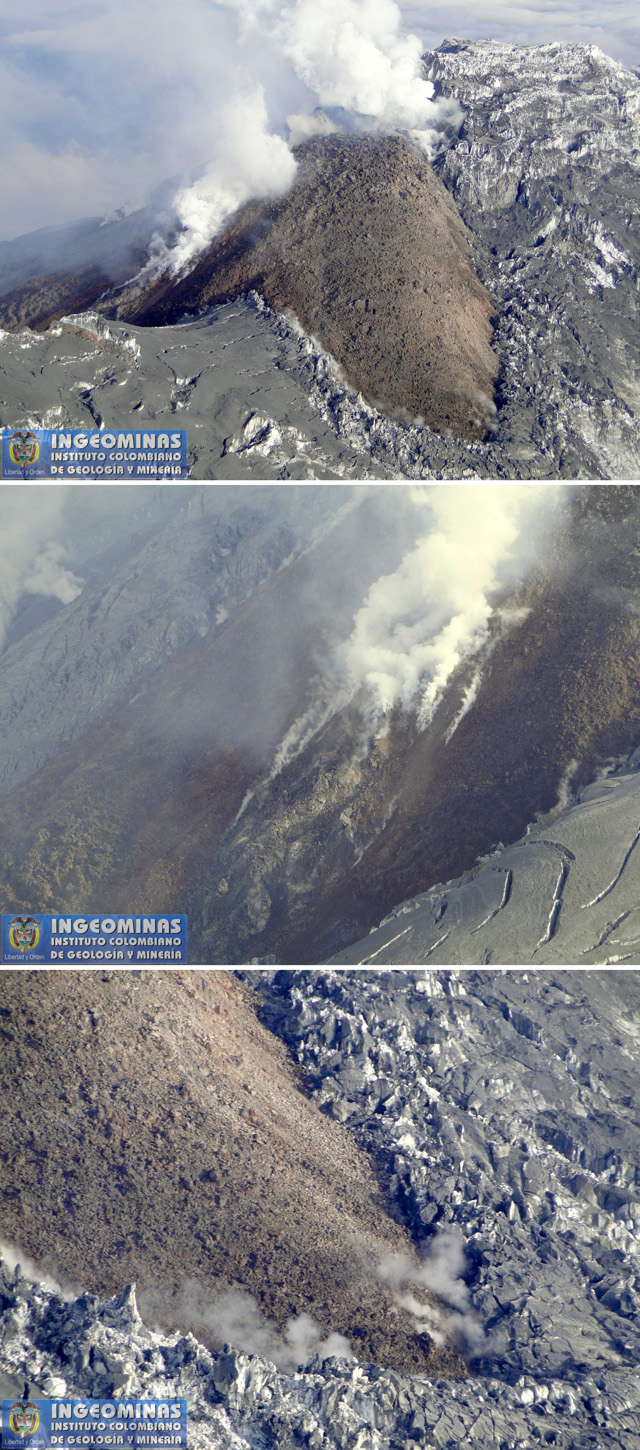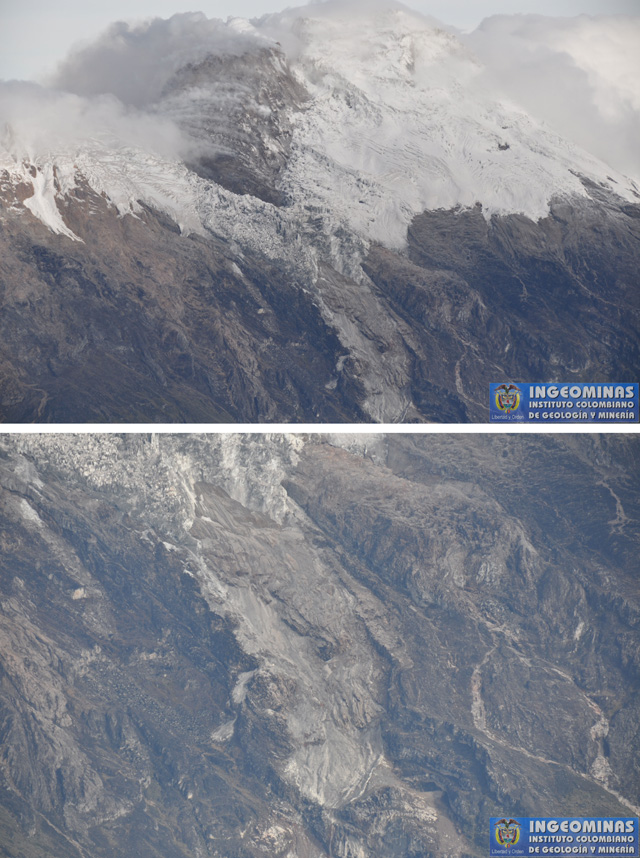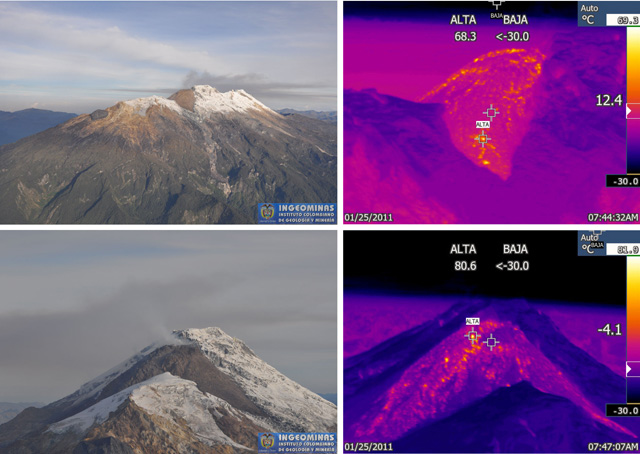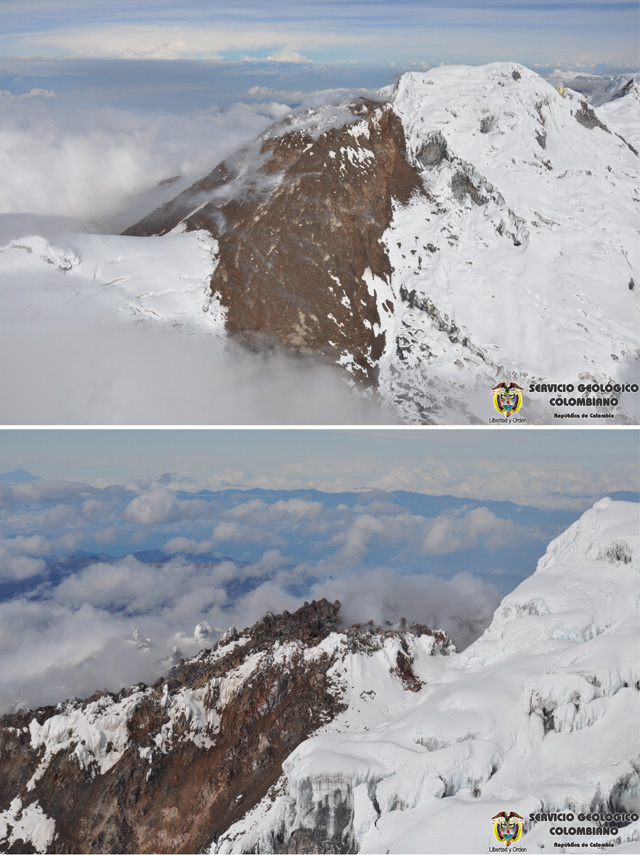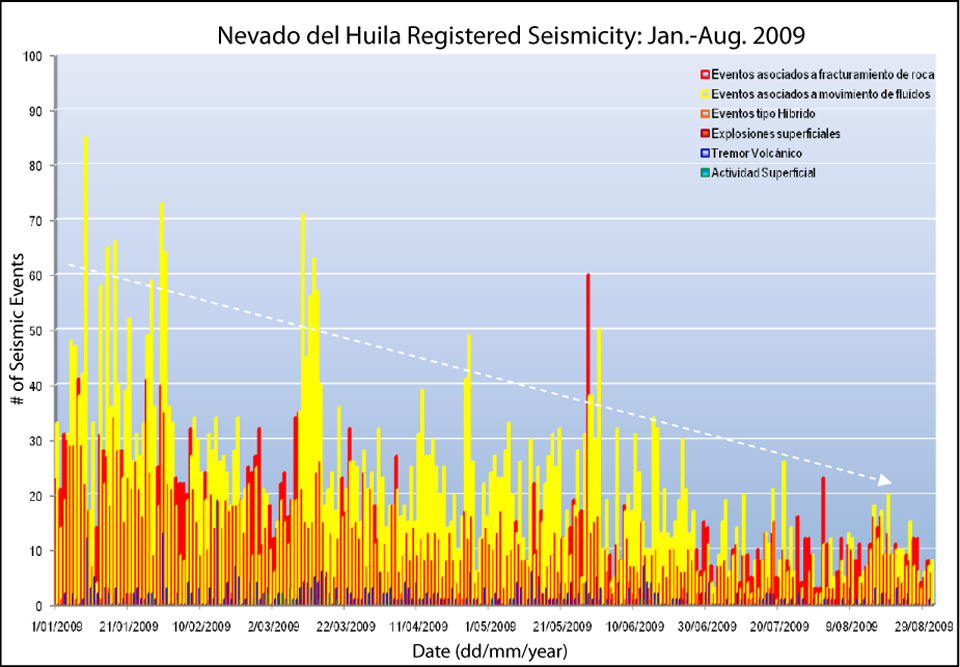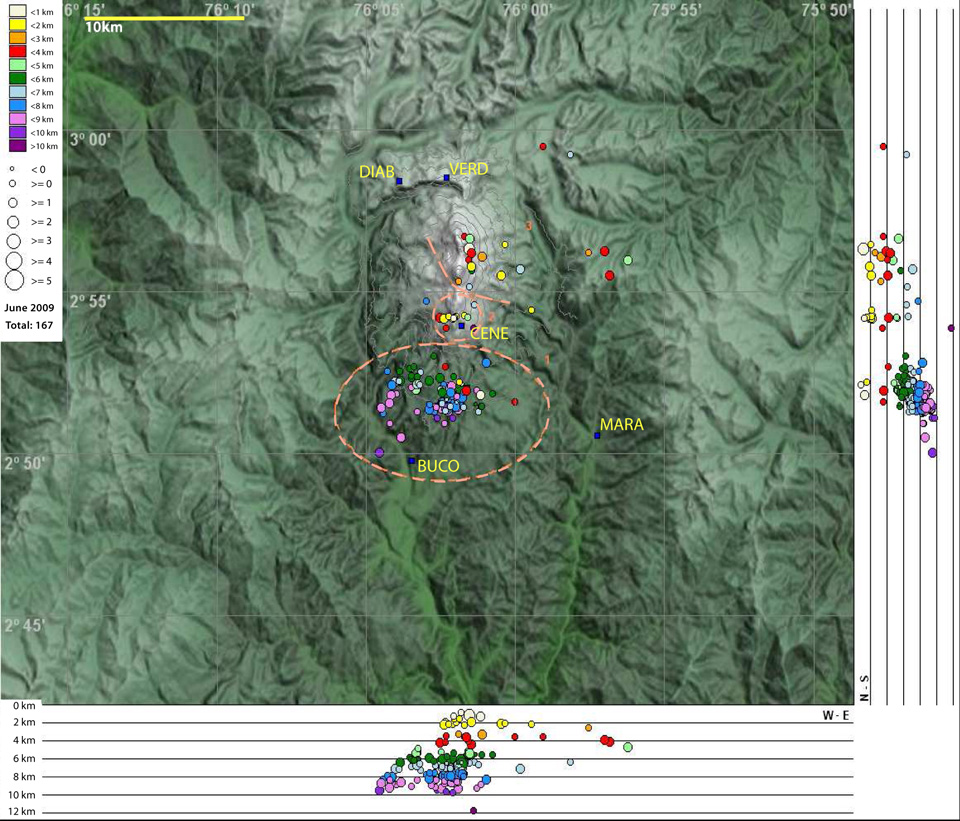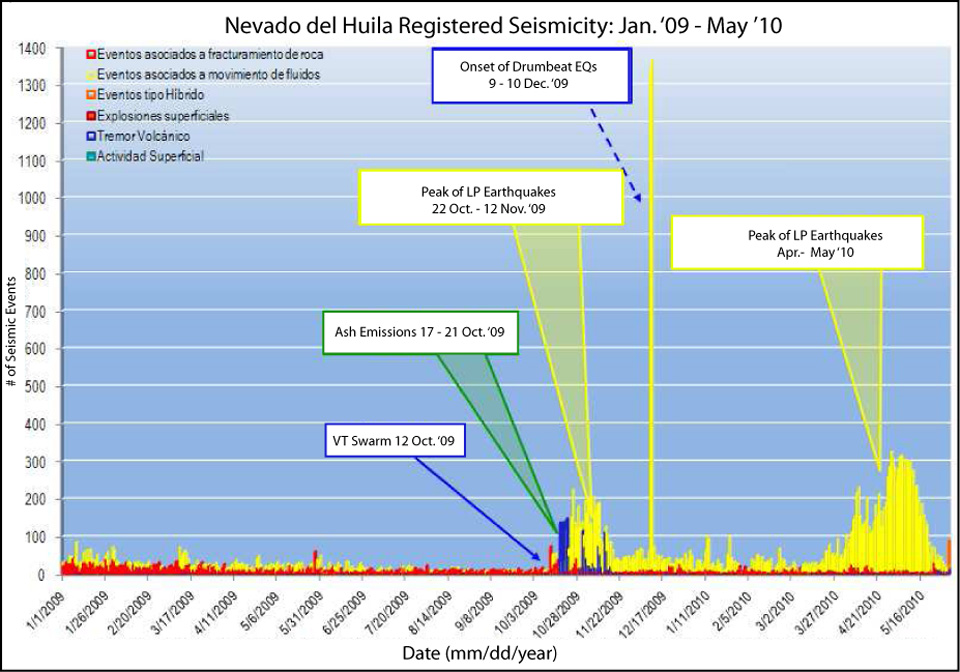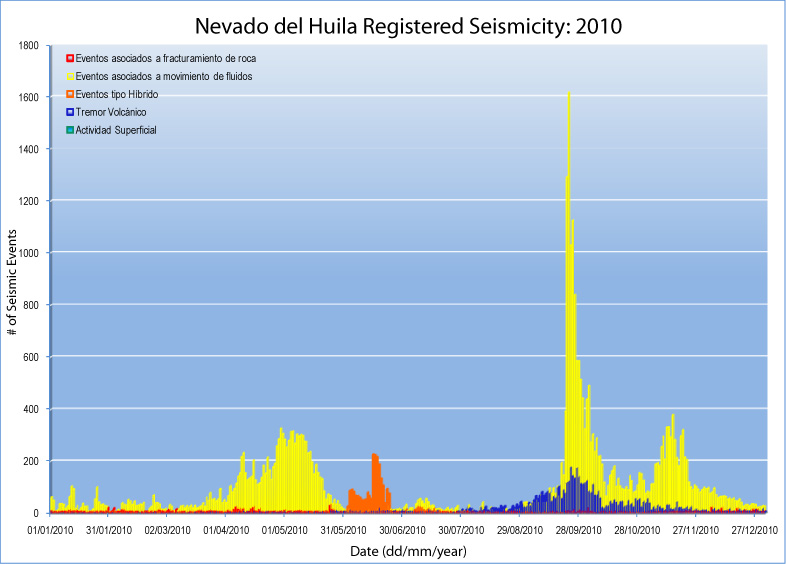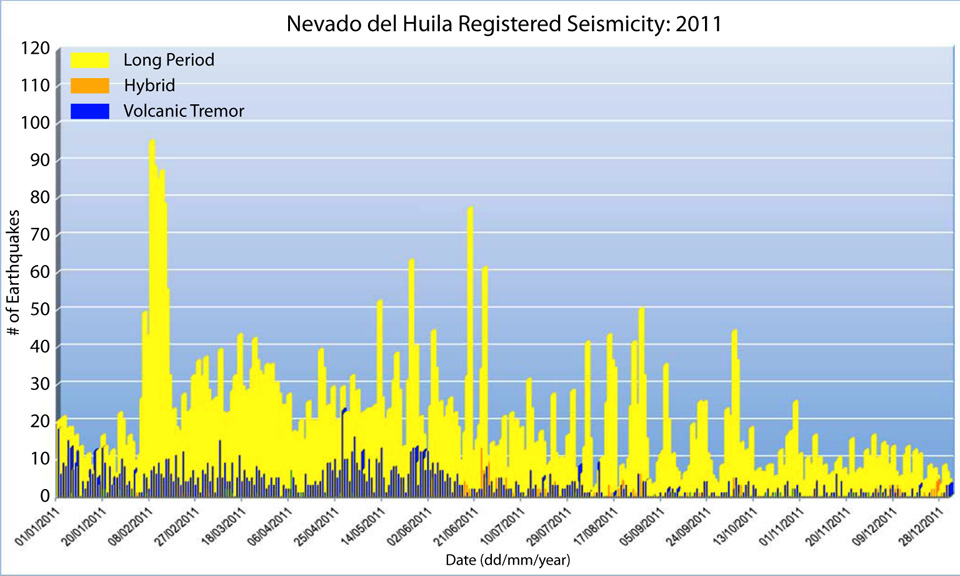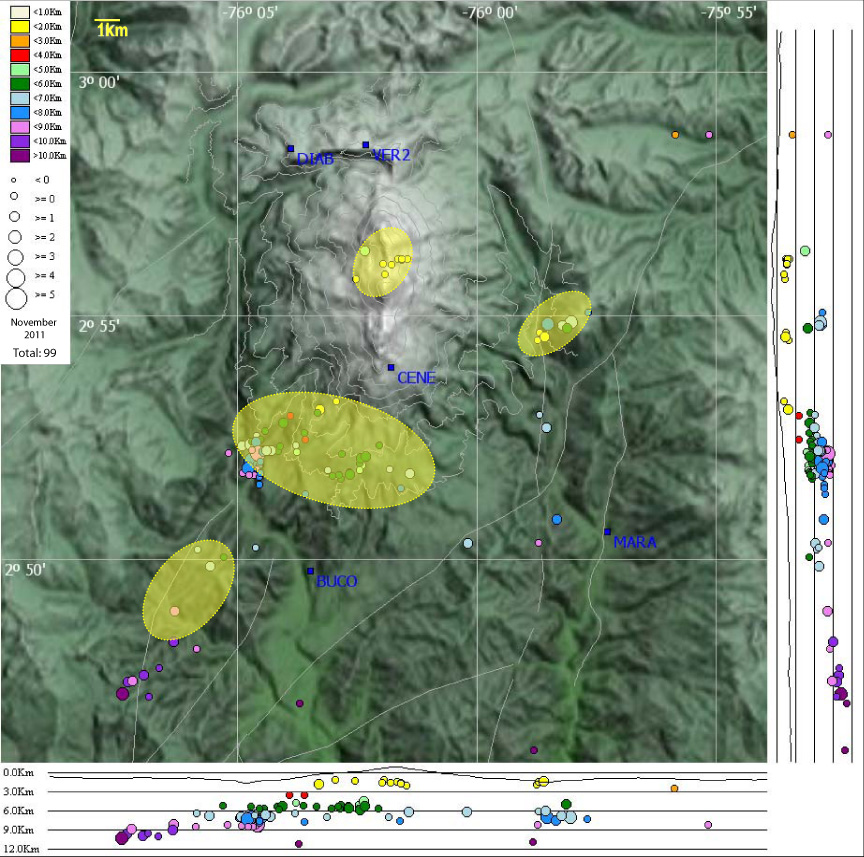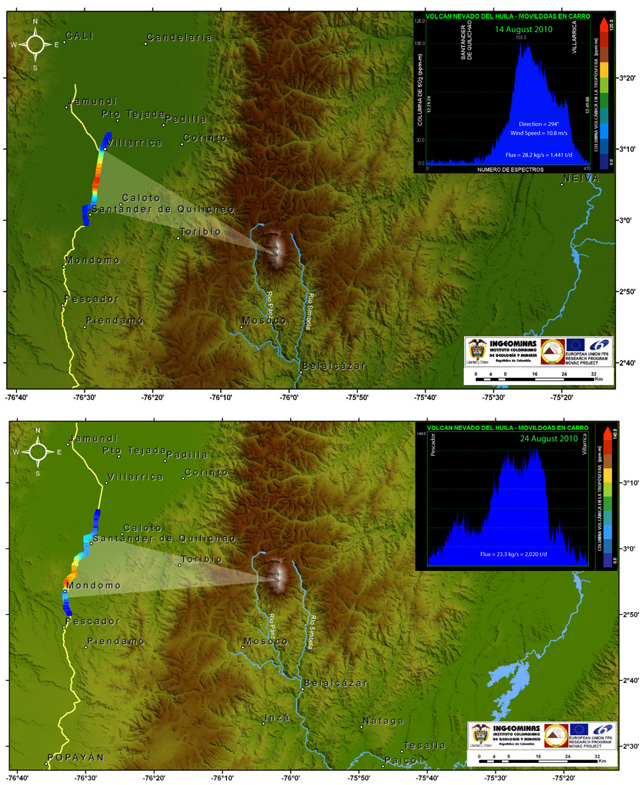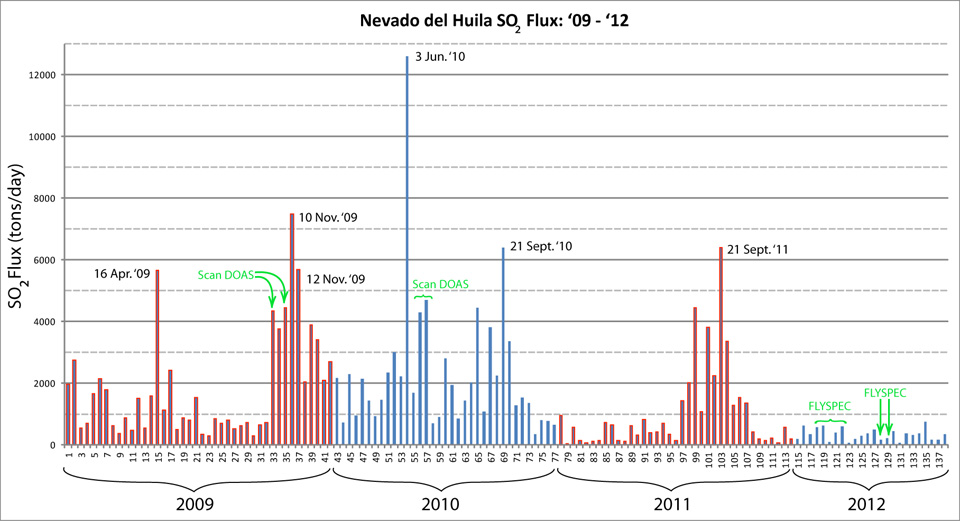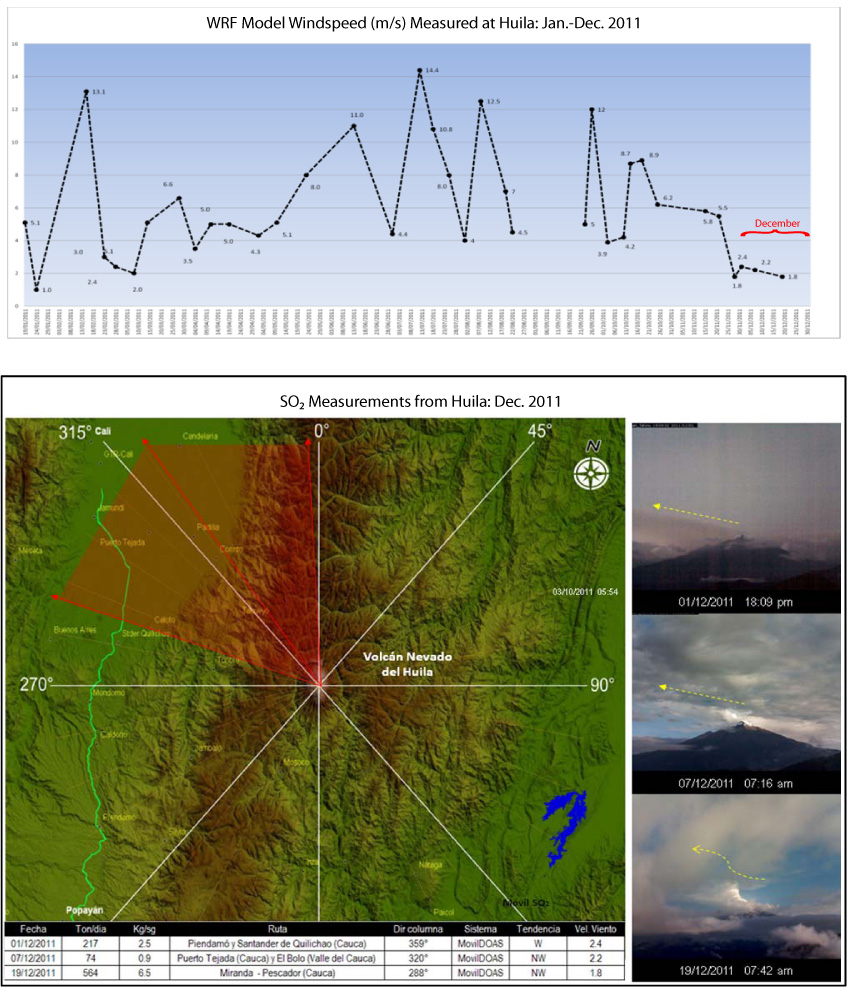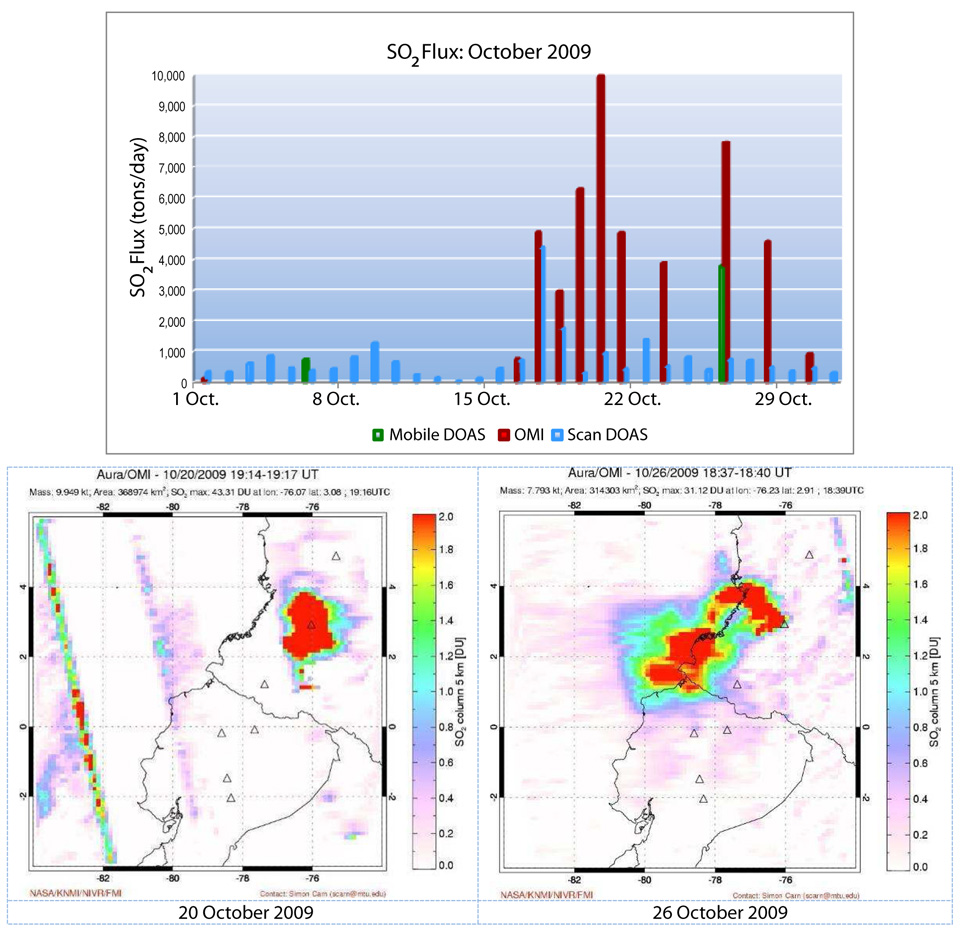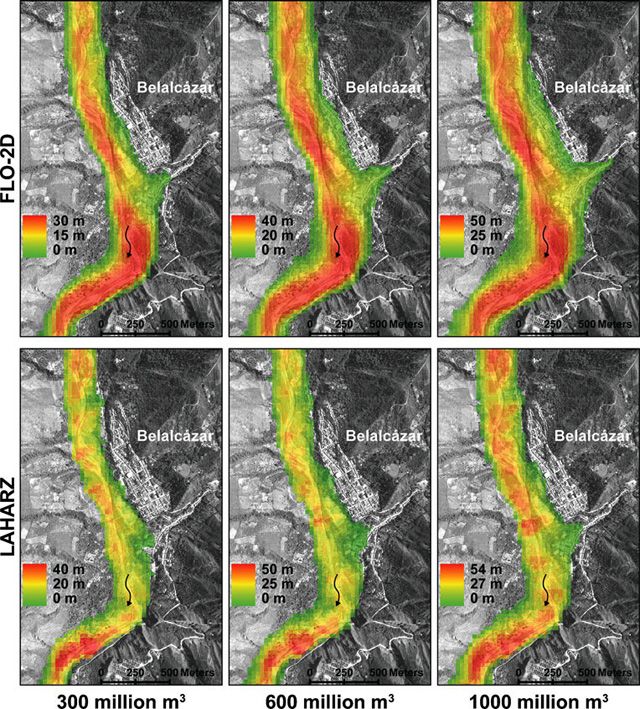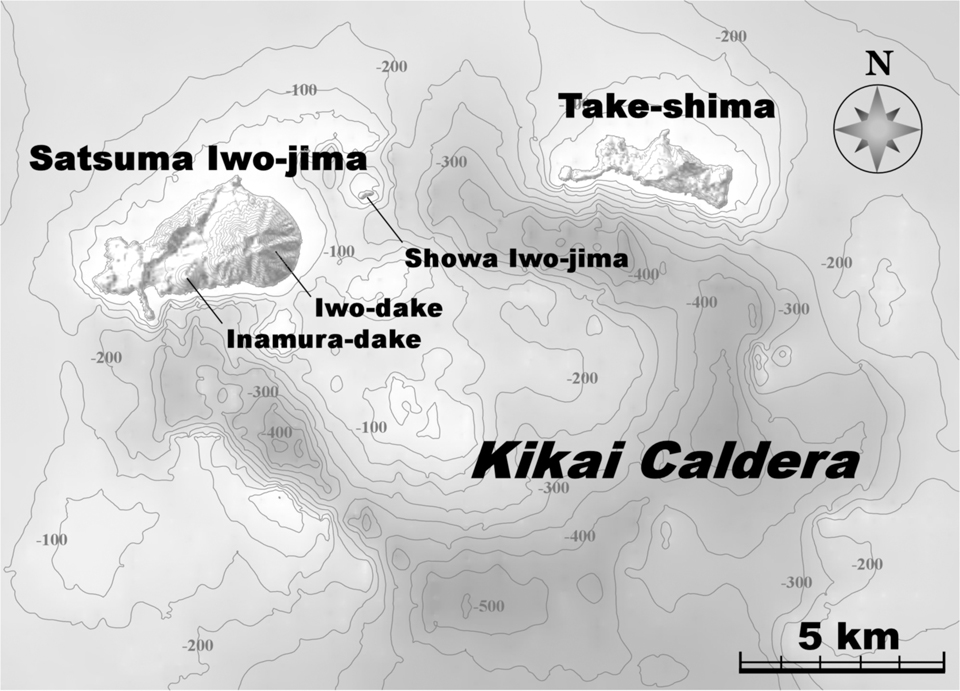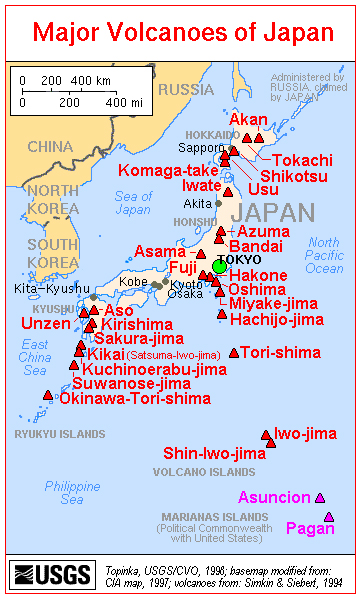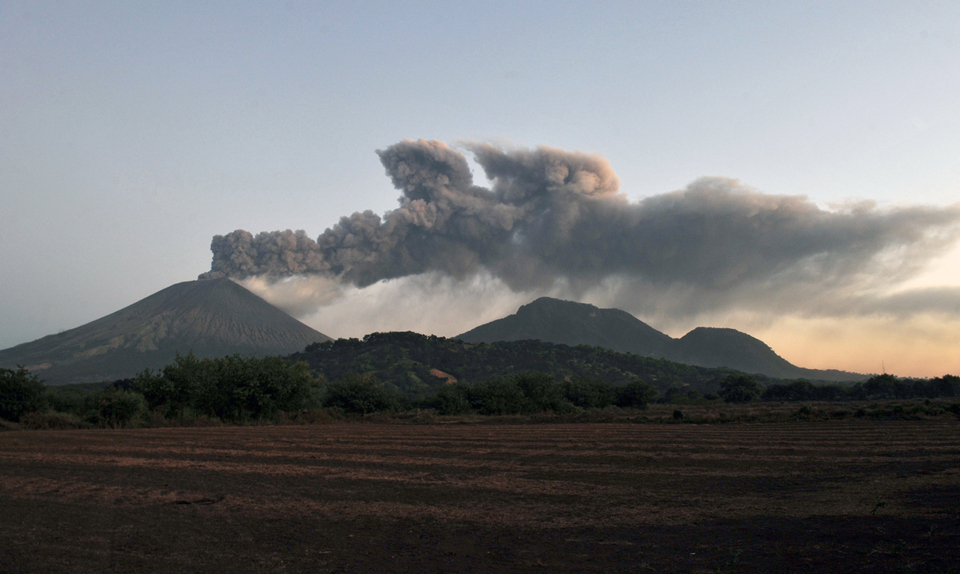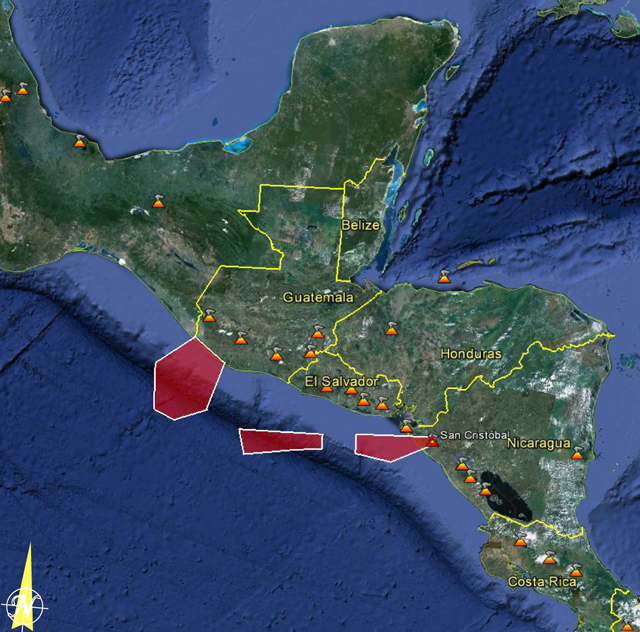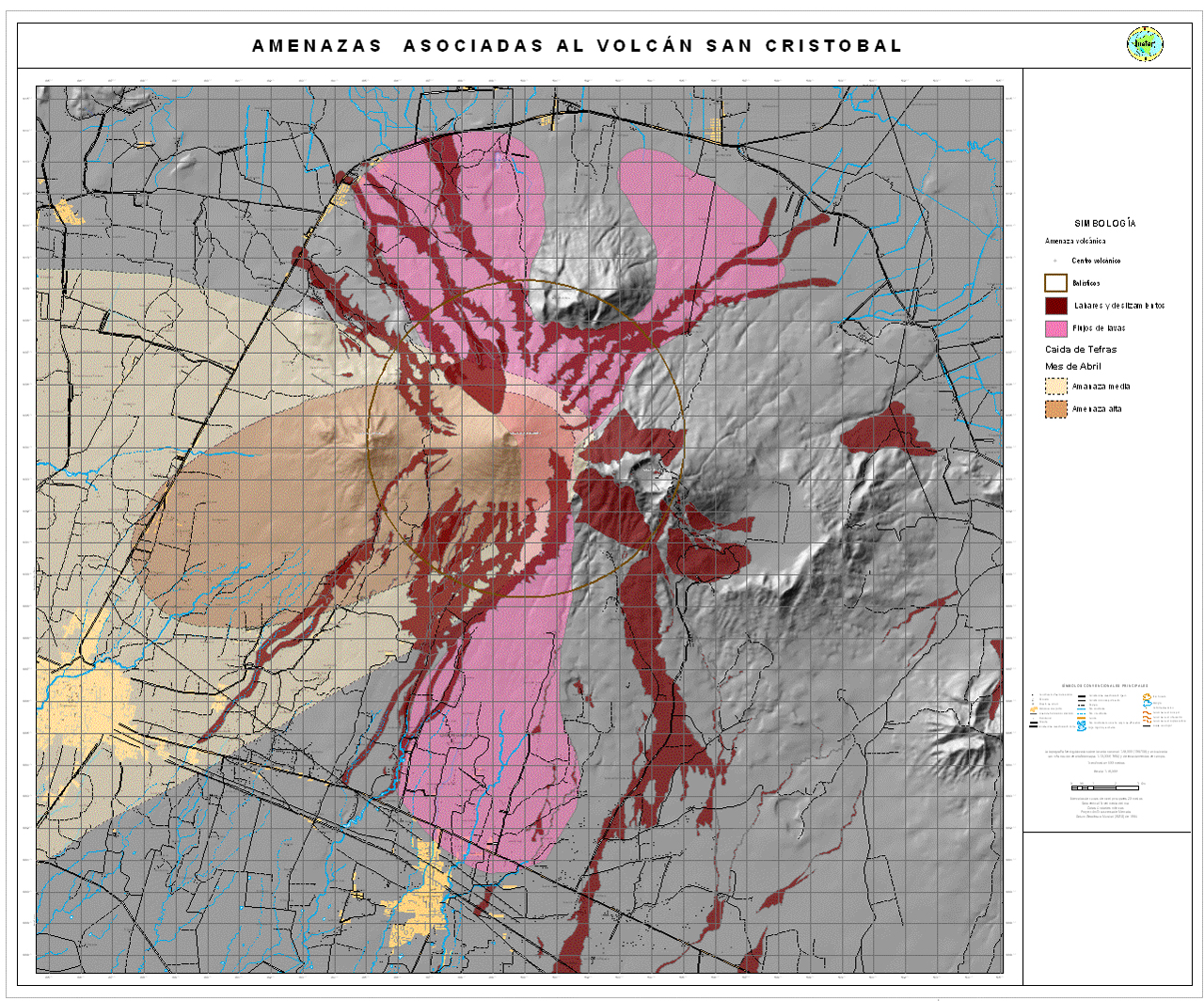Recently Published Bulletin Reports
Erebus (Antarctica) Lava lake remains active; most thermal alerts recorded since 2019
Rincon de la Vieja (Costa Rica) Frequent phreatic explosions during July-December 2023
Bezymianny (Russia) Explosion on 18 October 2023 sends ash plume 8 km high; lava flows and incandescent avalanches
Kilauea (United States) Low-level lava effusions in the lava lake at Halema’uma’u during July-December 2022
Nyamulagira (DR Congo) Lava flows and thermal activity during May-October 2023
Bagana (Papua New Guinea) Explosions, ash plumes, ashfall, and lava flows during April-September 2023
Mayon (Philippines) Lava flows, pyroclastic flows, ash emissions, and seismicity during April-September 2023
Nishinoshima (Japan) Eruption plumes and gas-and-steam plumes during May-August 2023
Krakatau (Indonesia) White gas-and-steam plumes and occasional ash plumes during May-August 2023
Merapi (Indonesia) Frequent incandescent avalanches during April-September 2023
Villarrica (Chile) Strombolian activity, gas-and-ash emissions, and crater incandescence during April-September 2023
Ebeko (Russia) Moderate explosive activity with ash plumes continued during June-November 2023
Erebus (Antarctica) — January 2024  Cite this Report
Cite this Report
Erebus
Antarctica
77.53°S, 167.17°E; summit elev. 3794 m
All times are local (unless otherwise noted)
Lava lake remains active; most thermal alerts recorded since 2019
The lava lake in the summit crater of Erebus has been active since at least 1972. Located in Antarctica overlooking the McMurdo Station on Ross Island, it is the southernmost active volcano on the planet. Because of the remote location, activity is primarily monitored by satellites. This report covers activity during 2023.
The number of thermal alerts recorded by the Hawai'i Institute of Geophysics and Planetology’s MODVOLC Thermal Alerts System increased considerably in 2023 compared to the years 2020-2022 (table 9). In contrast to previous years, the MODIS instruments aboard the Aqua and Terra satellites captured data from Erebus every month during 2023. Consistent with previous years, the lowest number of anomalous pixels were recorded in January, November, and December.
Table 9. Number of monthly MODIS-MODVOLC thermal alert pixels recorded at Erebus during 2017-2023. See BGVN 42:06 for data from 2000 through 2016. The table was compiled using data provided by the HIGP – MODVOLC Thermal Alerts System.
| Year |
Jan |
Feb |
Mar |
Apr |
May |
Jun |
Jul |
Aug |
Sep |
Oct |
Nov |
Dec |
SUM |
| 2017 |
0 |
21 |
9 |
0 |
0 |
1 |
11 |
61 |
76 |
52 |
0 |
3 |
234 |
| 2018 |
0 |
21 |
58 |
182 |
55 |
17 |
137 |
172 |
103 |
29 |
0 |
0 |
774 |
| 2019 |
2 |
21 |
162 |
151 |
55 |
56 |
75 |
53 |
29 |
19 |
1 |
0 |
624 |
| 2020 |
0 |
2 |
16 |
18 |
4 |
4 |
1 |
3 |
18 |
3 |
1 |
6 |
76 |
| 2021 |
0 |
9 |
1 |
0 |
2 |
56 |
46 |
47 |
35 |
52 |
5 |
3 |
256 |
| 2022 |
1 |
13 |
55 |
22 |
15 |
32 |
39 |
19 |
31 |
11 |
0 |
0 |
238 |
| 2023 |
2 |
33 |
49 |
82 |
41 |
32 |
70 |
64 |
42 |
17 |
5 |
11 |
448 |
Sentinel-2 infrared images showed one or two prominent heat sources within the summit crater, accompanied by adjacent smaller sources, similar to recent years (see BGVN 46:01, 47:02, and 48:01). A unique image was obtained on 25 November 2023 by the OLI-2 (Operational Land Imager-2) on Landsat 9, showing the upper part of the volcano surrounded by clouds (figure 32).
Geologic Background. Mount Erebus, the world's southernmost historically active volcano, overlooks the McMurdo research station on Ross Island. It is the largest of three major volcanoes forming the crudely triangular Ross Island. The summit of the dominantly phonolitic volcano has been modified by one or two generations of caldera formation. A summit plateau at about 3,200 m elevation marks the rim of the youngest caldera, which formed during the late-Pleistocene and within which the modern cone was constructed. An elliptical 500 x 600 m wide, 110-m-deep crater truncates the summit and contains an active lava lake within a 250-m-wide, 100-m-deep inner crater; other lava lakes are sometimes present. The glacier-covered volcano was erupting when first sighted by Captain James Ross in 1841. Continuous lava-lake activity with minor explosions, punctuated by occasional larger Strombolian explosions that eject bombs onto the crater rim, has been documented since 1972, but has probably been occurring for much of the volcano's recent history.
Information Contacts: Hawai'i Institute of Geophysics and Planetology (HIGP) - MODVOLC Thermal Alerts System, School of Ocean and Earth Science and Technology (SOEST), Univ. of Hawai'i, 2525 Correa Road, Honolulu, HI 96822, USA (URL: http://modis.higp.hawaii.edu/); Copernicus Browser, Copernicus Data Space Ecosystem, European Space Agency (URL: https://dataspace.copernicus.eu/browser/); NASA Earth Observatory, EOS Project Science Office, NASA Goddard Space Flight Center, Goddard, Maryland, USA (URL: https://earthobservatory.nasa.gov/images/152134/erebus-breaks-through).
Rincon de la Vieja (Costa Rica) — January 2024  Cite this Report
Cite this Report
Rincon de la Vieja
Costa Rica
10.83°N, 85.324°W; summit elev. 1916 m
All times are local (unless otherwise noted)
Frequent phreatic explosions during July-December 2023
Rincón de la Vieja is a volcanic complex in Costa Rica with a hot convecting acid lake that exhibits frequent weak phreatic explosions, gas-and-steam emissions, and occasional elevated sulfur dioxide levels (BGVN 45:10, 46:03, 46:11). The current eruption period began June 2021. This report covers activity during July-December 2023 and is based on weekly bulletins and occasional daily reports from the Observatorio Vulcanologico Sismologica de Costa Rica-Universidad Nacional (OVSICORI-UNA).
Numerous weak phreatic explosions continued during July-December 2023, along with gas-and-steam emissions and plumes that rose as high as 3 km above the crater rim. Many weekly OVSICORI-UNA bulletins included the previous week's number of explosions and emissions (table 9). For many explosions, the time of explosion was given (table 10). Frequent seismic activity (long-period earthquakes, volcano-tectonic earthquakes, and tremor) accompanied the phreatic activity.
Table 9. Number of reported weekly phreatic explosions and gas-and-steam emissions at Rincón de la Vieja, July-December 2023. Counts are reported for the week before the Weekly Bulletin date; not all reports included these data. Courtesy of OVSICORI-UNA.
| OVSICORI Weekly Bulletin |
Number of explosions |
Number of emissions |
| 28 Jul 2023 |
6 |
14 |
| 4 Aug 2023 |
10 |
12 |
| 1 Sep 2023 |
13 |
11 |
| 22 Sep 2023 |
12 |
13 |
| 29 Sep 2023 |
6 |
11 |
| 6 Oct 2023 |
12 |
5 |
| 13 Oct 2023 |
7 |
9 |
| 20 Oct 2023 |
1 |
15 |
| 27 Oct 2023 |
3 |
23 |
| 3 Nov 2023 |
3 |
10 |
| 17 Nov 2023 |
0 |
Some |
| 24 Nov 2023 |
0 |
14 |
| 8 Dec 2023 |
4 |
16 |
| 22 Dec 2023 |
8 |
18 |
Table 10. Summary of activity at Rincón de la Vieja during July-December 2023. Weak phreatic explosions and gas emissions are noted where the time of explosion was indicated in the weekly or daily bulletins. Height of plumes or emissions are distance above the crater rim. Courtesy of OVSICORI-UNA.
| Date |
Time |
Description of Activity |
| 1 Jul 2023 |
0156 |
Explosion. |
| 2 Jul 2023 |
0305 |
Explosion. |
| 4 Jul 2023 |
0229, 0635 |
Event at 0635 produced a gas-and-steam plume that rose 700 m and drifted W; seen by residents in Liberia (21 km SW). |
| 9 Jul 2023 |
1843 |
Explosion. |
| 21 Jul 2023 |
0705 |
Explosion. |
| 26 Jul 2023 |
1807 |
Explosion. |
| 28 Jul 2023 |
0802 |
Explosion generated a gas-and-steam plume that rose 500 m. |
| 30 Jul 2023 |
1250 |
Explosion. |
| 31 Jul 2023 |
2136 |
Explosion. |
| 11 Aug 2023 |
0828 |
Explosion. |
| 18 Aug 2023 |
1304 |
Explosion. |
| 21 Aug 2023 |
1224 |
Explosion generated gas-and-steam plumes rose 500-600 m. |
| 22 Aug 2023 |
0749 |
Explosion generated gas-and-steam plumes rose 500-600 m. |
| 24 Aug 2023 |
1900 |
Explosion. |
| 25 Aug 2023 |
0828 |
Event produced a steam-and-gas plume that rose 3 km and drifted NW. |
| 27-28 Aug 2023 |
0813 |
Four small events; the event at 0813 on 28 August lasted two minutes and generated a steam-and-gas plume that rose 2.5 km. |
| 1 Sep 2023 |
1526 |
Explosion generated plume that rose 2 km and ejected material onto the flanks. |
| 2-3 Sep 2023 |
- |
Small explosions detected in infrasound data. |
| 4 Sep 2023 |
1251 |
Gas-and-steam plume rose 1 km and drifted W. |
| 7 Nov 2023 |
1113 |
Explosion. |
| 8 Nov 2023 |
0722 |
Explosion. |
| 12 Nov 2023 |
0136 |
Small gas emissions. |
| 14 Nov 2023 |
0415 |
Small gas emissions. |
According to OVSICORI-UNA, during July-October the average weekly sulfur dioxide (SO2) flux ranged from 68 to 240 tonnes/day. However, in mid-November the flux increased to as high as 334 tonnes/day, the highest value measured in recent years. The high SO2 flux in mid-November was also detected by the TROPOMI instrument on the Sentinel-5P satellite (figure 43).
Geologic Background. Rincón de la Vieja, the largest volcano in NW Costa Rica, is a remote volcanic complex in the Guanacaste Range. The volcano consists of an elongated, arcuate NW-SE-trending ridge constructed within the 15-km-wide early Pleistocene Guachipelín caldera, whose rim is exposed on the south side. Sometimes known as the "Colossus of Guanacaste," it has an estimated volume of 130 km3 and contains at least nine major eruptive centers. Activity has migrated to the SE, where the youngest-looking craters are located. The twin cone of Santa María volcano, the highest peak of the complex, is located at the eastern end of a smaller, 5-km-wide caldera and has a 500-m-wide crater. A Plinian eruption producing the 0.25 km3 Río Blanca tephra about 3,500 years ago was the last major magmatic eruption. All subsequent eruptions, including numerous historical eruptions possibly dating back to the 16th century, have been from the prominent active crater containing a 500-m-wide acid lake located ENE of Von Seebach crater.
Information Contacts: Observatorio Vulcanológico Sismológica de Costa Rica-Universidad Nacional (OVSICORI-UNA), Apartado 86-3000, Heredia, Costa Rica (URL: http://www.ovsicori.una.ac.cr/); NASA Global Sulfur Dioxide Monitoring Page, Atmospheric Chemistry and Dynamics Laboratory, NASA Goddard Space Flight Center (NASA/GSFC), 8800 Greenbelt Road, Goddard MD 20771, USA (URL: https://so2.gsfc.nasa.gov/).
Bezymianny (Russia) — November 2023  Cite this Report
Cite this Report
Bezymianny
Russia
55.972°N, 160.595°E; summit elev. 2882 m
All times are local (unless otherwise noted)
Explosion on 18 October 2023 sends ash plume 8 km high; lava flows and incandescent avalanches
Bezymianny, located on Russia’s Kamchatka Peninsula, has had eruptions since 1955 characterized by dome growth, explosions, pyroclastic flows, ash plumes, and ashfall. Activity during November 2022-April 2023 included gas-and-steam emissions, lava dome collapses generating avalanches, and persistent thermal activity. Similar eruptive activity continued from May through October 2023, described here based on information from weekly and daily reports of the Kamchatka Volcano Eruptions Response Team (KVERT), notices from Tokyo VAAC (Volcanic Ash Advisory Center), and from satellite data.
Overall activity decreased after the strong period of activity in late March through April 2023, which included ash explosions during 29 March and 7-8 April 2023 that sent plumes as high as 10-12 km altitude, along with dome growth and lava flows (BGVN 48:05). This reduced activity can be seen in the MIROVA thermal detection system graph (figure 56), which was consistent with data from the MODVOLC thermal detection system and with Sentinel-2 satellite images that showed persistent hotspots in the summit crater when conditions allowed observations. A renewed period of strong activity began in mid-October 2023.
Activity increased significantly on 17 October 2023 when large collapses began during 0700-0830 on the E flanks of the lava dome and continued to after 0930 the next day (figure 57). Ash plumes rose to an altitude of 4.5-5 km, extending 220 km NNE by 18 October. A large explosion at 1630 on 18 October produced an ash plume that rose to an altitude of 11 km (8 km above the summit) and drifted NNE and then NW, extending 900 km NW within two days at an altitude of 8 km. Minor ashfall was noted in Kozyrevsk (45 km WNW). At 0820 on 20 October an ash plume was identified in satellite images drifting 100 km ENE at altitudes of 4-4.5 km.
Lava flows and hot avalanches from the dome down the SE flank continued over the next few days, including 23 October when clear conditions allowed good observations (figures 58 and 59). A large thermal anomaly was observed over the volcano through 24 October, and in the summit crater on 30 October (figure 60). Strong fumarolic activity continued, with numerous avalanches and occasional incandescence. By the last week of October, volcanic activity had decreased to a level consistent with that earlier in the reporting period.
Aviation warnings were frequently updated during 17-20 October. KVERT issued a Volcano Observatory Notice for Aviation (VONA) on 17 October at 1419 and 1727 (0219 and 0527 UTC) raising the Aviation Color Code (ACC) from Yellow to Orange (second highest level). The next day, KVERT issued a VONA at 1705 (0505 UTC) raising the ACC to Red (highest level) but lowered it back to Orange at 2117 (0917 UTC). After another decrease to Yellow and back to Orange, the ACC was reduced to Yellow on 20 October at 1204 (0004 UTC). In addition, the Tokyo VAAC issued a series of Volcanic Ash Advisories beginning on 16 October and continuing through 30 October.
Geologic Background. The modern Bezymianny, much smaller than its massive neighbors Kamen and Kliuchevskoi on the Kamchatka Peninsula, was formed about 4,700 years ago over a late-Pleistocene lava-dome complex and an edifice built about 11,000-7,000 years ago. Three periods of intensified activity have occurred during the past 3,000 years. The latest period, which was preceded by a 1,000-year quiescence, began with the dramatic 1955-56 eruption. This eruption, similar to that of St. Helens in 1980, produced a large open crater that was formed by collapse of the summit and an associated lateral blast. Subsequent episodic but ongoing lava-dome growth, accompanied by intermittent explosive activity and pyroclastic flows, has largely filled the 1956 crater.
Information Contacts: Kamchatka Volcanic Eruptions Response Team (KVERT), Far Eastern Branch, Russian Academy of Sciences, 9 Piip Blvd., Petropavlovsk-Kamchatsky, 683006, Russia (URL: http://www.kscnet.ru/ivs/kvert/); Kamchatka Volcanological Station, Kamchatka Branch of Geophysical Survey, (KB GS RAS), Klyuchi, Kamchatka Krai, Russia (URL: http://volkstat.ru/); Tokyo Volcanic Ash Advisory Center (VAAC), 1-3-4 Otemachi, Chiyoda-ku, Tokyo 100-8122, Japan (URL: http://ds.data.jma.go.jp/svd/vaac/data/); Hawai'i Institute of Geophysics and Planetology (HIGP) - MODVOLC Thermal Alerts System, School of Ocean and Earth Science and Technology (SOEST), Univ. of Hawai'i, 2525 Correa Road, Honolulu, HI 96822, USA (URL: http://modis.higp.hawaii.edu/); MIROVA (Middle InfraRed Observation of Volcanic Activity), a collaborative project between the Universities of Turin and Florence (Italy) supported by the Centre for Volcanic Risk of the Italian Civil Protection Department (URL: http://www.mirovaweb.it/); Copernicus Browser, Copernicus Data Space Ecosystem, European Space Agency (URL: https://dataspace.copernicus.eu/browser/).chr
Kilauea (United States) — January 2023  Cite this Report
Cite this Report
Kilauea
United States
19.421°N, 155.287°W; summit elev. 1222 m
All times are local (unless otherwise noted)
Low-level lava effusions in the lava lake at Halema’uma’u during July-December 2022
Kīlauea is the southeastern-most volcano in Hawaii and overlaps the E flank of the Mauna Loa volcano. Its East Rift Zone (ERZ) has been intermittently active for at least 2,000 years. An extended eruption period began in January 1983 and was characterized by open lava lakes and lava flows from the summit caldera and the East Rift Zone. During May 2018 magma migrated into the Lower East Rift Zone (LERZ) and opened 24 fissures along a 6-km-long NE-trending fracture zone that produced lava flows traveling in multiple directions. As lava emerged from the fissures, the lava lake at Halema'uma'u drained and explosions sent ash plumes to several kilometers altitude (BGVN 43:10).
The current eruption period started during September 2021 and has recently been characterized by lava effusions, spatter, and sulfur dioxide emissions in the active Halema’uma’u lava lake (BGVN 47:08). Lava effusions, some spatter, and sulfur dioxide emissions have continued during this reporting period of July through December 2022 using daily reports, volcanic activity notices, and abundant photo, map, and video data from the US Geological Survey's (USGS) Hawaiian Volcano Observatory (HVO).
Summary of activity during July-December 2022. Low-level effusions have continued at the western vent of the Halema’uma’u crater during July through early December 2022. Occasional weak ooze-outs (also called lava break outs) would occur along the margins of the crater floor. The overall level of the active lava lake throughout the reporting period gradually increased due to infilling, however it stagnated in mid-September (table 13). During September through November, activity began to decline, though lava effusions persisted at the western vent. By 9 December, the active part of the lava lake had completely crusted over, and incandescence was no longer visible.
Table 13. Summary of measurements taken during overflights at Kīlauea that show a gradual increase in the active lava lake level and the volume of lava effused since 29 September 2021. Lower activity was reported during September-October. Data collected during July-December 2022. Courtesy of HVO.
| Date: |
Level of the active lava lake (m): |
Cumulative volume of lava effused (million cubic meters): |
| 7 Jul 2022 |
130 |
95 |
| 19 Jul 2022 |
133 |
98 |
| 4 Aug 2022 |
136 |
102 |
| 16 Aug 2022 |
137 |
104 |
| 12 Sep 2022 |
143 |
111 |
| 5 Oct 2022 |
143 |
111 |
| 28 Oct 2022 |
143 |
111 |
Activity during July 2022. Lava effusions were reported from the western vent in the Halema’uma’u crater, along with occasional weak ooze-outs along the margins of the crater floor. The height of the lava lake was variable due to deflation-inflation tilt events; for example, the lake level dropped approximately 3-4 m during a summit deflation-inflation event reported on 1 July. Webcam images taken during the night of 6-12 July showed intermittent low-level spattering at the western vent that rose less than 10 m above the vent (figure 519). Measurements made during an overflight on 7 July indicated that the crater floor was infilled about 130 m and that 95 million cubic meters of lava had been effused since 29 September 2021. A single, relatively small lava ooze-out was active to the S of the lava lake. Around midnight on 8 July there were two brief periods of lava overflow onto the lake margins. On 9 July lava ooze-outs were reported near the SE and NE edges of the crater floor and during 10-11 July they occurred near the E, NE, and NW edges. On 16 July crater incandescence was reported, though the ooze-outs and spattering were not visible. On 18 July overnight webcam images showed incandescence in the western vent complex and two ooze-outs were reported around 0000 and 0200 on 19 July. By 0900 there were active ooze-outs along the SW edge of the crater floor. Measurements made from an overflight on 19 July indicated that the crater floor was infilled about 133 m and 98 million cubic meters of lava had erupted since 29 September 2021 (figure 520). On 20 July around 1600 active ooze-outs were visible along the N edge of the crater, which continued through the next day. Extensive ooze-outs occurred along the W margin during 24 July until 1900; on 26 July minor ooze-outs were noted along the N margin. Minor spattering was visible on 29 July along the E margin of the lake. The sulfur dioxide emission rates ranged 650-2,800 tons per day (t/d), the higher of which was measured on 8 July (figure 519).
Activity during August 2022. The eruption continued in the Halema’uma’u crater at the western vent. According to HVO the lava in the active lake remained at the level of the bounding levees. Occasional minor ooze-outs were observed along the margins of the crater floor. Strong nighttime crater incandescence was visible after midnight on 6 August over the western vent cone. During 6-7 August scattered small lava lobes were active along the crater floor and incandescence persisted above the western vent through 9 August. During 7-9 August HVO reported a single lava effusion source was active along the NW margin of the crater floor. Measurements from an overflight on 4 August indicated that the crater floor was infilled about 136 m total and that 102 million cubic meters of lava had been erupted since the start of the eruption. Lava breakouts were reported along the N, NE, E, S, and W margins of the crater during 10-16 August. Another overflight survey conducted on 16 August indicated that the crater floor infilled about 137 m and 104 million cubic meters of lava had been erupted since September 2021. Measured sulfur dioxide emissions rates ranged 1,150-2,450 t/d, the higher of which occurred on 8 August.
Activity during September 2022. During September, lava effusion continued from the western vent into the active lava lake and onto the crater floor. Intermittent minor ooze-outs were reported through the month. A small ooze-out was visible on the W crater floor margin at 0220 on 2 September, which showed decreasing surface activity throughout the day, but remained active through 3 September. On 3 September around 1900 a lava outbreak occurred along the NW margin of the crater floor but had stopped by the evening of 4 September. Field crews monitoring the summit lava lake on 9 September observed spattering on the NE margin of the lake that rose no higher than 10 m, before falling back onto the lava lake crust (figure 521). Overflight measurements on 12 September indicated that the crater floor was infilled a total of 143 m and 111 million cubic meters of lava had been erupted since September 2021. Extensive breakouts in the W and N part of the crater floor were reported at 1600 on 20 September and continued into 26 September. The active part of the lava lake dropped by 10 m while other parts of the crater floor dropped by several meters. Summit tiltmeters recorded a summit seismic swarm of more than 80 earthquakes during 1500-1800 on 21 September, which occurred about 1.5 km below Halema’uma’u; a majority of these were less than Mw 2. By 22 September the active part of the lava lake was infilled about 2 m. On 23 September the western vent areas exhibited several small spatter cones with incandescent openings, along with weak, sporadic spattering (figure 522). The sulfur dioxide emission rate ranged from 930 t/d to 2,000 t/d, the higher of which was measured on 6 September.
Activity during October 2022. Activity during October declined slightly compared to previous months, though lava effusions persisted from the western vent into the active lava lake and onto the crater floor during October (figure 523). Slight variations in the lava lake were noted throughout the month. HVO reported that around 0600 on 3 October the level of the lava lake has lowered slightly. Overflight measurements taken on 5 October indicated that the crater floor was infilled a total of about 143 m and that 111 million cubic meters of lava had been effused since September 2021. During 6-7 October the lake gradually rose 0.5 m. Sulfur dioxide measurements made on 22 October had an emission rate of 700 t/d. Another overflight taken on 28 October showed that there was little to no change in the elevation of the crater floor: the crater floor was infilled a total of 143 m and 111 million cubic meters of lava had erupted since the start of the eruption.
Activity during November 2022. Activity remained low during November, though HVO reported that lava from the western vent continued to effuse into the active lava lake and onto the crater floor throughout the month. The rate of sulfur dioxide emissions during November ranged from 300-600 t/d, the higher amount of which occurred on 9 November.
Activity during December 2022. Similar low activity was reported during December, with lava effusing from the western vent into the active lava lake and onto the crater floor. During 4-5 December the active part of the lava lake was slightly variable in elevation and fluctuated within 1 m. On 9 December HVO reported that lava was no longer erupting from the western vent in the Halema’uma’u crater and that sulfur dioxide emissions had returned to near pre-eruption background levels; during 10-11 December, the lava lake had completely crusted over, and no incandescence was visible (figure 524). Time lapse camera images covering the 4-10 December showed that the crater floor showed weak deflation and no inflation. Some passive events of crustal overturning were reported during 14-15 December, which brought fresh incandescent lava to the lake surface. The sulfur dioxide emission rate was approximately 200 t/d on 14 December. A smaller overturn event on 17 December and another that occurred around 0000 and into the morning of 20 December were also detected. A small seismic swarm was later detected on 30 December.
Geologic Background. Kilauea overlaps the E flank of the massive Mauna Loa shield volcano in the island of Hawaii. Eruptions are prominent in Polynesian legends; written documentation since 1820 records frequent summit and flank lava flow eruptions interspersed with periods of long-term lava lake activity at Halemaumau crater in the summit caldera until 1924. The 3 x 5 km caldera was formed in several stages about 1,500 years ago and during the 18th century; eruptions have also originated from the lengthy East and Southwest rift zones, which extend to the ocean in both directions. About 90% of the surface of the basaltic shield volcano is formed of lava flows less than about 1,100 years old; 70% of the surface is younger than 600 years. The long-term eruption from the East rift zone between 1983 and 2018 produced lava flows covering more than 100 km2, destroyed hundreds of houses, and added new coastline.
Information Contacts: Hawaiian Volcano Observatory (HVO), U.S. Geological Survey, PO Box 51, Hawai'i National Park, HI 96718, USA (URL: http://hvo.wr.usgs.gov/).
Nyamulagira (DR Congo) — November 2023  Cite this Report
Cite this Report
Nyamulagira
DR Congo
1.408°S, 29.2°E; summit elev. 3058 m
All times are local (unless otherwise noted)
Lava flows and thermal activity during May-October 2023
Nyamulagira (also known as Nyamuragira) is a shield volcano in the Democratic Republic of Congo with the summit truncated by a small 2 x 2.3 km caldera with walls up to about 100 m high. Documented eruptions have occurred within the summit caldera, as well as from numerous flank fissures and cinder cones. The current eruption period began in April 2018 and has more recently been characterized by summit crater lava flows and thermal activity (BGVN 48:05). This report describes lava flows and variable thermal activity during May through October 2023, based on information from the Observatoire Volcanologique de Goma (OVG) and various satellite data.
Lava lake activity continued during May. The MIROVA (Middle InfraRed Observation of Volcanic Activity) system recorded moderate-to-strong thermal activity throughout the reporting period; activity was more intense during May and October and relatively weaker from June through September (figure 95). The MODVOLC thermal algorithm, detected a total of 209 thermal alerts. There were 143 hotspots detected during May, eight during June, nine during September, and 49 during October. This activity was also reflected in infrared satellite images, where a lava flow was visible in the NW part of the crater on 7 May and strong activity was seen in the center of the crater on 4 October (figure 96). Another infrared satellite image taken on 12 May showed still active lava flows along the NW margin of the crater. According to OVG lava effusions were active during 7-29 May and moved to the N and NW parts of the crater beginning on 9 May. Strong summit crater incandescence was visible from Goma (27 km S) during the nights of 17, 19, and 20 May (figure 97). On 17 May there was an increase in eruptive activity, which peaked at 0100 on 20 May. Notable sulfur dioxide plumes drifted NW and W during 19-20 May (figure 98). Drone footage acquired in partnership with the USGS (United States Geological Survey) on 20 May captured images of narrow lava flows that traveled about 100 m down the W flank (figure 99). Data from the Rumangabo seismic station indicated a decreasing trend in activity during 17-21 May. Although weather clouds prevented clear views of the summit, a strong thermal signature on the NW flank was visible in an infrared satellite image on 22 May, based on an infrared satellite image. On 28 May the lava flows on the upper W flank began to cool and solidify. By 29 May seismicity returned to levels similar to those recorded before the 17 May increase. Lava effusion continued but was confined to the summit crater; periodic crater incandescence was observed.
Low-level activity was noted during June through October. On 1 June OVG reported that seismicity remained at lower levels and that crater incandescence had been absent for three days, though infrared satellite imagery showed continued lava effusion in the summit crater. The lava flows on the flanks covered an estimated 0.6 km2. Satellite imagery continued to show thermal activity confined to the lava lake through October (figure 96), although no lava flows or significant sulfur dioxide emissions were reported.
Geologic Background. Africa's most active volcano, Nyamulagira (also known as Nyamuragira), is a massive high-potassium basaltic shield about 25 km N of Lake Kivu and 13 km NNW of the steep-sided Nyiragongo volcano. The summit is truncated by a small 2 x 2.3 km caldera that has walls up to about 100 m high. Documented eruptions have occurred within the summit caldera, as well as from the numerous flank fissures and cinder cones. A lava lake in the summit crater, active since at least 1921, drained in 1938, at the time of a major flank eruption. Recent lava flows extend down the flanks more than 30 km from the summit as far as Lake Kivu; extensive lava flows from this volcano have covered 1,500 km2 of the western branch of the East African Rift.
Information Contacts: Observatoire Volcanologique de Goma (OVG), Departement de Geophysique, Centre de Recherche en Sciences Naturelles, Lwiro, D.S. Bukavu, DR Congo; Hawai'i Institute of Geophysics and Planetology (HIGP) - MODVOLC Thermal Alerts System, School of Ocean and Earth Science and Technology (SOEST), Univ. of Hawai'i, 2525 Correa Road, Honolulu, HI 96822, USA (URL: http://modis.higp.hawaii.edu/); MIROVA (Middle InfraRed Observation of Volcanic Activity), a collaborative project between the Universities of Turin and Florence (Italy) supported by the Centre for Volcanic Risk of the Italian Civil Protection Department (URL: http://www.mirovaweb.it/); NASA Global Sulfur Dioxide Monitoring Page, Atmospheric Chemistry and Dynamics Laboratory, NASA Goddard Space Flight Center (NASA/GSFC), 8800 Greenbelt Road, Goddard, Maryland, USA (URL: https://so2.gsfc.nasa.gov/); Copernicus Browser, Copernicus Data Space Ecosystem, European Space Agency (URL: https://dataspace.copernicus.eu/browser/); Charles Balagizi, Goma Volcano Observatory, Departement de Geophysique, Centre de Recherche en Sciences Naturelles, Lwiro, D.S. Bukavu, DR Congo.
Bagana (Papua New Guinea) — October 2023  Cite this Report
Cite this Report
Bagana
Papua New Guinea
6.137°S, 155.196°E; summit elev. 1855 m
All times are local (unless otherwise noted)
Explosions, ash plumes, ashfall, and lava flows during April-September 2023
The remote volcano of Bagana is located in central Bougainville Island, Papua New Guinea. Recorded eruptions date back to 1842 and activity has consisted of effusive activity that has built a small lava dome in the summit crater and occasional explosions that produced pyroclastic flows. The most recent eruption has been ongoing since February 2000 and has produced occasional explosions, ash plumes, and lava flows. More recently, activity has been characterized by ongoing effusive activity and ash emissions (BGVN 48:04). This report updates activity from April through September 2023 that has consisted of explosions, ash plumes, ashfall, and lava flows, using information from the Darwin Volcanic Ash Advisory Center (VAAC) and satellite data.
An explosive eruption was reported on 7 July that generated a large gas-and-ash plume to high altitudes and caused significant ashfall in local communities; the eruption plume had reached upper tropospheric (16-18 km altitude) altitudes by 2200, according to satellite images. Sulfur dioxide plumes were detected in satellite images on 8 July and indicated that the plume was likely a mixture of gas, ice, and ash. A report issued by the Autonomous Bougainville Government (ABG) (Torokina District, Education Section) on 10 July noted that significant ash began falling during 2000-2100 on 7 July and covered most areas in the Vuakovi, Gotana (9 km SW), Koromaketo, Laruma (25 km W) and Atsilima (27 km NW) villages. Pyroclastic flows also occurred, according to ground-based reports; small deposits confined to one drainage were inspected by RVO during an overflight on 17 July and were confirmed to be from the 7 July event. Ashfall continued until 10 July and covered vegetation, which destroyed bushes and gardens and contaminated rivers and streams.
RVO reported another eruption on 14 July. The Darwin VAAC stated that an explosive event started around 0830 on 15 July and produced an ash plume that rose to 16.5 km altitude by 1000 and drifted N, according to satellite images. The plume continued to drift N and remained visible through 1900, and by 2150 it had dissipated.
Ashfall likely from both the 7 and 15 July events impacted about 8,111 people in Torokina (20 km SW), including Tsito/Vuakovi, Gotana, Koromaketo, Kenaia, Longkogari, Kenbaki, Piva (13 km SW), and Atsinima, and in the Tsitovi district, according to ABG. Significant ashfall was also reported in Ruruvu (22 km N) in the Wakunai District of Central Bougainville, though the thickness of these deposits could not be confirmed. An evacuation was called for the villages in Wakunai, where heavy ashfall had contaminated water sources; the communities of Ruruvu, Togarau, Kakarapaia, Karauturi, Atao, and Kuritaturi were asked to evacuate to a disaster center at the Wakunai District Station, and communities in Torokina were asked to evacuate to the Piva District station. According to a news article, more than 7,000 people needed temporary accommodations, with about 1,000 people in evacuation shelters. Ashfall had deposited over a broad area, contaminating water supplies, affecting crops, and collapsing some roofs and houses in rural areas. Schools were temporarily shut down. Intermittent ash emissions continued through the end of July and drifted NNW, NW, and SW. Fine ashfall was reported on the coast of Torokina, and ash plumes also drifted toward Laruma and Atsilima.
A small explosive eruption occurred at 2130 on 28 July that ejected material from the crater vents, according to reports from Torokina, in addition to a lava flow that contained two lobes. A second explosion was detected at 2157. Incandescence from the lava flow was visible from Piva as it descended the W flank around 2000 on 29 July (figure 47). The Darwin VAAC reported that a strong thermal anomaly was visible in satellite images during 30-31 July and that ash emissions rose to 2.4 km altitude and drifted WSW on 30 July. A ground report from RVO described localized emissions at 0900 on 31 July.
The Darwin VAAC reported that ash plumes were identified in satellite imagery at 0800 and 1220 on 12 August and rose to 2.1 km and 3 km altitude and drifted NW and W, respectively. A news report stated that aid was sent to more than 6,300 people that were adversely affected by the eruption. Photos taken during 17-19 August showed ash emissions rising no higher than 1 km above the summit and drifting SE. A small explosion generated an ash plume during the morning of 19 August. Deposits from small pyroclastic flows were also captured in the photos. Satellite images captured lava flows and pyroclastic flow deposits. Two temporary seismic stations were installed near Bagana on 17 August at distances of 7 km WSW (Vakovi station) and 11 km SW (Kepox station). The Kepox station immediately started to record continuous, low-frequency background seismicity.
Satellite data. Little to no thermal activity was detected during April through mid-July 2023; only one anomaly was recorded during early April and one during early June, according to MIROVA (Middle InfraRed Observation of Volcanic Activity) data (figure 48). Thermal activity increased in both power and frequency during mid-July through September, although there were still some short gaps in detected activity. MODVOLC also detected increased thermal activity during August; thermal hotspots were detected a total of five times on 19, 20, and 27 August. Weak thermal anomalies were also captured in infrared satellite images on clear weather days throughout the reporting period on 7, 12, and 17 April, 27 May, 1, 6, 16, and 31 July, and 19 September (figure 48); a strong thermal anomaly was visible on 31 July. Distinct sulfur dioxide plumes that drifted generally NW were intermittently captured by the TROPOMI instrument on the Sentinel-5P satellite and sometimes exceeded two Dobson Units (DUs) (figure 49).
Geologic Background. Bagana volcano, in a remote portion of central Bougainville Island, is frequently active. This massive symmetrical cone was largely constructed by an accumulation of viscous andesitic lava flows. The entire edifice could have been constructed in about 300 years at its present rate of lava production. Eruptive activity is characterized by non-explosive effusion of viscous lava that maintains a small lava dome in the summit crater, although occasional explosive activity produces pyroclastic flows. Lava flows with tongue-shaped lobes up to 50 m thick and prominent levees descend the flanks on all sides.
Information Contacts: Rabaul Volcano Observatory (RVO), Geohazards Management Division, Department of Mineral Policy and Geohazards Management (DMPGM), PO Box 3386, Kokopo, East New Britain Province, Papua New Guinea; Darwin Volcanic Ash Advisory Centre (VAAC), Bureau of Meteorology, Northern Territory Regional Office, PO Box 40050, Casuarina, NT 0811, Australia (URL: http://www.bom.gov.au/info/vaac/); MIROVA (Middle InfraRed Observation of Volcanic Activity), a collaborative project between the Universities of Turin and Florence (Italy) supported by the Centre for Volcanic Risk of the Italian Civil Protection Department (URL: http://www.mirovaweb.it/); Hawai'i Institute of Geophysics and Planetology (HIGP) - MODVOLC Thermal Alerts System, School of Ocean and Earth Science and Technology (SOEST), Univ. of Hawai'i, 2525 Correa Road, Honolulu, HI 96822, USA (URL: http://modis.higp.hawaii.edu/); NASA Global Sulfur Dioxide Monitoring Page, Atmospheric Chemistry and Dynamics Laboratory, NASA Goddard Space Flight Center (NASA/GSFC), 8800 Greenbelt Road, Goddard, Maryland, USA (URL: https://so2.gsfc.nasa.gov/); Copernicus Browser, Copernicus Data Space Ecosystem, European Space Agency (URL: https://dataspace.copernicus.eu/browser/); Autonomous Bougainville Government, P.O Box 322, Buka, AROB, PNG (URL: https://abg.gov.pg/); Andrew Tupper (Twitter: @andrewcraigtupp); Simon Carn, Geological and Mining Engineering and Sciences, Michigan Technological University, 1400 Townsend Drive, Houghton, MI 49931, USA (URL: http://www.volcarno.com/, Twitter: @simoncarn); Radio NZ (URL: https://www.rnz.co.nz/news/pacific/494464/more-than-7-000-people-in-bougainville-need-temporary-accommodation-after-eruption); USAID, 1300 Pennsylvania Ave, NW, Washington DC 20004, USA (URL: https://www.usaid.gov/pacific-islands/press-releases/aug-08-2023-united-states-provides-immediate-emergency-assistance-support-communities-affected-mount-bagana-volcanic-eruptions).
Mayon (Philippines) — October 2023  Cite this Report
Cite this Report
Mayon
Philippines
13.257°N, 123.685°E; summit elev. 2462 m
All times are local (unless otherwise noted)
Lava flows, pyroclastic flows, ash emissions, and seismicity during April-September 2023
Mayon is located in the Philippines and has steep upper slopes capped by a small summit crater. Historical eruptions date back to 1616 CE that have been characterized by Strombolian eruptions, lava flows, pyroclastic flows, and mudflows. Eruptions mostly originated from a central conduit. Pyroclastic flows and mudflows have commonly descended many of the approximately 40 drainages that surround the volcano. The most recent eruption occurred during June through October 2022 and consisted of lava dome growth and gas-and-steam emissions (BGVN 47:12). A new eruption was reported during late April 2023 and has included lava flows, pyroclastic density currents, ash emissions, and seismicity. This report covers activity during April through September 2023 based on daily bulletins from the Philippine Institute of Volcanology and Seismology (PHIVOLCS).
During April through September 2023, PHIVOLCS reported near-daily rockfall events, frequent volcanic earthquakes, and sulfur dioxide measurements. Gas-and-steam emissions rose 100-900 m above the crater and drifted in different directions. Nighttime crater incandescence was often visible during clear weather and was accompanied by incandescent avalanches of material. Activity notably increased during June when lava flows were reported on the S, SE, and E flanks (figure 52). The MIROVA graph (Middle InfraRed Observation of Volcanic Activity) showed strong thermal activity coincident with these lava flows, which remained active through September (figure 53). According to the MODVOLC thermal algorithm, a total of 110 thermal alerts were detected during the reporting period: 17 during June, 40 during July, 27 during August, and 26 during September. During early June, pyroclastic density currents (PDCs) started to occur more frequently.
Low activity was reported during much of April and May; gas-and-steam emissions rose 100-900 m above the crater and generally drifted in different directions. A total of 52 rockfall events and 18 volcanic earthquakes were detected during April and 147 rockfall events and 13 volcanic events during May. Sulfur dioxide flux measurements ranged between 400-576 tons per day (t/d) during April, the latter of which was measured on 29 April and between 162-343 t/d during May, the latter of which was measured on 13 May.
Activity during June increased, characterized by lava flows, pyroclastic density currents (PDCs), crater incandescence and incandescent rockfall events, gas-and-steam emissions, and continued seismicity. Weather clouds often prevented clear views of the summit, but during clear days, moderate gas-and-steam emissions rose 100-2,500 m above the crater and drifted in multiple directions. A total of 6,237 rockfall events and 288 volcanic earthquakes were detected. The rockfall events often deposited material on the S and SE flanks within 700-1,500 m of the summit crater and ash from the events drifted SW, S, SE, NE, and E. Sulfur dioxide emissions ranged between 149-1,205 t/d, the latter of which was measured on 10 June. Short-term observations from EDM and electronic tiltmeter monitoring indicated that the upper slopes were inflating since February 2023. Longer-term ground deformation parameters based on EDM, precise leveling, continuous GPS, and electronic tilt monitoring indicated that the volcano remained inflated, especially on the NW and SE flanks. At 1000 on 5 June the Volcano Alert Level (VAL) was raised to 2 (on a 0-5 scale). PHIVOLCS noted that although low-level volcanic earthquakes, ground deformation, and volcanic gas emissions indicated unrest, the steep increase in rockfall frequency may indicate increased dome activity.
A total of 151 dome-collapse PDCs occurred during 8-9 and 11-30 June, traveled 500-2,000 m, and deposited material on the S flank within 2 km of the summit crater. During 8-9 June the VAL was raised to 3. At approximately 1947 on 11 June lava flow activity was reported; two lobes traveled within 500 m from the crater and deposited material on the S (Mi-isi), SE (Bonga), and E (Basud) flanks. Weak seismicity accompanied the lava flow and slight inflation on the upper flanks. This lava flow remained active through 30 June, moving down the S and SE flank as far as 2.5 km and 1.8 km, respectively and depositing material up to 3.3 km from the crater. During 15-16 June traces of ashfall from the PDCs were reported in Sitio Buga, Nabonton, City of Ligao and Purok, and San Francisco, Municipality of Guinobatan. During 28-29 June there were two PDCs generated by the collapse of the lava flow front, which generated a light-brown ash plume 1 km high. Satellite monitors detected significant concentrations of sulfur dioxide beginning on 29 June. On 30 June PDCs primarily affected the Basud Gully on the E flank, the largest of which occurred at 1301 and lasted eight minutes, based on the seismic record. Four PDCs generated between 1800 and 2000 that lasted approximately four minutes each traveled 3-4 km on the E flank and generated an ash plume that rose 1 km above the crater and drifted N and NW. Ashfall was recorded in Tabaco City.
Similar strong activity continued during July; slow lava effusion remained active on the S and SE flanks and traveled as far as 2.8 km and 2.8 km, respectively and material was deposited as far as 4 km from the crater. There was a total of 6,983 rockfall events and 189 PDCs that affected the S, SE, and E flanks. The volcano network detected a total of 2,124 volcanic earthquakes. Continuous gas-and-steam emissions rose 200-2,000 m above the crater and drifted in multiple directions. Sulfur dioxide emissions averaged 792-4,113 t/d, the latter of which was measured on 28 July. During 2-4 July three PDCs were generated from the collapse of the lava flow and resulting light brown plumes rose 200-300 m above the crater. Continuous tremor pulses were reported beginning at 1547 on 3 July through 7 July at 1200, at 2300 on 8 July and going through 0300 on 10 July, and at 2300 on 16 July, as recorded by the seismic network. During 6-9 July there were 10 lava flow-collapse-related PDCs that generated light brown plumes 300-500 m above the crater. During 10-11 July light ashfall was reported in some areas of Mabinit, Legazpi City, Budiao and Salvacion, Daraga, and Camalig, Albay. By 18 July the lava flow advanced 600 m on the E flank as well.
During 1733 on 18 July and 0434 on 19 July PHIVOLCS reported 30 “ashing” events, which are degassing events accompanied by audible thunder-like sounds and entrained ash at the crater, which produced short, dark plumes that drifted SW. These events each lasted 20-40 seconds, and plume heights ranged from 150-300 m above the crater, as recorded by seismic, infrasound, visual, and thermal monitors. Three more ashing events occurred during 19-20 July. Short-term observations from electronic tilt and GPS monitoring indicate deflation on the E lower flanks in early July and inflation on the NW middle flanks during the third week of July. Longer-term ground deformation parameters from EDM, precise leveling, continuous GPS, and electronic tilt monitoring indicated that the volcano was still generally inflated relative to baseline levels. A short-lived lava pulse lasted 28 seconds at 1956 on 21 July, which was accompanied by seismic and infrasound signals. By 22 July, the only lava flow that remained active was on the SE flank, and continued to extend 3.4 km, while those on the S and E flanks weakened markedly. One ashing event was detected during 30-31 July, whereas there were 57 detected during 31 July-1 August; according to PHIVOLCS beginning at approximately 1800 on 31 July eruptive activity was dominated by phases of intermittent ashing, as well as increased in the apparent rates of lava effusion from the summit crater. The ashing phases consisted of discrete events recorded as low-frequency volcanic earthquakes (LFVQ) typically 30 seconds in duration, based on seismic and infrasound signals. Gray ash plume rose 100 m above the crater and generally drifted NE. Shortly after these ashing events began, new lava began to effuse rapidly from the crater, feeding the established flowed on the SE, E, and E flanks and generating frequent rockfall events.
Intensified unrest persisted during August. There was a total of 4,141 rockfall events, 2,881 volcanic earthquakes, which included volcanic tremor events, 32 ashing events, and 101 PDCs detected throughout the month. On clear weather days, gas-and-steam emissions rose 300-1,500 m above the crater and drifted in different directions (figure 54). Sulfur dioxide emissions averaged 735-4,756 t/d, the higher value of which was measured on 16 August. During 1-2 August the rate of lava effusion decreased, but continued to feed the flows on the SE, S, and E flanks, maintaining their advances to 3.4 km, 2.8 km, and 1.1 km from the crater, respectively (figure 55). Rockfall and PDCs generated by collapses at the lava flow margins and from the summit dome deposited material within 4 km of the crater. During 3-4 August there were 10 tremor events detected that lasted 1-4 minutes. Short-lived lava pulse lasted 35 seconds and was accompanied by seismic and infrasound signals at 0442 on 6 August. Seven collapses were recorded at the front of the lava flow during 12-14 August.
During September, similar activity of slow lava effusion, PDCs, gas-and-steam emissions, and seismicity continued. There was a total of 4,452 rockfall events, 329 volcanic earthquakes, which included volcanic tremor events, two ashing events, and 85 PDCs recorded throughout the month. On clear weather days, gas-and-steam emissions rose 100-1,500 m above the crater and drifted in multiple directions. Sulfur dioxide emissions averaged 609-2,252 t/d, the higher average of which was measured on 6 September. Slow lava effusion continued advancing on the SE, S, and E flanks, maintaining lengths of 3.4 km, 2.8 km, and 1.1 km, respectively. Rockfall and PDC events generated by collapses along the lava flow margins and at the summit dome deposited material within 4 km of the crater.
Geologic Background. Symmetrical Mayon, which rises above the Albay Gulf NW of Legazpi City, is the most active volcano of the Philippines. The steep upper slopes are capped by a small summit crater. Recorded eruptions since 1616 CE range from Strombolian to basaltic Plinian, with cyclical activity beginning with basaltic eruptions, followed by longer periods of andesitic lava flows. Eruptions occur predominately from the central conduit and have also produced lava flows that travel far down the flanks. Pyroclastic density currents and mudflows have commonly swept down many of the approximately 40 ravines that radiate from the summit and have often damaged populated lowland areas. A violent eruption in 1814 killed more than 1,200 people and devastated several towns.
Information Contacts: Philippine Institute of Volcanology and Seismology (PHIVOLCS), Department of Science and Technology, University of the Philippines Campus, Diliman, Quezon City, Philippines (URL: http://www.phivolcs.dost.gov.ph/); MIROVA (Middle InfraRed Observation of Volcanic Activity), a collaborative project between the Universities of Turin and Florence (Italy) supported by the Centre for Volcanic Risk of the Italian Civil Protection Department (URL: http://www.mirovaweb.it/); Hawai'i Institute of Geophysics and Planetology (HIGP) - MODVOLC Thermal Alerts System, School of Ocean and Earth Science and Technology (SOEST), Univ. of Hawai'i, 2525 Correa Road, Honolulu, HI 96822, USA (URL: http://modis.higp.hawaii.edu/); Copernicus Browser, Copernicus Data Space Ecosystem, European Space Agency (URL: https://dataspace.copernicus.eu/browser/); William Rogers, Legazpi City, Albay Province, Philippines.
Nishinoshima (Japan) — October 2023  Cite this Report
Cite this Report
Nishinoshima
Japan
27.247°N, 140.874°E; summit elev. 100 m
All times are local (unless otherwise noted)
Eruption plumes and gas-and-steam plumes during May-August 2023
Nishinoshima, located about 1,000 km S of Tokyo, is a small island in the Ogasawara Arc in Japan. The island is the summit of a massive submarine volcano that has prominent submarine peaks to the S, W, and NE. Eruptions date back to 1973 and the current eruption period began in October 2022. Recent activity has consisted of small ash plumes and fumarolic activity (BGVN 48:07). This report covers activity during May through August 2023, using information from monthly reports of the Japan Meteorological Agency (JMA) monthly reports and satellite data.
Activity during May through June was relatively low. The Japan Coast Guard (JCG) did overflights on 14 and 22 June and reported white gas-and-steam emissions rising 600 m and 1,200 m from the central crater of the pyroclastic cone, respectively (figure 125). In addition, multiple white gas-and-steam emissions rose from the inner rim of the W side of the crater and from the SE flank of the pyroclastic cone. Discolored brown-to-green water was observed around almost the entire perimeter of the island; on 22 June light green discolored water was observed off the S coast of the island.
Observations from the Himawari meteorological satellite confirmed an eruption on 9 and 10 July. An eruption plume rose 1.6 km above the crater and drifted N around 1300 on 9 July. Satellite images acquired at 1420 and 2020 on 9 July and at 0220 on 10 July showed continuing emissions that rose 1.3-1.6 km above the crater and drifted NE and N. The Tokyo VAAC reported that an ash plume seen by a pilot and identified in a satellite image at 0630 on 21 July rose to 3 km altitude and drifted S.
Aerial observations conducted by JCG on 8 August showed a white-and-gray plume rising from the central crater of the pyroclastic cone, and multiple white gas-and-steam emissions were rising from the inner edge of the western crater and along the NW-SE flanks of the island (figure 126). Brown-to-green discolored water was also noted around the perimeter of the island.
Intermittent low-to-moderate power thermal anomalies were recorded in the MIROVA graph (Middle InfraRed Observation of Volcanic Activity), showing an increase in both frequency and power beginning in July (figure 127). This increase in activity coincides with eruptive activity on 9 and 10 July, characterized by eruption plumes. According to the MODVOLC thermal alert algorithm, one thermal hotspot was recorded on 20 July. Weak thermal anomalies were also detected in infrared satellite imagery, accompanied by strong gas-and-steam plumes (figure 128).
Geologic Background. The small island of Nishinoshima was enlarged when several new islands coalesced during an eruption in 1973-74. Multiple eruptions that began in 2013 completely covered the previous exposed surface and continued to enlarge the island. The island is the summit of a massive submarine volcano that has prominent peaks to the S, W, and NE. The summit of the southern cone rises to within 214 m of the ocean surface 9 km SSE.
Information Contacts: Japan Meteorological Agency (JMA), 1-3-4 Otemachi, Chiyoda-ku, Tokyo 100-8122, Japan (URL: http://www.jma.go.jp/jma/indexe.html); Tokyo Volcanic Ash Advisory Center (VAAC), 1-3-4 Otemachi, Chiyoda-ku, Tokyo 100-8122, Japan (URL: http://ds.data.jma.go.jp/svd/vaac/data/); MIROVA (Middle InfraRed Observation of Volcanic Activity), a collaborative project between the Universities of Turin and Florence (Italy) supported by the Centre for Volcanic Risk of the Italian Civil Protection Department (URL: http://www.mirovaweb.it/); Copernicus Browser, Copernicus Data Space Ecosystem, European Space Agency (URL: https://dataspace.copernicus.eu/browser/).
Krakatau (Indonesia) — October 2023  Cite this Report
Cite this Report
Krakatau
Indonesia
6.1009°S, 105.4233°E; summit elev. 285 m
All times are local (unless otherwise noted)
White gas-and-steam plumes and occasional ash plumes during May-August 2023
Krakatau is located in the Sunda Strait between Java and Sumatra, Indonesia. Caldera collapse during the catastrophic 1883 eruption destroyed Danan and Perbuwatan cones and left only a remnant of Rakata. The post-collapse cone of Anak Krakatau (Child of Krakatau) was constructed within the 1883 caldera at a point between the former Danan and Perbuwatan cones; it has been the site of frequent eruptions since 1927. The current eruption period began in May 2021 and has recently consisted of Strombolian eruptions and ash plumes (BGVN 48:07). This report describes lower levels of activity consisting of ash and white gas-and-steam plumes during May through August 2023, based on information provided by the Indonesian Center for Volcanology and Geological Hazard Mitigation, referred to as Pusat Vulkanologi dan Mitigasi Bencana Geologi (PVMBG), MAGMA Indonesia, and satellite data.
Activity was relatively low during May and June. Daily white gas-and-steam emissions rose 25-200 m above the crater and drifted in different directions. Five ash plumes were detected at 0519 on 10 May, 1241 on 11 May, 0920 on 12 May, 2320 on 12 May, and at 0710 on 13 May, and rose 1-2.5 km above the crater and drifted SW. A webcam image taken on 12 May showed ejection of incandescent material above the vent. A total of nine ash plumes were detected during 6-11 June: at 1434 and 00220 on 6 and 7 June the ash plumes rose 500 m above the crater and drifted NW, at 1537 on 8 June the ash plume rose 1 km above the crater and drifted SW, at 0746 and at 0846 on 9 June the ash plumes rose 800 m and 3 km above the crater and drifted SW, respectively, at 0423, 1431, and 1750 on 10 June the ash plumes rose 2 km, 1.5 km, and 3.5 km above the crater and drifted NW, respectively, and at 0030 on 11 June an ash plume rose 2 km above the crater and drifted NW. Webcam images taken on 10 and 11 June at 0455 and 0102, respectively, showed incandescent material ejected above the vent. On 19 June an ash plume at 0822 rose 1.5 km above the crater and drifted SE.
Similar low activity of white gas-and-steam emissions and few ash plumes were reported during July and August. Daily white gas-and-steam emissions rose 25-300 m above the crater and drifted in multiple directions. Three ash plumes were reported at 0843, 0851, and 0852 on 20 July that rose 500-2,000 m above the crater and drifted NW.
The MIROVA (Middle InfraRed Observation of Volcanic Activity) graph of MODIS thermal anomaly data showed intermittent low-to-moderate power thermal anomalies during May through August 2023 (figure 140). Although activity was often obscured by weather clouds, a thermal anomaly was visible in an infrared satellite image of the crater on 12 May, accompanied by an eruption plume that drifted SW (figure 141).
Geologic Background. The renowned Krakatau (frequently mis-named as Krakatoa) volcano lies in the Sunda Strait between Java and Sumatra. Collapse of an older edifice, perhaps in 416 or 535 CE, formed a 7-km-wide caldera. Remnants of that volcano are preserved in Verlaten and Lang Islands; subsequently the Rakata, Danan, and Perbuwatan cones were formed, coalescing to create the pre-1883 Krakatau Island. Caldera collapse during the catastrophic 1883 eruption destroyed Danan and Perbuwatan, and left only a remnant of Rakata. This eruption caused more than 36,000 fatalities, most as a result of tsunamis that swept the adjacent coastlines of Sumatra and Java. Pyroclastic surges traveled 40 km across the Sunda Strait and reached the Sumatra coast. After a quiescence of less than a half century, the post-collapse cone of Anak Krakatau (Child of Krakatau) was constructed within the 1883 caldera at a point between the former Danan and Perbuwatan cones. Anak Krakatau has been the site of frequent eruptions since 1927.
Information Contacts: Pusat Vulkanologi dan Mitigasi Bencana Geologi (PVMBG, also known as Indonesian Center for Volcanology and Geological Hazard Mitigation, CVGHM), Jalan Diponegoro 57, Bandung 40122, Indonesia (URL: http://www.vsi.esdm.go.id/); MAGMA Indonesia, Kementerian Energi dan Sumber Daya Mineral (URL: https://magma.esdm.go.id/v1); MIROVA (Middle InfraRed Observation of Volcanic Activity), a collaborative project between the Universities of Turin and Florence (Italy) supported by the Centre for Volcanic Risk of the Italian Civil Protection Department (URL: http://www.mirovaweb.it/); Copernicus Browser, Copernicus Data Space Ecosystem, European Space Agency (URL: https://dataspace.copernicus.eu/browser/).
Merapi (Indonesia) — October 2023  Cite this Report
Cite this Report
Merapi
Indonesia
7.54°S, 110.446°E; summit elev. 2910 m
All times are local (unless otherwise noted)
Frequent incandescent avalanches during April-September 2023
Merapi, located just north of the major city of Yogyakarta in central Java, Indonesia, has had activity within the last 20 years characterized by pyroclastic flows and lahars accompanying growth and collapse of the steep-sided active summit lava dome. The current eruption period began in late December 2020 and has more recently consisted of ash plumes, intermittent incandescent avalanches of material, and pyroclastic flows (BGVN 48:04). This report covers activity during April through September 2023, based on information from Balai Penyelidikan dan Pengembangan Teknologi Kebencanaan Geologi (BPPTKG), the Center for Research and Development of Geological Disaster Technology, a branch of PVMBG which specifically monitors Merapi. Additional information comes from the Pusat Vulkanologi dan Mitigasi Bencana Geologi (PVMBG, also known as Indonesian Center for Volcanology and Geological Hazard Mitigation, CVGHM), MAGMA Indonesia, the Darwin Volcanic Ash Advisory Centre (VAAC), and various satellite data.
Activity during April through September 2023 primarily consisted of incandescent avalanches of material that mainly affected the SW and W flanks and traveled as far as 2.3 km from the summit (table 25) and white gas-and-steam emissions that rose 10-1,000 m above the crater.
Table 25. Monthly summary of avalanches and avalanche distances recorded at Merapi during April through September 2023. The number of reported avalanches does not include instances where possible avalanches were heard but could not be visually confirmed as a result of inclement weather. Data courtesy of BPPTKG (April-September 2023 daily reports).
| Month |
Average number of avalanches per day |
Distance avalanches traveled (m) |
| Apr 2023 |
19 |
1,200-2,000 |
| May 2023 |
22 |
500-2,000 |
| Jun 2023 |
18 |
1,200-2,000 |
| Jul 2023 |
30 |
300-2,000 |
| Aug 2023 |
25 |
400-2,300 |
| Sep 2023 |
23 |
600-2,000 |
BPPTKG reported that during April and May white gas-and-steam emissions rose 10-750 m above the crater, incandescent avalanches descended 500-2,000 m on the SW and W flanks (figure 135). Cloudy weather often prevented clear views of the summit, and sometimes avalanches could not be confirmed. According to a webcam image, a pyroclastic flow was visible on 17 April at 0531. During the week of 28 April and 4 May a pyroclastic flow was reported on the SW flank, traveling up to 2.5 km. According to a drone overflight taken on 17 May the SW lava dome volume was an estimated 2,372,800 cubic meters and the dome in the main crater was an estimated 2,337,300 cubic meters.
During June and July similar activity persisted with white gas-and-steam emissions rising 10-350 m above the crater and frequent incandescent avalanches that traveled 300-2,000 m down the SW, W, and S flanks (figure 136). Based on an analysis of aerial photos taken on 24 June the volume of the SW lava dome was approximately 2.5 million cubic meters. A pyroclastic flow was observed on 5 July that traveled 2.7 km on the SW flank. According to the Darwin VAAC multiple minor ash plumes were identified in satellite images on 19 July that rose to 3.7 km altitude and drifted S and SW. During 22, 25, and 26 July a total of 17 avalanches descended as far as 1.8 km on the S flank.
Frequent white gas-and-steam emissions continued during August and September, rising 10-450 m above the crater. Incandescent avalanches mainly affected the SW and W flanks and traveled 400-2,300 m from the vent (figure 137). An aerial survey conducted on 10 August was analyzed and reported that estimates of the SW dome volume was 2,764,300 cubic meters and the dome in the main crater was 2,369,800 cubic meters.
Frequent and moderate-power thermal activity continued throughout the reporting period, according to a MIROVA (Middle InfraRed Observation of Volcanic Activity) analysis of MODIS satellite data (figure 138). There was an increase in the number of detected anomalies during mid-May. The MODVOLC thermal algorithm recorded a total of 47 thermal hotspots: six during April, nine during May, eight during June, 15 during July, four during August, and five during September. Some of this activity was captured in infrared satellite imagery on clear weather days, sometimes accompanied by incandescent material on the SW flank (figure 139).
Geologic Background. Merapi, one of Indonesia's most active volcanoes, lies in one of the world's most densely populated areas and dominates the landscape immediately north of the major city of Yogyakarta. It is the youngest and southernmost of a volcanic chain extending NNW to Ungaran volcano. Growth of Old Merapi during the Pleistocene ended with major edifice collapse perhaps about 2,000 years ago, leaving a large arcuate scarp cutting the eroded older Batulawang volcano. Subsequent growth of the steep-sided Young Merapi edifice, its upper part unvegetated due to frequent activity, began SW of the earlier collapse scarp. Pyroclastic flows and lahars accompanying growth and collapse of the steep-sided active summit lava dome have devastated cultivated lands on the western-to-southern flanks and caused many fatalities.
Information Contacts: Balai Penyelidikan dan Pengembangan Teknologi Kebencanaan Geologi (BPPTKG), Center for Research and Development of Geological Disaster Technology (URL: http://merapi.bgl.esdm.go.id/, Twitter: @BPPTKG); MAGMA Indonesia, Kementerian Energi dan Sumber Daya Mineral (URL: https://magma.esdm.go.id/v1); Pusat Vulkanologi dan Mitigasi Bencana Geologi (PVMBG, also known as Indonesian Center for Volcanology and Geological Hazard Mitigation, CVGHM), Jalan Diponegoro 57, Bandung 40122, Indonesia (URL: http://www.vsi.esdm.go.id/); Darwin Volcanic Ash Advisory Centre (VAAC), Bureau of Meteorology, Northern Territory Regional Office, PO Box 40050, Casuarina, NT 0811, Australia (URL: http://www.bom.gov.au/info/vaac/); MIROVA (Middle InfraRed Observation of Volcanic Activity), a collaborative project between the Universities of Turin and Florence (Italy) supported by the Centre for Volcanic Risk of the Italian Civil Protection Department (URL: http://www.mirovaweb.it/); Hawai'i Institute of Geophysics and Planetology (HIGP) - MODVOLC Thermal Alerts System, School of Ocean and Earth Science and Technology (SOEST), Univ. of Hawai'i, 2525 Correa Road, Honolulu, HI 96822, USA (URL: http://modis.higp.hawaii.edu/); Copernicus Browser, Copernicus Data Space Ecosystem, European Space Agency (URL: https://dataspace.copernicus.eu/browser/); Øystein Lund Andersen (URL: https://www.oysteinlundandersen.com/, https://twitter.com/oysteinvolcano).
Villarrica (Chile) — October 2023  Cite this Report
Cite this Report
Villarrica
Chile
39.42°S, 71.93°W; summit elev. 2847 m
All times are local (unless otherwise noted)
Strombolian activity, gas-and-ash emissions, and crater incandescence during April-September 2023
Villarrica, in central Chile, consists of a 2-km-wide caldera that formed about 3,500 years ago and is located at the base of the presently active cone at the NW margin of a 6-km-wide caldera. Historical eruptions eruptions date back to 1558 and have been characterized by mild-to-moderate explosive activity with occasional lava effusions. The current eruption period began in December 2014 and has recently consisted of nighttime crater incandescence, ash emissions, and seismicity (BGVN 48:04). This report covers activity during April through September 2023 and describes occasional Strombolian activity, gas-and-ash emissions, and nighttime crater incandescence. Information for this report primarily comes from the Southern Andes Volcano Observatory (Observatorio Volcanológico de Los Andes del Sur, OVDAS), part of Chile's National Service of Geology and Mining (Servicio Nacional de Geología y Minería, SERNAGEOMIN) and satellite data.
Seismicity during April consisted of long period (LP) events and tremor (TRE); a total of 9,413 LP-type events and 759 TR-type events were detected throughout the month. Nighttime crater incandescence persisted and was visible in the degassing column. Sulfur dioxide data was obtained using Differential Absorption Optical Spectroscopy Equipment (DOAS) that showed an average value of 1,450 ± 198 tons per day (t/d) during 1-15 April and 1,129 ± 201 t/d during 16-30 April, with a maximum daily value of 2,784 t/d on 9 April. Gas-and-steam emissions of variable intensities rose above the active crater as high as 1.3 km above the crater on 13 April. Strombolian explosions were not observed and there was a slight decrease in the lava lake level.
There were 14,123 LP-type events and 727 TR-type events detected during May. According to sulfur dioxide measurements taken with DOAS equipment, the active crater emitted an average value of 1,826 ± 482 t/d during 1-15 May and 912 ± 41 t/d during 16-30 May, with a daily maximum value of 5,155 t/d on 13 May. Surveillance cameras showed continuous white gas-and-steam emissions that rose as high as 430 m above the crater on 27 May. Nighttime incandescence illuminated the gas column less than 300 m above the crater rim was and no pyroclastic emissions were reported. A landslide was identified on 13 May on the E flank of the volcano 50 m from the crater rim and extending 300 m away; SERNAGEOMIN noted that this event may have occurred on 12 May. During the morning of 27 and 28 May minor Strombolian explosions characterized by incandescent ejecta were recorded at the crater rim; the last reported Strombolian explosions had occurred at the end of March.
Seismic activity during June consisted of five volcano-tectonic (VT)-type events, 21,606 LP-type events, and 2,085 TR-type events. The average value of sulfur dioxide flux obtained by DOAS equipment was 1,420 ± 217 t/d during 1-15 June and 2,562 ± 804 t/d, with a maximum daily value of 4,810 t/d on 17 June. White gas-and-steam emissions rose less than 480 m above the crater; frequent nighttime crater incandescence was reflected in the degassing plume. On 12 June an emission rose 100 m above the crater and drifted NNW. On 15 June one or several emissions resulted in ashfall to the NE as far as 5.5 km from the crater, based on a Skysat satellite image. Several Strombolian explosions occurred within the crater; activity on 15 June was higher energy and ejected blocks 200-300 m on the NE slope. Surveillance cameras showed white gas-and-steam emissions rising 480 m above the crater on 16 June. On 19 and 24 June low-intensity Strombolian activity was observed, ejecting material as far as 200 m from the center of the crater to the E.
During July, seismicity included 29,319 LP-type events, 3,736 TR-type events, and two VT-type events. DOAS equipment recorded two days of sulfur dioxide emissions of 4,220 t/d and 1,009 t/d on 1 and 13 July, respectively. Constant nighttime incandescence was also recorded and was particularly noticeable when accompanied by eruptive columns on 12 and 16 July. Minor explosive events were detected in the crater. According to Skysat satellite images taken on 12, 13, and 16 July, ashfall deposits were identified 155 m S of the crater. According to POVI, incandescence was visible from two vents on the crater floor around 0336 on 12 July. Gas-and-ash emissions rose as high as 1.2 km above the crater on 13 July and drifted E and NW. A series of gas-and-steam pulses containing some ash deposited material on the upper E flank around 1551 on 13 July. During 16-31 July, average sulfur dioxide emissions of 1,679 ± 406 t/d were recorded, with a maximum daily value of 2,343 t/d on 28 July. Fine ash emissions were also reported on 16, 17, and 23 July.
Seismicity persisted during August, characterized by 27,011 LP-type events, 3,323 TR-type events, and three VT-type events. The average value of sulfur dioxide measurements taken during 1-15 August was 1,642 ± 270 t/d and 2,207 ± 4,549 t/d during 16-31 August, with a maximum daily value of 3,294 t/d on 27 August. Nighttime crater incandescence remained visible in degassing columns. White gas-and-steam emissions rose 480 m above the crater on 6 August. According to a Skysat satellite image from 6 August, ash accumulation was observed proximal to the crater and was mainly distributed toward the E slope. White gas-and-steam emissions rose 320 m above the crater on 26 August. Nighttime incandescence and Strombolian activity that generated ash emissions were reported on 27 August.
Seismicity during September was characterized by five VT-type events, 12,057 LP-type events, and 2,058 TR-type events. Nighttime incandescence persisted. On 2 September an ash emission rose 180 m above the crater and drifted SE at 1643 (figure 125) and a white gas-and-steam plume rose 320 m above the crater. According to the Buenos Aires VAAC, periods of continuous gas-and-ash emissions were visible in webcam images from 1830 on 2 September to 0110 on 3 September. Strombolian activity was observed on 2 September and during the early morning of 3 September, the latter event of which generated an ash emission that rose 60 m above the crater and drifted 100 m from the center of the crater to the NE and SW. Ashfall was reported to the SE and S as far as 750 m from the crater. The lava lake was active during 3-4 September and lava fountaining was visible for the first time since 26 March 2023, according to POVI. Fountains captured in webcam images at 2133 on 3 September and at 0054 on 4 September rose as high as 60 m above the crater rim and ejected material onto the upper W flank. Sulfur dioxide flux of 1,730 t/d and 1,281 t/d was measured on 3 and 4 September, respectively, according to data obtained by DOAS equipment.
Strong Strombolian activity and larger gas-and-ash plumes were reported during 18-20 September. On 18 September activity was also associated with energetic LP-type events and notable sulfur dioxide fluxes (as high as 4,277 t/d). On 19 September Strombolian activity and incandescence were observed. On 20 September at 0914 ash emissions rose 50 m above the crater and drifted SSE, accompanied by Strombolian activity that ejected material less than 100 m SSE, causing fall deposits on that respective flank. SERNAGEOMIN reported that a Planet Scope satellite image taken on 20 September showed the lava lake in the crater, measuring 32 m x 35 m and an area of 0.001 km2. Several ash emissions were recorded at 0841, 0910, 1251, 1306, 1312, 1315, and 1324 on 23 September and rose less than 150 m above the crater. The sulfur dioxide flux value was 698 t/d on 23 September and 1,097 t/d on 24 September. On 24 September the Volcanic Alert Level (VAL) was raised to Orange (the third level on a four-color scale). SENAPRED maintained the Alert Level at Yellow (the middle level on a three-color scale) for the communities of Villarrica, Pucón (16 km N), Curarrehue, and Panguipulli.
During 24-25 September there was an increase in seismic energy (observed at TR-events) and acoustic signals, characterized by 1 VT-type event, 213 LP-type events, and 124 TR-type events. Mainly white gas-and-steam emissions, in addition to occasional fine ash emissions were recorded. During the early morning of 25 September Strombolian explosions were reported and ejected material 250 m in all directions, though dominantly toward the NW. On 25 September the average value of sulfur dioxide flux was 760 t/d. Seismicity during 25-30 September consisted of five VT-type events, 1,937 LP-type events, and 456 TR-type events.
During 25-29 September moderate Strombolian activity was observed and ejected material as far as the crater rim. In addition, ash pulses lasting roughly 50 minutes were observed around 0700 and dispersed ENE. During 26-27 September a TR episode lasted 6.5 hours and was accompanied by discrete acoustic signals. Satellite images from 26 September showed a spatter cone on the crater floor with one vent that measured 10 x 14 m and a smaller vent about 35 m NE of the cone. SERNAGEOMIN reported an abundant number of bomb-sized blocks up to 150 m from the crater, as well as impact marks on the snow, which indicated explosive activity. A low-altitude ash emission was observed drifting NW around 1140 on 28 September, based on webcam images. Between 0620 and 0850 on 29 September an ash emission rose 60 m above the crater and drifted NW. During an overflight taken around 1000 on 29 September scientists observed molten material in the vent, a large accumulation of pyroclasts inside the crater, and energetic degassing, some of which contained a small amount of ash. Block-sized pyroclasts were deposited on the internal walls and near the crater, and a distal ash deposit was also visible. The average sulfur dioxide flux measured on 28 September was 344 t/d. Satellite images taken on 29 September ashfall was deposited roughly 3 km WNW from the crater and nighttime crater incandescence remained visible. The average sulfur dioxide flux value from 29 September was 199 t/d. On 30 September at 0740 a pulsating ash emission rose 1.1 km above the crater and drifted NNW (figure 126). Deposits on the S flank extended as far as 4.5 km from the crater rim, based on satellite images from 30 September.
Infrared MODIS satellite data processed by MIROVA (Middle InfraRed Observation of Volcanic Activity) showed intermittent thermal activity during April through September, with slightly stronger activity detected during late September (figure 127). Small clusters of thermal activity were detected during mid-June, early July, early August, and late September. According to the MODVOLC thermal alert system, a total of four thermal hotspots were detected on 7 July and 3 and 23 September. This activity was also intermittently captured in infrared satellite imagery on clear weather days (figure 128).
Geologic Background. The glacier-covered Villarrica stratovolcano, in the northern Lakes District of central Chile, is ~15 km south of the city of Pucon. A 2-km-wide caldera that formed about 3,500 years ago is located at the base of the presently active, dominantly basaltic to basaltic andesite cone at the NW margin of a 6-km-wide Pleistocene caldera. More than 30 scoria cones and fissure vents are present on the flanks. Plinian eruptions and pyroclastic flows that have extended up to 20 km from the volcano were produced during the Holocene. Lava flows up to 18 km long have issued from summit and flank vents. Eruptions documented since 1558 CE have consisted largely of mild-to-moderate explosive activity with occasional lava effusion. Glaciers cover 40 km2 of the volcano, and lahars have damaged towns on its flanks.
Information Contacts: Servicio Nacional de Geología y Minería (SERNAGEOMIN), Observatorio Volcanológico de Los Andes del Sur (OVDAS), Avda Sta María No. 0104, Santiago, Chile (URL: http://www.sernageomin.cl/); Proyecto Observación Villarrica Internet (POVI) (URL: http://www.povi.cl/); Sistema y Servicio Nacional de Prevención y Repuesta Ante Desastres (SENAPRED), Av. Beauchef 1671, Santiago, Chile (URL: https://web.senapred.cl/); Buenos Aires Volcanic Ash Advisory Center (VAAC), Servicio Meteorológico Nacional-Fuerza Aérea Argentina, 25 de mayo 658, Buenos Aires, Argentina (URL: http://www.smn.gov.ar/vaac/buenosaires/inicio.php); MIROVA (Middle InfraRed Observation of Volcanic Activity), a collaborative project between the Universities of Turin and Florence (Italy) supported by the Centre for Volcanic Risk of the Italian Civil Protection Department (URL: http://www.mirovaweb.it/); Hawai'i Institute of Geophysics and Planetology (HIGP) - MODVOLC Thermal Alerts System, School of Ocean and Earth Science and Technology (SOEST), Univ. of Hawai'i, 2525 Correa Road, Honolulu, HI 96822, USA (URL: http://modis.higp.hawaii.edu/); Copernicus Browser, Copernicus Data Space Ecosystem, European Space Agency (URL: https://dataspace.copernicus.eu/browser/).
Ebeko
Russia
50.686°N, 156.014°E; summit elev. 1103 m
All times are local (unless otherwise noted)
Moderate explosive activity with ash plumes continued during June-November 2023
Ebeko, located on the N end of Paramushir Island in Russia’s Kuril Islands just S of the Kamchatka Peninsula, consists of three summit craters along a SSW-NNE line at the northern end of a complex of five volcanic cones. Observed eruptions date back to the late 18th century and have been characterized as small-to-moderate explosions from the summit crater, accompanied by intense fumarolic activity. The current eruptive period began in June 2022, consisting of frequent explosions, ash plumes, and thermal activity (BGVN 47:10, 48:06). This report covers similar activity during June-November 2023, based on information from the Kamchatka Volcanic Eruptions Response Team (KVERT) and satellite data.
Moderate explosive activity continued during June-November 2023 (figures 50 and 51). According to visual data from Severo-Kurilsk, explosions sent ash 2-3.5 km above the summit (3-4.5 km altitude) during most days during June through mid-September. Activity after mid-September was slightly weaker, with ash usually reaching less than 2 km above the summit. According to KVERT the volcano in October and November was, with a few exceptions, either quiet or obscured by clouds that prevented satellite observations. KVERT issued Volcano Observatory Notices for Aviation (VONA) on 8 and 12 June, 13 and 22 July, 3 and 21 August, and 31 October warning of potential aviation hazards from ash plumes drifting 3-15 km from the volcano. Based on satellite data, KVERT reported a persistent thermal anomaly whenever weather clouds permitted viewing.
Geologic Background. The flat-topped summit of the central cone of Ebeko volcano, one of the most active in the Kuril Islands, occupies the northern end of Paramushir Island. Three summit craters located along a SSW-NNE line form Ebeko volcano proper, at the northern end of a complex of five volcanic cones. Blocky lava flows extend west from Ebeko and SE from the neighboring Nezametnyi cone. The eastern part of the southern crater contains strong solfataras and a large boiling spring. The central crater is filled by a lake about 20 m deep whose shores are lined with steaming solfataras; the northern crater lies across a narrow, low barrier from the central crater and contains a small, cold crescentic lake. Historical activity, recorded since the late-18th century, has been restricted to small-to-moderate explosive eruptions from the summit craters. Intense fumarolic activity occurs in the summit craters, on the outer flanks of the cone, and in lateral explosion craters.
Information Contacts: Kamchatka Volcanic Eruptions Response Team (KVERT), Far Eastern Branch, Russian Academy of Sciences, 9 Piip Blvd., Petropavlovsk-Kamchatsky, 683006, Russia (URL: http://www.kscnet.ru/ivs/kvert/).
Search Bulletin Archive by Publication Date
Select a month and year from the drop-downs and click "Show Issue" to have that issue displayed in this tab.
The default month and year is the latest issue available.
Bulletin of the Global Volcanism Network - Volume 38, Number 01 (January 2013)
Managing Editor: Richard Wunderman
Akita-Komagatake (Japan)
Short lived plume rising to 50 m observed on 14 December 2011
Dona Juana (Colombia)
Seismic swarm in 2010 and monitoring efforts
Heard (Australia)
Satellite imagery reveals lava flows in December 2012
Huila, Nevado del (Colombia)
Dome growth and displaced glacier in 2009; decreasing activity during 2010-2012
Izu-Oshima (Japan)
Non-eruptive May 2010 surface deformation from inferred deep instrusion
Kikai (Japan)
Steam plumes rose to 800 m duing latter half of 2012
Kuchinoerabujima (Japan)
Increased seismicity, 11 December 2011-5 January 2012
San Cristobal (Nicaragua)
Ash eruption during 25-28 December 2012
Akita-Komagatake (Japan) — January 2013  Cite this Report
Cite this Report
Akita-Komagatake
Japan
39.761°N, 140.799°E; summit elev. 1637 m
All times are local (unless otherwise noted)
Short lived plume rising to 50 m observed on 14 December 2011
The Japanese Meterological Agency (JMA) reported that a short-lived plume rose to 50 m above Akita-Komaga-take on 14 December 2011 and was recorded by a camera located to the N of Me-dake's summit.
Aerial observations were conducted in cooperation with the Japan Ground Self Defense Force on 13 December. Areas of snow melt corresponded to geothermal areas that had been previously identified. No new geothermal areas were found.
An M 2.6 earthquake on 27 December at 1234 local time occurred ~2 km W of Me-dake, with a maximum JMA Seismic Intensity of 1 in Senboku-city, Akita Prefecture. The JMA Seismic Intensity scale, used in Japan and Taiwan is classified into 10 categories; 0 to 4, 5 weak, 5 strong, 6 weak, 6 strong, and 7. The seismicity around the area had temporarily increased, but then returned to baseline levels. No volcanic activity related to this seismicity was observed.
JMA reported no activity at Akita-Komaga-take in 2012.
Geologic Background. Two calderas partially filled by basaltic cones cut the summit of Akita-Komagatake volcano. The larger southern caldera is 1.5 x 3 km wide and has a shallow sloping floor that is drained through a narrow gap cutting the SW caldera rim. On its northern side is a smaller more circular 1.2-km-wide caldera whose rim is breached widely to the NE. The two calderas were formed following explosive eruptions at the end of the Pleistocene, between about 13,500 and 11,600 years ago. Two cones, Medake and Kodake, occupy the NE corner of the southern caldera, whose long axis trends NE-SW. The Onamedake cone within the northern caldera has produced lava flows to the north and east; it has a 100-m-wide summit crater. Small-scale historical eruptions have occurred from cones and fissure vents inside the southern caldera. The temperatures of geothermal areas increased beginning in 2005, and some fumarolic plumes were observed in 2011-12.
Information Contacts: Japan Meteorological Agency (JMA), 1-3-4 Otemachi, Chiyoda-ku, Tokyo 100-8122, Japan (URL: http://www.jma.go.jp/jma/en).
Dona Juana (Colombia) — January 2013  Cite this Report
Cite this Report
Dona Juana
Colombia
1.5°N, 76.936°W; summit elev. 4137 m
All times are local (unless otherwise noted)
Seismic swarm in 2010 and monitoring efforts
Doña Juana, a volcano in repose, is located ~50 km NE of Pasto, the provincial capital where the local Instituto Colombiano de Geología y Minería (INGEOMINAS) volcanic and seismic observatory is based (figure 1). In this report we discuss monitoring efforts that began as early as 2004, highlight elevated seismicity detected in mid-2010, and describe the relatively new national park which encompasses Doña Juana and two other volcanic centers (Petacas and Ánimas). Petacas is ~19 km NE of Doña Juana and Ánimas, 12.5 km NE. Ánimas lacks a clear Holocene age; however, Ánimas is an important landmark in this report because the recent seismicity is often found proximal to this volcano. Listed as a Quaternary volcanic center, Ánimas can be found in the "Preliminary List of Pleistocene Volcanoes" section of the Volcanoes of the World 3rd edition (Siebert and others, 2010).
Aerial observations and field investigations. Aerial observations had been collected since 2004 in collaboration with the Colombian Air Force (FAC). Overflights during clear conditions provided views of the lava domes and exposures of bare rock where high elevation and frequent rockfalls limit vegetation (figure 2). Remote sensing images of the region also captured the variations in vegetation and distribution of scree slopes (figure 3).
During 13-21 September 2006, INGEOMINAS led field investigations around Doña Juana. Four scientists focused on the area's stratigraphy and composition of volcanic deposits for development of a future hazard map as well as enhancing the knowledge of the volcano's eruptive history.
Monitoring stations. Three seismic stations were online in 2008: Lava, Florida, and Páramo (figure 4). The Páramo tiltmeter was also online in 2008. In 2009 two additional stations were online; La Cruz seismic station was installed in April and La Florida electronic tiltmeter was installed in June. In 2011, geochemical monitoring began at hot springs within 7 km of the edifice.
As of December 2012, the monitoring network consisted of four seismic stations, with radio repeaters linked to the Pasto network, and two electronic tiltmeters.
Hot spring investigations. INGEOMINAS routinely monitored six thermal springs located ~7 km N and SW from the summit (figure 4). There were three visits during 2011 (August, October, and December) and a visit in April 2012. Temperature and pH monitoring as well as geochemical analysis were the main goals for these investigations.
In their online April 2012 technical bulletin, INGEOMINAS noted that bicarbonate (HCO3) concentrations varied at all monitoring sites, and highest values were consistent between the Tajumbina (1,276-1,436 mg/L) and Ánimas II (1,159-1,229 mg/L) sites. Of all sites, Ánimas I showed an increase since August 2011 in both temperature (41.2°C to 55.3°C) and pH (6.5 to 6.83).
In April 2012, INGEOMINAS discovered a new hot spring location, Ánimas III. This site was within 1 km of Ánimas I, and at the time of sampling, had a neutral pH (7.02) and a lower temperature (56.6°C) compared to the neighboring Ánimas I and Ánimas II sites.
Seismicity. INGEOMINAS reported trends in local seismicity during 2009-2012 in technical bulletins available online. Limited seismicity was detected in 2009 and an abrupt change appeared in early 2010 (figure 5). Combined seismicity (volcano-tectonic, tremor, long period, hybrid, and a category noted as "VOL") tallied for 2010 produced an average of 241 events per month. INGEOMINAS assigned earthquakes to the "VOL" category if they did not meet the criteria of other earthquake types but could be distinguished by fracturing signals proximal to the volcanic edifice. Volcano-tectonic (VT) earthquakes occurred more frequently than other types, occurring on average 107 times per month.
Seismicity peaked in August 2010 owing to three VT swarms. That month the various earthquakes totaled more than 675 events. These were low-magnitude earthquakes (M 0-2.7) with relatively shallow depths (7-10 km below the summit).
The calculated locations of earthquakes were available for events during 2010-2012 (table 1). During this time period, epicenters were frequently dispersed between Doña Juana and Ánimas except for the mid-2010 activity and during January-February 2011. This record of information highlights the significance of August 2010 when VT earthquakes were clustered ~7 km NE of Doña Juana, slightly closer to the older volcanic edifice Ánimas (figure 6).
Table 1. During June 2010-December 2012, earthquake detection was sufficient for calculating magnitudes and locations. During several months (January-May 2010, June and October 2011, and September and November 2012) no locations were determined. "Notes" refer to epicenter characteristics such as clustering locations; "dispersed" events are those that occurred at various depths and distances from the volcanic centers. Courtesy of INGEOMINAS.
| Month |
Total Located |
Magnitude |
Depth (km below summit) |
Notes |
| Jun 2010 |
68 |
0.1-2.6 |
5-10 |
~5 km SW of Ánimas |
| Jul 2010 |
14 |
0.2-1.5 |
6-10 |
~5 km SW of Ánimas |
| Aug 2010 |
130 |
0-2.7 |
7-10 |
~5 km SW of Ánimas |
| Sep 2010 |
34 |
0.2-2.1 |
1-11 |
~5 km SW of Ánimas |
| Oct 2010 |
10 |
0.6-2.7 |
~7 |
dispersed |
| Nov 2010 |
5 |
1.1-2.3 |
3-6 |
dispersed |
| Dec 2010 |
7 |
0.2-1.8 |
4-10 |
dispersed |
| Jan 2011 |
59 |
0.1-3.1 |
3-14; 6-8 |
~8 km SW of Ánimas; many earthquakes clustered at 6-8 km depth |
| Feb 2011 |
1 |
1.2 |
7 |
2 km SW of Ánimas |
| Mar 2011 |
7 |
0.5-2.1 |
15-50 |
between Doña Juana and Ánimas |
| Apr 2011 |
2 |
-- |
5.7-6.5 |
between Doña Juana and Ánimas |
| May 2011 |
2 |
0.4, 1.7 |
8, 11 |
dispersed |
| Jun 2011 |
-- |
-- |
-- |
-- |
| Jul 2011 |
9 |
0.3-1.1 |
6-12 |
some clustering near Ánimas |
| Aug 2011 |
7 |
-- |
4-15 |
between Doña Juana and Ánimas |
| Sep 2011 |
1 |
0.7 |
4 |
between Doña Juana and Ánimas |
| Oct 2011 |
-- |
-- |
-- |
-- |
| Nov 2011 |
9 |
0.3-1.5 |
3-8 |
between Doña Juana and Ánimas |
| Dec 2011 |
2 |
0.9, 1.7 |
4-6 |
between Doña Juana and Ánimas |
| Jan 2012 |
16 |
0.3-1.5 |
1-19 |
between Doña Juana and Ánimas |
| Feb 2012 |
5 |
0.9-1.7 |
2-8 |
between Doña Juana and Ánimas |
| Mar 2012 |
2 |
0.8, 1.3 |
7 |
between Doña Juana and Ánimas |
| Apr 2012 |
5 |
0.4-1.3 |
0-18 |
dispersed |
| May 2012 |
7 |
0.5-1.4 |
3-9.5 |
dispersed |
| Jun 2012 |
20 |
0-2.3 |
1-14 |
dispersed |
| Jul 2012 |
13 |
0.7-1.9 |
1-14 |
dispersed |
| Aug 2012 |
6 |
0.2-1.9 |
0-14.5 |
SW of Doña Juana |
| Sep 2012 |
-- |
-- |
-- |
-- |
| Oct 2012 |
4 |
0.7-1.3 |
0-20 |
SW of Doña Juana |
| Nov 2012 |
-- |
-- |
-- |
-- |
| Dec 2012 |
2 |
1.1, 0.7 |
2, 20 |
~10 km S of Doña Juana |
Colombia's 52nd Natural National Park. In 2007, the Doña Juana-Cascabel Volcanic Complex Natural National Park was created both by the Ministry of Environmental, Housing and Territorial Development and the Colombian Natural National Parks (figure 7). This included Doña Juana, Ánimas, and Petacas volcano (located ~19 km NE of Doña Juana) within the 65,858 hectares of preserved land. Within this densely forested region, a series of streams and waterfalls was locally known as El Cascabel. The park was developed to protect diverse flora and fauna, including numerous endangered species such as the Andean condor, the Moor tapir, the spectacled bear, and puma; approximately 11% of the park includes alpine terrain.
References. Department of the Environment, Housing and Territorial Development Special Administration Unit of the system of Natural National Parks (UAESPNN), 2008, Doña Juana-Cascabel Volcanic Complex Natural National Park (PNN CVDJ-C) Management Plan 2008-2013, Popayán, Colombia, July 2008.
Siebert L., Simkin T., and Kimberly P., 2010, Volcanoes of the World, 3rd edition, University of California Press, Berkeley, 558 p.
Geologic Background. The forested Doña Juana stratovolcano contains two calderas, breached to the NE and SW. The summit of the andesitic-dacitic volcano is comprised of a series of post-caldera lava domes. The older caldera, open to the NE, formed during the mid-Holocene, accompanied by voluminous pyroclastic flows. The younger caldera contains the active central cone. The only historical activity took place during a long-term eruption from 1897-1906, when growth of a summit lava dome was accompanied by major pyroclastic flows.
Information Contacts: Instituto Colombiano de Geologia y Mineria (INGEOMINAS), Observatorio Vulcanológico y Sismológico de Pasto, Pasto, Colombia (URL: https://www2.sgc.gov.co/volcanes/index.html); WWF Colombia (URL: http://www.wwf.org.co/?109882/Nuevo-Parque-Nacional-Natural-en-el-piedemonte-Andino-Amazonico-colombiano); Doña Juana-Cascabel Volcanic Complex National Natural Park (URL: http://www.parquesnacionales.gov.co/).
Heard (Australia) — January 2013  Cite this Report
Cite this Report
Heard
Australia
53.106°S, 73.513°E; summit elev. 2745 m
All times are local (unless otherwise noted)
Satellite imagery reveals lava flows in December 2012
We received an informal report from Matt Patrick (Hawaiian Volcano Observatory) on a new eruptive episode at Big Ben volcano, Heard Island (figure 16). He noted that MODVOLC thermal alerts reappeared at Heard in September 2012 after a four year hiatus (the last eruptive episode ended on 2 March 2008; BGVN 33:01), suggesting the start of a new eruptive episode at the volcano. Since Heard Island is unsettled and extremely isolated, monitoring of the volcano is possibly primarily through satellite imagery (Patrick, 2013).
EO-1 Advanced Land Imager images collected through late 2012 and early 2013 confirm that eruptive activity resumed around September 2012, in the form of a low-level effusive style eruption similar to its other recent eruptions (figures 17 and 18). Patrick noted that the vent crater had enlarged significantly over the four years following the end of the last eruptive phase, March 2006-March 2008.
The 15 December 2012 image in figure 17 shows that a short lava flow from the summit was emplaced on the SW flank. The flow was ~420 m long and had two lobes. By 28 December, a flow consisting of two lobes (presumably the same flow as in the 15 December image) had reached 770 m SW of the summit crater. In the 5 January 2013 image this flow was 780 m long and had changed little over the previous week.
Figure 18 shows that the 9 September and 13 October 2012 images suggested active lava contained with the summit crater. The 15 and 28 December 2012 images showed elevated temperatures on the lava flow SW of the summit, suggesting it was active over this interval, which was consistent with the observed elongation of the flow in the visible images. Fewer high-temperature pixels in the 5 January 2013 image and the meager advancement observed in the visible images, suggested that the flow had stalled by this point.
Overall, the activity as of mid-March 2013 had consisted of lava within the crater and a lava flow of at least 770 m long emplaced SW of the crater. This low-level effusive activity is consistent with the previous three eruptive episodes observed in satellite images at Heard Island (Patrick and Smellie, in review). These three episodes, May 2000-November 2001 (BGVN 25:11, 26:02, 26:03, and 28:01), June 2003-July 2004 (BGVN 29:12), and March 2006-March 2008 (BGVN 31:05, 31:11, 32:03, 32:06, 33:01, and 35:09), each lasted 1-2 years. On this basis, Patrick suggested that this new eruptive episode may persist for a similar duration. MODVOLC thermal alerts were measured nearly continuously from 21 September 2012 through 24 February 2013.
References. Patrick, M., 2013, A new eruptive episode at Big Ben Volcano, Heard Island, informal communication to BGVN, 23 February 2013.
Patrick, M.R., and Smellie, J.L., in review, A spaceborne inventory of volcanic activity in Antarctica and southern oceans, 2000-2010, Antarctic Science, in review in 2013.
Geologic Background. Heard Island on the Kerguelen Plateau in the southern Indian Ocean consists primarily of the emergent portion of two volcanic structures. The large glacier-covered composite basaltic-to-trachytic cone of Big Ben comprises most of the island, and the smaller Mt. Dixon lies at the NW tip of the island across a narrow isthmus. Little is known about the structure of Big Ben because of its extensive ice cover. The active Mawson Peak forms the island's high point and lies within a 5-6 km wide caldera breached to the SW side of Big Ben. Small satellitic scoria cones are mostly located on the northern coast. Several subglacial eruptions have been reported at this isolated volcano, but observations are infrequent and additional activity may have occurred.
Information Contacts: Matt Patrick, Hawaiian Volcano Observatory (HVO), U.S. Geological Survey, PO Box 51, Hawai'i National Park, HI 96718, USA (URL: https://volcanoes.usgs.gov/observatories/hvo/); Australian Antarctic Data Centre, Department of the Environment and Heritage, Commonwealth of Australia (URL: https://data.aad.gov.au/database/mapcat/heard/heard_island.gif); MODVOLC, Hawai'i Institute of Geophysics and Planetology (HIGP) Thermal Alerts System, School of Ocean and Earth Science and Technology (SOEST), Univ. of Hawai'i, 2525 Correa Road, Honolulu, HI 96822, USA (URL: http://modis.higp.hawaii.edu/).
Nevado del Huila (Colombia) — January 2013  Cite this Report
Cite this Report
Nevado del Huila
Colombia
2.93°N, 76.03°W; summit elev. 5364 m
All times are local (unless otherwise noted)
Dome growth and displaced glacier in 2009; decreasing activity during 2010-2012
Lava dome emplacement occurred at Nevado del Huila's Pico Central (central peak) in late 2008, and was accompanied by seismic unrest and significant sulfur dioxide (SO2) emissions (BGVN 37:10). Extrusion continued between November 2008 and November 2009. Ash plumes were frequently observed by webcameras during late 2008 to December 2009, and satellite imagery reviewed by the Washington Volcanic Ash Advisory Center (VAAC) detected intermittent ash emissions between October 2009 and April 2011. From January 2009 to December 2012, the Instituto Colombiano de Geología y Minería (INGEOMINAS) reported persistent emissions from the lava dome and dramatic changes to the perched glacier as the lava dome expanded across the E and W flanks. Activity generally decreased in November 2010 through 2012.
In this report, we focus on the time period of December 2008-December 2012 and also discuss monitoring efforts overseen by INGEOMINAS with collaborators such as the Colombian Air Force (FAC), the Washington VAAC, and the Sulfur Dioxide Group's Ozone Monitoring Instrument (OMI). The following subsections review webcamera and aerial observations, thermal-camera imaging, satellite images of volcanic plumes, seismicity, SO2 measurements (DOAS, Flyspec, and OMI), acoustic flow monitoring, and new tilt data. The local monitoring network was expanded during this reporting period, adding two infrasound monitoring stations in 2009 and 2012, two webcameras in 2010 and 2012, and instrumentation at the Caloto site that included a broadband seismometer and an electronic tilt station in 2012.
Web-camera observations. From December 2008 to December 2009, the Tafxnú web-camera (located ~15 km S of the volcanic edifice) frequently recorded gas-and-ash plumes rising higher than 2,000 m above the active dome (figure 26). In 2009, plumes (frequently ash-and-gas, but in some cases gas without ash) rose to maximum heights above the dome as follows: 1,000-2,000 m in June; 1,000-2,500 m in November; and 2,000-5,000 m in December.
An additional camera was brought online in July 2010, located in the town of Maravillas (~10 km SE). A third camera, located at the Caloto site (~4 km SSW of the active dome) came online in July 2012 (figures 27 and 28).
Observations of dome growth and summit activity during 2009-2010. With support from the Colombian Air Force (FAC) during 2009-2012, INGEOMINAS monitored dome growth and geomorphological changes at Huila by conducting aerial observations with helicopters.
During February 2009 and June-December 2009, INGEOMINAS reported numerous episodes of tremor that were likely associated with ash emissions, but cloud cover and nightfall sometimes precluded direct observations. Notable ash plumes were observed on 11 February, 23 July, 3 August, 16-23 October, and 3, 9, 12, 13 and 15 November; ashfall was noted by observers on all days except 11 February. A crack that had formed along the N face of Pico Central in 2007 continued to steam during this time period.
During three overflights conducted in January 2009, INGEOMINAS determined that the Pico Central lava dome had grown since November 2008. With repeat aerial photography, scientists calculated a total dome volume of 52 x 106 m3 with dimensions of 1,000 m N-S and 250 m E-W. The fresh dome rock continuously degassed (figure 29). Tafxnú webcamera images also showed that gas emissions frequently rising above Pico Central were often blue-colored. Due to continued unrest at Nevado del Huila (note that this name is shortened to 'Huila' during the remainder of this report), especially seismicity and active dome growth at Pico Central, INGEOMINAS maintained Orange Alert (Alert Level II; the second highest Alert Level on a 4-color scale from Green/IV-Yellow/III-Orange/II-Red/I) during January-February 2009.
On 11 February 2009, a small pulse of tremor was accompanied by an ash plume discharged at Pico Central which was captured by the Taxfnú webcamera during 0745-0751. During that time period, INGEOMINAS noted a small pulse of tremor. On 23 February, an INGEOMINAS passenger on a commercial aircraft saw diffuse gas escaping from both the crater that hosts the dome and from the N-flank crack. During March, the webcamera frequently showed degassing from the crater and the lava dome. Clear conditions enabled observers on commercial flights to observe a white plume rising from Pico Central in the morning of 10 March. INGEOMINAS noted that both seismicity and remote observations of dome growth indicated decreased activity since February. Accordingly, on 31 March 2009, INGEOMINAS reduced the Alert Level to Yellow (II).
Aerial observations in April highlighted the presence of ash covering the S glacier, confirming the ongoing eruption. Elevated temperatures were concentrated at the extreme high and low points of the dome and degassing continued from the higher-elevation portion of the crater (figure 30).
During May and June 2009, the dome's surface continued to produce thermal anomalies, and dome growth was inferred based on the observable fragmentation of dome rock and a wider distribution of fresh material. INGEOMINAS noted that the color of the extruded material in the higher region of the dome had changed to a red-brown color (earlier dome rock was distinctively gray).
On 23 July ashfall was reported at the local military base in Santo Domingo and José Jair Cuspian (Caloto). They reported ashfall in the NW sector of the volcanic edifice. INGEOMINAS reported that this ash event coincided with a pulse of tremor registered that day at 0442.
On 3 August there was a pulse of tremor at 0036 and INGEOMINAS received reports of ashfall in the municipalities of Toribío and Santander de Quilichao (~30 km and ~50 km W of the edifice, respectively). Aerial observations on 16 August established that the crater had grown wider.
During September 2009 there were no major changes observed via webcam. On 16 and 23 October, reports of widespread ashfall came from various municipalities of N Cauca, Valle del Cauca, and in the foothills around the volcano (departments of Cauca, Valle, Tolima, and Huila) (figure 31). There were also reports of sulfur odors from the most proximal communities.
At 0541 on 16 October 2009, the webcamera captured images of an ash plume rising in pulses from Pico Central and drifting E. Accordingly, the Alert Level was raised from Yellow (III) to Orange (II), where it stayed until 5 January 2010. An overflight on 23 October provided views of both intense fumarolic activity from the dome and a column of ash that reached up to 1,000 m above the crater. The summit and glaciers were covered by ashfall, lava extrusion was continuing from the upper region of the crater, and there were thermal anomalies where gas emissions were concentrated. An 11-minute-long episode of tremor that began at 0200 on 28 October was thought to signify dome rock extrusion.
Based on observations during overflights on 30 October and 2 November, INGEOMINAS calculated that the dome volume had increased by ~9 x 106 m3 since the previous estimate in January 2009. Aerial observers saw ash emitted in pulses.
Rapid dome growth occurred in November as witnessed during five aerial investigations (2, 4, 6, 10, and 25 November). On 3 November, an explosion was heard and ashfall was reported by the communities of Inzá, Mosoco, Jambaló y Belalcázar, and other communities SW of the volcano. New layers of ash had accumulated around the summits of Huila, often appearing brown-red as opposed to the gray material deposited in previous months (figure 32). A weekly INGEOMINAS report announced that by 10 November 2009, the dome volume had increased by ~16 x 106 m3 since the previous estimate, more than doubling the amount of growth that had occurred during January-October 2009.
Gas emissions were observed by the webcamera at Tafxnú and during four overflights in December 2009; however, fumarolic activity dropped during the first week of December. Aerial observations determined that 2008 dome rock was being covered by 2009 lava that contained fewer large blocks; the 2008 dome material was distinctively more gray and blocky. During an overflight on 29 December, clear weather allowed INGEOMINAS scientists to observe minor dome collapse events, new cracks in the glacier along the lower E dome contact, and additional dome rock extending down the E flank.
In January 2010, dome growth continued and notably expanded the dome E by ~50 m, further displacing portions of the Pico Central glacier. Gray ash continued to be deposited in the area, covering the glacier surfaces. White plumes were observed this month during overflights and from the webcamera. On 5 January, INGEOMINAS reduced the Alert Level from Orange (II) to Yellow (III); this status was maintained until 15 June 2010.
On 22 February 2010, scientists on board an FAC helicopter noted displaced glacial ice, some steaming along the dome edge, and the surface textures of the 2008 and 2009 lava domes persisted (blocky vs. smaller clast sizes, respectively; figure 33). Based on aerial observations, INGEOMINAS calculated a total dome volume of at least 70 x 106 m3.
INGEOMINAS reported that on 12 April additional ash had accumulated on the glacier and lava extrusion was continuing. Columns of gas continued to be emitted from the surface of the new dome, at the contact of 2008 and 2009 lava, and from the crack that had formed in 2007 on the N flank of Pico Central.
No overflights were conducted in June, however the Alert Level was raised to Orange (II) due to increased seismicity, primarily hybrid earthquakes and SO2 emissions (see seismic and SO2 discussion below). INGEOMINAS suggested that the marked increase in hybrid earthquakes may have been linked with the ascent of new magmatic material within the volcanic edifice.
In July, degassing continued and intermittent, small ash emissions were observed toward the end of the month by the ground-based cameras Tafxnú and Maravillas. By 16 July, INGEOMINAS reduced the Alert Level to Yellow (III), due to the reduction in seismicity and SO2 flux, where it remained through August. The Washington VAAC reported possible ash plumes drifting from Huila during 28-30 of July but an absence of such plumes during August.
A 19 August flight revealed that snow had accumulated on the dome. INGEOMINAS noted that some episodes of tremor were likely related to the process of lava dome extrusion and these conditions did not show wide variations in August. Minor ash emissions were reported toward the end of the month. The Maravillas camera detected incandescence on 26 and 29 August, possibly from hot rockfalls from the lava dome.
A pulse of tremor on 30 August at 0635 coincided with ash emissions also observed by the Tafxnú camera. In the afternoon that day, people in the town of Toribío (~30 km W) noted an ash plume. There was also a report that the Símbola River changed color due to the presence of ash. The VAAC noted a hotspot at the summit in satellite images on 31 August.
During September, webcameras imaged plumes of gas as well as gray and reddish-colored emissions attributed to volcanic ash. These plumes were not visible in satellite imagery; however, the Washington VAAC released two notices on 9 September in response to reports from INGEOMINAS that ground-based observations included continuous emissions of gases and some ash.
During the first week of September, the Maravillas webcamera and local populations observed incandescence from the active dome; INGEOMINAS attributed the activity to hot rockfalls on the dome. On 9 September, INGEOMINAS raised the Alert Level to Orange (II); seismicity (particularly energetic tremor) and frequent incandescence were considerations for this announcement. On 9 September, both webcameras captured images of ash and incandescence. On 10 September, drumbeat earthquakes (earthquake signatures related to dome extrusion) had appeared in the seismic records. The last time that drumbeat earthquakes had been detected from Huila was in November 2008 (BGVN 37:10). By 21 September, INGEOMINAS announced that 1,799 drumbeat earthquakes had been detected over the past 13 days.
An overflight on 15 September determined that conditions at the dome were continuing to change; extrusion continued from the highest part of the dome (near the contact with the crater wall). They also observed a debris flow containing rocks and ice that had originated from the edge of the dome and had traveled ~1.5 km down the E flank (figure 34). By the end of the month, gas emissions continued and incandescence was observed by the webcameras.
Aerial observations on 29 September, 1 October, and 4 November confirmed ongoing dome growth. On 1 October, the VAAC reported ash drifting from the summit. On 12 October, INGEOMINAS reduced the Alert Level to Yellow (III); they stated that conditions appeared to have stabilized, in particular local seismicity and gas-and-ash emissions. The webcameras continued to capture images of white gas emissions during the second week of October. White plumes and some incandescence were visible in October. Thermal images from 4 November found that the W-central dome's temperature was 250°C. On 11 November the Washington VAAC reported ash drifting from the summit.
Observations during January-December 2011. The webcameras continued to record images of white plumes rising from the Pico Central dome throughout 2011. Aerial observations during the year noted frequent gas emissions and infrequent ash plumes. During an overflight on 25 January, a FLIR camera detected temperatures up to 90°C from various locations on the dome (figure 35). During an overflight on 29 March, observers noted degassing and odors of sulfur.
On 19 April, the Washington VAAC reported that an ash plume was detected in enhanced multispectral imagery at 0315. The plume was drifting NNW from Huila. The announcement included a note that the ash plume did not appear to be the result of an explosive event. Later that day, after sunrise, INGEOMINAS confirmed that low seismicity was detected, a white plume was visible, but ash emissions were absent.
Aerial observations on 26 April included intense degassing from the NW side of the lava dome; the emissions were gray. A thermal camera detected temperatures of the dome in the range of 78-83°C. The glacier also appeared to have further deformed since the last aerial observations in March.
In May, degassing was observed with the webcameras on days where weather conditions permitted clear views. On 6 and 20 June, scientists confirmed that degassing continued during an overflight; they also observed the accumulation of snow on the lava dome as well as on the surrounding glacier. On 20 June, notable rockfalls were visible from the lava dome that contributed to scree along the dome's lower edges.
Degassing continued to appear in clear webcamera views and during overflights in June-July and September-December. Aerial observers on 22 October saw snow avalanches on the Pico Norte glacier and intense steaming from the upper regions of the dome.
Observations during January-December 2012. Throughout 2012, INGEOMINAS recorded observations of the dome based primarily on webcamera images. No major changes were noted in the weekly and monthly online reports; pervasive steaming and white plumes were frequently observed throughout the year by the two webcameras (Tafxnú and Maravillas). INGEOMINAS maintained Yellow Alert (III) during 2012.
One overflight was conducted by INGEOMINAS in 2012. On 14 January 2012, scientists observed the usual degassing and noted that snow had collected on the dome and glacier. That day's clear viewing conditions allowed detailed observations of the lava dome texture and INGEOMINAS attributed the spiny texture of the dome to late-stage extrusion (figure 36).
Declining seismicity during January-August 2009. During 2009, four seismometers (two broadband and two short-period stations) were maintained by INGEOMINAS. Ash emissions in October 2009 temporarily disabled the short-period Verdún 2 station, located ~5 km N of the active dome. The Cerro Negro short-period station, closest to the active dome, was not operating during this reporting period (2009-2012). In general, three to four seismic stations were operating during 2009-2012.
In 2009, a total of nine earthquakes were large enough for people nearby to feel shaking; these events had magnitudes between 2.8 and 4.8 with focal depths between 6.2 and 12 km. The epicenters were 3-25 km away from the closest seismic station, CENE, which was located ~3 km S of Pico Central. INGEOMINAS highlighted these earthquakes in their monthly technical bulletins.
From January to September 2009, INGEOMINAS reported a decreasing trend in seismicity. In particular, volcano-tectonic (VT) and long period (LP) earthquakes were becoming less frequent on a monthly basis (figure 37). INGEOMINAS described VT earthquakes as resulting from rock-fracturing events, and LP earthquakes from fluid transport processes within the volcanic edifice. Large daily counts of LP earthquakes generally became less frequent over time. Low levels of tremor, hybrid events, and superficial activity (rockfalls and explosions) were detected throughout this time interval.
Clustered epicenters in 2009. Beginning in January 2009, INGEOMINAS described a clustering of seismicity notable in distinct regions of the volcanic edifice. These consisted of three regions, the SW sector, the SE sector, and beneath the central edifice (Pico Central). This pattern was particularly clear in June, October, and December. The June 2009 map of seismicity appears in figure 38. The deepest earthquakes (8-12 km) tended to occur S of the edifice while shallow events were distributed throughout the area. Several deep and distal earthquakes occurred each month with depths between 10-20 km and epicenters up to 25 km from the edifice; these events have been attributed to regional faults.
Peaks in seismicity and ash emissions between October 2009 and May 2010. INGEOMINAS reported an abrupt increase in seismicity in October 2009. The occurrence of VT, LP, hybrid, and tremor events had more than doubled since September. On 12 October, a swarm of VT events was detected (figure 39). During the onset of elevated seismicity, INGEOMINAS reported ash emissions during 17-21 October and the Washington VAAC released reports of ash observations from satellite imagery on 16 October.
The appearance of volcanic ash in satellite images was periodically reported by the Washington VAAC from October through mid-November 2009. Aided by the web-camera Tafxnú, INGEOMINAS reported observations of ash plumes frequently occurring through November.
The Washington VAAC reported that, after 15 November 2009, volcanic ash was no longer visible in satellite images. In their monthly technical report, INGEOMINAS noted seismic signals suggesting ash emissions in December 2009, and visual observations of white plumes from the summit that were inferred to be gas-rich. As seen on figure 39, LP events peaked dramatically during 9-10 December when signals characterized as drumbeats were detected (see BGVN 37:10 for additional descriptions of drumbeat earthquakes). INGEOMINAS suggested the onset of drumbeat earthquakes was associated with the extrusion of new material to the surface and growth of the lava dome.
INGEOMINAS reported an average of 995 LP earthquakes per month during January-March 2010. VT events tallied on a monthly basis averaged 239 during that same time interval, suggesting an absence of discernible major changes in the volcanic system since the drumbeat earthquake swarm in December 2009. Tremor was detected more frequently over time and from February to May an average increase of 37 events per month was recorded.
As seen at the right on figure 39, during April-May 2010, very high LP seismicity returned. LP earthquakes peaked in May, with a total of 5,141 events. During April-May, the Washington VAAC released advisories in response to possible ash plumes from Huila, however, they did not detect ash due to frequent cloud cover, and because numerous reports indicated eruptions at night, when satellite instruments offer fewer means of detecting ash.
An ML 3.8 earthquake shook the towns of Toéz and Tálaga (15 km SSW and 22 km S respectively) at 0708 on 23 May. These towns are located SW of Pico Central. The earthquake was located 8.13 km SW of Pico Central and was 7.2 km deep (relative to the elevation of the active crater).
Seismicity and ash observations during June-December 2010. In June, direct observations of ash plumes were rare due to weather conditions; however, the Washington VAAC reported ash visible in satellite imagery on 2 June 2010. While LP seismicity remained low in early June 2010, hybrid seismicity emerged from background levels (figure 40). During January-May, typically 3-34 hybrid earthquakes were detected per month. By 14 June, more than 200 hybrid events were occurring per day; however, by 24 June, hybrid earthquakes had decreased to less than 50 events per day. Hybrid earthquakes, events INGEOMINAS attributes to the combined mechanisms of fluid transport and rock fractures, rarely dominate Huila's seismic records.
As seen on figure 40, during August-November 2010, elevated tremor persisted (630-2,576 episodes per month). LP seismicity peaked in May and then twice between September and December. For the tallest peak (September 2010), counts reached more than 1,000 events per day.
On 3 December at 2054 a felt M 3.4 earthquake within the Páez River drainage centered 6.2 km S of Pico Central had a relatively shallow focal depth of 5.2 km (as measured beneath the crater). Another felt earthquake was reported by residents in the Belalcázar-Cauca area on 29 December. This ML 2.9 event occurred at 2106 with a focal depth of 8 km, located 8.5 km SW of Pico Central. This earthquake lacked any noticeable effect on the stability of the volcanic system.
Seismicity in 2011. In 2011, INGEOMINAS noted that both LP earthquakes and tremor were decreasing over time (figure 41). Tremor persisted at low levels. In June VT and LP earthquakes notably increased to 434 and 623 events, respectively, but returned to background levels during the following month.
In November 2011, several moderate earthquakes (M≤4) struck near Huila. In particular, three events had magnitudes 2.8, 3.2, and 4.0. For example, on 26 November, inhabitants of Mesa de Toéz felt an M 4.0 event whose epicenter was 8.5 km SW of Pico Central with a depth of 7.4 km (as measured below the crater). VT epicenters in November were widely distributed throughout the edifice and local region (figure 42). Depths of these earthquakes were within the range of past VT earthquakes (0-12 km). Persistent seismicity SW of Huila also continued in November.
Seismicity in 2012. The low-level seismicity observed in the last months of 2011 continued through 2012. In a comparison with 2011, the average number of events per year was remarkably reduced in 2012 (VT, LP, and tremor); hybrid earthquakes, however, were the exceptions. The average for hybrid earthquakes per month was slightly higher in 2012 (table 4). Hybrid earthquakes were quite variable in number during 2011, ranging from 0 to 60 per month.
Table 4. Monthly counts for volcanic-tectonic, long period, tremor, and hybrid events detected at Nevado del Huila during 2011-2012. More event types and data appear in INGEOMINAS online reports. Courtesy of INGEOMINAS.
| Month |
Volcanic-tectonic |
Long-period |
Tremor |
Hybrid |
| Jan 2011 |
284 |
388 |
220 |
2 |
| Feb 2011 |
217 |
1,064 |
154 |
15 |
| Mar 2011 |
217 |
876 |
168 |
13 |
| Apr 2011 |
168 |
634 |
152 |
0 |
| May 2011 |
136 |
729 |
220 |
0 |
| Jun 2011 |
434 |
623 |
128 |
60 |
| Jul 2011 |
165 |
416 |
77 |
25 |
| Aug 2011 |
143 |
491 |
51 |
32 |
| Sep 2011 |
137 |
304 |
27 |
8 |
| Oct 2011 |
110 |
371 |
50 |
13 |
| Nov 2011 |
176 |
219 |
32 |
2 |
| Dec 2011 |
164 |
195 |
32 |
34 |
| 2011 Avg: |
196 |
526 |
109 |
17 |
| |
| Jan 2012 |
155 |
245 |
27 |
28 |
| Feb 2012 |
111 |
159 |
12 |
18 |
| Mar 2012 |
145 |
200 |
27 |
21 |
| Apr 2012 |
154 |
244 |
19 |
21 |
| May 2012 |
87 |
200 |
34 |
13 |
| Jun 2012 |
121 |
183 |
11 |
18 |
| Jul 2012 |
109 |
208 |
14 |
16 |
| Aug 2012 |
118 |
178 |
15 |
30 |
| Sep 2012 |
93 |
172 |
5 |
14 |
| Oct 2012 |
168 |
257 |
18 |
23 |
| Nov 2012 |
171 |
205 |
9 |
14 |
| Dec 2012 |
158 |
227 |
26 |
32 |
| 2012 Avg: |
133 |
207 |
18 |
21 |
The wide distribution of epicenters noted in November and December 2011 persisted during January-February 2012, but fewer earthquakes were detected during these months. From March through December, significant clustering was absent, although, in October some events appeared concentrated along Huila's N-S axis.
The largest earthquake in 2012 occurred in March; a 3.8 earthquake shook the town of Toribio (in Cauca) at 0248 on 15 March. The epicenter was 1.8 km E of Pico Central with a focal depth of approximately 3.2 km. Seismicity that month was slightly higher than February (table 4). Throughout the year, VT earthquakes were typically less than M 2.6.
Infrasound monitoring 2009-2012. Augmenting seismic monitoring efforts, an infrasound station installed at the Diablo monitoring site (located ~5 km NNW of the active dome) became operational in July 2009. An additional acoustic monitoring system was installed at the Caloto station (located ~3.7 km from the active dome) in May 2012. Data collected with infrasonic microphones complements seismic instrumentation and can be analyzed with similar techniques. The method has also detected distant explosions from volcanoes such as Sakura-jima, Japan (BGVN 20:08), Fuego, Guatemala (BGVN 36:06), and Stromboli, Italy (BGVN 26:07).
Sulfur dioxide emissions during 2009-2012. INGEOMINAS conducted routine sulfur dioxide (SO2) gas monitoring with differential optical absorption spectroscopy (DOAS) equipment from January 2009 through December 2012. With this mobile scanner, INGEOMINAS conducted traverses along the Pan-American Highway between the cities of Calí and Popayán (figure 43).
Scanning DOAS systems at fixed locations were operating during 2009-2012. During October 2009, elevated SO2 emissions were detected by the Calí and Santander de Quilichao stations (figure 44). In September 2009, a station was operating in Manantial (~53 km W of Huila).
Wind velocity has a strong bearing on the computed SO2 flux. In their December 2011 technical bulletin, INGEOMINAS discussed the variability in windspeed and direction, including the Weather Research and Forecasting (WRF) modeling system used for calculations during 2011 (figure 45). The WRF was public domain software available online and was developed in order to provide atmospheric simulations based on numerical modeling.
In May and August 2012, INGEOMINAS reported the results from FLYSPEC (a portable UV spectrometer) surveys and discussed the variations observed in SO2 flux. They emphasized that SO2 fluxes were low, a finding consistent with previous measurements during this post-crisis period (dome growth had ceased by November 2009). They also mentioned that seismicity had been low in May 2012, particularly in those events related to fluid motion (LP earthquakes, for example).
Flux calculations required wind speed data from the WRF models and daily forecasts from the Institute of Hydrology, Meteorology, and Environmental Studies (IDEAM), Colombia. Wind speeds in the range of 6-12 m/s during 8-29 May 2012 were applied to SO2 flux calculations.
Elevated SO2 emissions from Huila were detected almost daily by the OMI spectrometer during 2009-2012. The AURA satellite maps SO2 in the atmospheric column using ultraviolet solar backscatter. A flux can be estimated for the OMI spectrometer data by looking at the total mass of SO2 measured and the time it took to accumulate. On this basis, INGEOMINAS compared peaks in SO2 flux detected during traverses with DOAS (mobile and scanning) with OMI data for October 2009 (figure 46).
Lahar investigations. INGEOMINAS maintained seven early warning systems to warn of downstream flooding in vulnerable municipalities such as Belalcázar. At sites within the drainages of the Páez and Símbola rivers, flow monitoring with geophones has continued since October 2006, employing equipment installed by the INGEOMINAS Popayan Observatory in collaboration with the Nasa Kiwe Corporation (CNK). CNK is a relief group that has been active in this area of Colombia since the 1994 earthquake and resultant landslides that devastated the Cauca and Huila regions, including communities along the Páez river (BGVN 19:05). Those events also damaged the Tierradentro archaeological sites, a UNESCO World Heritage Site since 1995.
Following Huila's 2007 lahars (BGVN 33:01), Worni and others (2012) conducted fieldwork and reconstructed events in order to model future lahars for mitigation purposes. The researchers argued that large-volume lahars (tens to hundreds of millions of cubic meters) require targeted studies. The authors noted that "in 1994, 2007, and 2008, Huila volcano produced lahars with volumes of up to 320 million m3." To constrain the dimensions of simulated flows, they used inundation depths, travel duration, and observations of flow deposits from the April 2007 events and applied the two programs LAHARZ and FLO-2D for lahar modeling.
LAHARZ was developed by USGS scientists in order to provide a deterministic inundation forecasting tool; this program was designed to run in a Geographic Information System (GIS) environment (Schilling, 1998; Iverson and others, 1998). "For user-selected drainages and user-specified lahar volumes, LAHARZ can delineate a set of nested lahar-inundation zones that depict gradations in hazard in a manner that is rapid, objective, and reproducible" (Schilling, 1998). Worni and others (2012) presented results from the semi-empirical LAHARZ models along with physically-based results from FLO-2D (FLO-2D Software I, 2009) in order to forecast future inundation areas with specified flow volumes (figure 47). The authors concluded that, despite local deviations, the two models produced reasonable inundation depths (differing by only 10%) and encouraged future investigations that could address sources of uncertainty such as the effects of sediment entrainment that would cause dynamic changes in lahar volumes.
Deformation monitoring during 2009-2012. An electronic tilt station was operating in July 2009, located at the Diablo monitoring site ~6.26 km NW of Pico Central (4.1 km above sea level). Telemetered data from a new electronic tilt station became available in May 2012; the station was located in the town of Caloto, located ~4 km SSW of Pico Central (4.2 km above sea level). Data from Diablo and Caloto was presented in the monthly technical bulletins posted online by INGEOMINAS.
After seven months of calibrations, INGEOMINAS developed an initial baseline for the new tilt data. The N and E components of Caloto recorded minor fluctuations during this time period. The trend of the E component was generally stable while the N component detected a gradual excursion during 17 June-25 September 2012.
References. FLO-2D Software I, 2009, FLO-2D User's Manual. Available at: www.flo-2d.com.
Iverson, R.M., Schilling, S.R, and Vallance, J.W., 1998, Objective delineation of areas at risk from inundation by lahars, Geological Society of America Bulletin, v. 110, no. 8, pg. 972-984.
Schilling, S.P, 1998, LAHARZ: GIS programs for automated mapping of lahar-inundation hazard zones, U.S. Geological Survey Open-File Report 98-638, 80 p.
Worni, R., Huggle, C., Stoffel, M., and Pulgarín, B., 2012, Challenges of modeling current very large lahars at Nevado del Huila Volcano, Colombia, Bulletin of Volcanology, 74: 309-324.
Geologic Background. Nevado del Huila, the highest peak in the Colombian Andes, is an elongated N-S-trending volcanic chain mantled by a glacier icecap. The andesitic-dacitic volcano was constructed within a 10-km-wide caldera. Volcanism at Nevado del Huila has produced six volcanic cones whose ages in general migrated from south to north. The high point of the complex is Pico Central. Two glacier-free lava domes lie at the southern end of the volcanic complex. The first historical activity was an explosive eruption in the mid-16th century. Long-term, persistent steam columns had risen from Pico Central prior to the next eruption in 2007, when explosive activity was accompanied by damaging mudflows.
Information Contacts: Instituto Colombiano de Geologia y Mineria (INGEOMINAS), Observatorio Vulcanológico y Sismológico de Popayán, Popayán, Colombia; Washington Volcanic Ash Advisory Center (VAAC), NOAA Science Center Room 401, 5200 Auth road, Camp Springs, MD 20746, USA (URL: http://www.ospo.noaa.gov/Products/atmosphere/vaac/); Ozone Monitoring Instrument (OMI), Sulfur Dioxide Group, Joint Center for Earth Systems Technology, University of Maryland Baltimore County (UMBC), 1000 Hilltop Circle, Baltimore, MD 21250, USA (URL: https://so2.gsfc.nasa.gov/); Nasa Kiwe Corporation (CNK) (URL: http://www.nasakiwe.gov.co/index.php); Weather Research Forecasting (WRF) (URL: http://www.wrf-model.org/index.php).
Izu-Oshima (Japan) — January 2013  Cite this Report
Cite this Report
Izu-Oshima
Japan
34.724°N, 139.394°E; summit elev. 746 m
All times are local (unless otherwise noted)
Non-eruptive May 2010 surface deformation from inferred deep instrusion
Oshima is an active volcano located on the northern tip of the Izu-Bonin volcanic arc. Our last report of activity at Oshima (BGVN 21:08) enumerated a flurry of shallow low-frequency earthquakes beneath the top and W flank of the volcano that started on 5 August 1996.
Since those relatively benign events, the Japan Meteorological Agency (JMA) had not observed any subsequent events worthy of note until May 2010 when land surface inflation was detected. The inflation was registered by a strainmeter, a Global Positioning System (GPS) network (run by the Geospatial Information Authority of Japan, GSI), and a tiltmeter network (run by the National Research Institute for Earth Science and Disaster Prevention, NIED).
In July 2010 seismicity in the shallow parts of and around Oshima began to increase. (High seismicity synchronous with inflation of the edifice was seen earlier, including in 2004 and 2007). These events were considered to be due to magma intrusion into the deeper part of the volcano. There were no remarkable changes in surface phenomenon. In September, the inflation that was detected in May began declining. Seismicity in the shallow parts of and around Oshima continued at a low level with some small earthquakes which temporally increased in the western offshore areas of Oshima on 22 December 2010.
The earthquakes increased in frequency again on 9 February 2011. GPS and strainmeter measurements indicated contraction since January, but the trend reversed to show inflation in October 2011. Seismicity remained at a low level. Very low level gas emissions were sometimes observed by a camera positioned on the NW summit. Based on a field survey on 28 October, no remarkable change in surface phenomena was observed.
No remarkable activity has been noted since October 2011. Throughout the noted activity, JMA held the Alert Level at 1.
Geologic Background. Izu-Oshima volcano in Sagami Bay, east of the Izu Peninsula, is the northernmost of the Izu Islands. The broad, low stratovolcano forms an 11 x 13 km island constructed over the remnants of three older dissected stratovolcanoes. It is capped by a 4-km-wide caldera with a central cone, Miharayama, that has been the site of numerous recorded eruptions datining back to the 7th century CE. More than 40 cones are located within the caldera and along two parallel rift zones trending NNW-SSE. Although it is a dominantly basaltic volcano, strong explosive activity has occurred at intervals of 100-150 years throughout the past few thousand years. A major eruption in 1986 produced spectacular lava fountains up to 1,600 m high and a 16-km-high eruption column; more than 12,000 people were evacuated from the island.
Information Contacts: Japan Meteorological Agency (JMA), Otemachi, 1-3-4, Chiyoda-ku Tokyo 100-8122, Japan (URL: http://www.jma.go.jp/).
Kikai
Japan
30.793°N, 130.305°E; summit elev. 704 m
All times are local (unless otherwise noted)
Steam plumes rose to 800 m duing latter half of 2012
Kikai is a 17 x 20 km mostly submarine caldera as close as ~40 km from the S margin of the island of Kyushu (see figure 1 in BGVN 37:07; also see Shinohara and others, 2002, for 16 journal articles devoted to this volcano. Maeno, 2008, offers an online overview). A few areas on the caldera rim lie above water (figure 2). Mild-to-moderate emissions have often occurred at the dome called Iwo-dake (alternately spelled Iodake, figure 2). Table 4 summarizes the seismicity and steam plume observations for July-December 2012, an interval of calm, absence of tremor, and low hazard status.
Table 4. Monthly summary of seismicity and plume observations at Kikai during July-December 2012. All reported plumes were described as white. Data courtesy of JMA.
| Month |
Earthquakes per month |
Maximum steam plume height (m above Iwo-dake crater rim) |
| Jul 2012 |
238 |
800 |
| Aug 2012 |
187 |
300 |
| Sep 2012 |
193 |
500 |
| Oct 2012 |
219 |
700 |
| Nov 2012 |
168 |
400 |
| Dec 2012 |
-- |
-- |
We last reported on Kikai activity through mid-2012 (BGVN 37:07) covering generally small steam plumes and monthly seismicity of up to ~200 earthquakes per month through June 2012. This report is a compilation of subsequent monthly reports of volcanic activity through December 2012 from Japan Meteorological Agency (JMA) monthly reports. The Alert Level remained constant at Level 2 (on a scale of 1-5: 2 = "Do not approach the crater"), before being downgraded to Level 1 in December 2012.
Between July and September 2012, plume emissions at the Iwo-dake summit crater continued (table 4). Weak incandescence was recorded at night with a high-sensitivity camera on 22 July, 28 August, 6 November and 22-24 November. Seismic activity remained at low levels. No unusual ground deformation was observed in GPS data through December 2012.
An aerial observation conducted by the Japan Maritime Self-Defense Force (JMSDF) on 11 September 2012 revealed white plumes rising from Iwo-dake's summit crater and flanks.
The results of a field survey conducted from 17-20 November 2012 showed no remarkable change in white fumes from Iwo-dake. Infrared images also found that the temperature distribution had remained essentially unchanged. Aerial monitoring conducted by the Japan Coast Guard (JCG) on 25 November 2012 revealed the presence of brown and green discolored water around the eastern coast (similar findings as a previous survey) as well as patterns of steaming similar to those observed during the field survey. SO2 emissions during 17-20 November 2012 were measured to be ~400 tons/day; a previous survey conducted in July 2012 yielded an estimated flux of ~500 tons/day.
References. Shinohara, H., Iguchi, M., Hedenquist, J.W., and Koyaguchi, T., 2002, Preface to special volume, Earth, Planets and Space 54 (3), pp. 173-174.
Maeno, F, 2008, Geology and eruptive history of Kikai Caldera, Earthquake Research Institute, University of Tokyo (URL: http://www.eri.u-tokyo.ac.jp/fmaeno/kikai/kikaicaldera.html); accessed 23 February 2013.
Geologic Background. Multiple eruption centers have exhibited recent activity at Kikai, a mostly submerged, 19-km-wide caldera near the northern end of the Ryukyu Islands south of Kyushu. It was the source of one of the world's largest Holocene eruptions about 6,300 years ago when rhyolitic pyroclastic flows traveled across the sea for a total distance of 100 km to southern Kyushu, and ashfall reached the northern Japanese island of Hokkaido. The eruption devastated southern and central Kyushu, which remained uninhabited for several centuries. Post-caldera eruptions formed Iodake (or Iwo-dake) lava dome and Inamuradake scoria cone, as well as submarine lava domes. Recorded eruptions have occurred at or near Satsuma-Iojima (also known as Tokara-Iojima), a small 3 x 6 km island forming part of the NW caldera rim. Showa-Iojima lava dome (also known as Iojima-Shinto), a small island 2 km E of Satsuma-Iojima, was formed during submarine eruptions in 1934 and 1935. Mild-to-moderate explosive eruptions have occurred during the past few decades from Iodake, a rhyolitic lava dome at the eastern end of Satsuma-Iojima.
Information Contacts: Japan Meteorological Agency (JMA), Otemachi, 1-3-4, Chiyoda-ku Tokyo 100-8122, Japan (URL: http://www.jma.go.jp/); MODVOLC, Hawai'i Institute of Geophysics and Planetology (HIGP), MODVOLC Thermal Alerts System, School of Ocean and Earth Science and Technology (SOEST), Univ. of Hawai'i, 2525 Correa Road, Honolulu, HI 96822, USA (URL: http://modis.higp.hawaii.edu/).
Kuchinoerabujima (Japan) — January 2013  Cite this Report
Cite this Report
Kuchinoerabujima
Japan
30.443°N, 130.217°E; summit elev. 657 m
All times are local (unless otherwise noted)
Increased seismicity, 11 December 2011-5 January 2012
Since a small eruption in 1980, Kuchinoerabu-jima experienced numerous periods of elevated seismicity, with volcanic earthquakes and tremor detected at least through December 2009 (BGVN 35:11). The volcano is located in the Ryukyu Island arc, off Japan's SW coast (figure 4).
Recent monthly reports of volcanic activity from the Japan Meteorological Agency (JMA) translated into English resumed in October 2010. The only recent English-translated JMA report on Kuchinoerabu-jima available online through December 2012 was in January 2012. We know of no other recent report on this volcano's seismic activity; therefore, this report summarizes seismicity between December 2011 and January 2012.
According to JMA, seismicity increased to a relatively high level immediately after 11 December 2011, but then decreased on 5 January 2012. On 20 January 2012, the Alert Level was lowered from 2 to 1; JMA noted that the possibility of an eruption was minimal.
During the December 2011-January 2012 period, no significant change in plume activity was observed, and plume heights remained below 100 m above the crater. According to a field survey on 11 January, infrared images (compared to images obtained in December 2011) showed no significant change in temperature distribution either at the summit or on the W slope of Shin-dake (also refered to as Shin-take), the youngest and most active cone.
Field surveys found that sulfur dioxide levels were 50 and 100 metric tons/day on 12 and 13 January 2012, respectively, which were lower than those recorded in December 2011 (200 metric tons/day on 9 December 2011).
According to JMA, continuous GPS measurements have established a baseline across Shin-dake, collecting data since September 2010. Shin-dake's rate of change in surface deformation at the stations has been slowing since September 2011.
Geologic Background. A group of young stratovolcanoes forms the eastern end of the irregularly shaped island of Kuchinoerabujima in the northern Ryukyu Islands, 15 km W of Yakushima. The Furudake, Shindake, and Noikeyama cones were erupted from south to north, respectively, forming a composite cone with multiple craters. All historical eruptions have occurred from Shindake, although a lava flow from the S flank of Furudake that reached the coast has a very fresh morphology. Frequent explosive eruptions have taken place from Shindake since 1840; the largest of these was in December 1933. Several villages on the 4 x 12 km island are located within a few kilometers of the active crater and have suffered damage from eruptions.
Information Contacts: Japan Meteorological Agency (JMA), Otemachi, 1-3-4, Chiyoda-ku Tokyo 100-8122, Japan (URL: http://www.jma.go.jp/).
San Cristobal (Nicaragua) — January 2013  Cite this Report
Cite this Report
San Cristobal
Nicaragua
12.702°N, 87.004°W; summit elev. 1745 m
All times are local (unless otherwise noted)
Ash eruption during 25-28 December 2012
Our last report highlighted monitoring efforts at San Cristóbal and the explosive eruption that began on 8 September 2012 (BGVN 37:08). By 16 September 2012, seismicity and emissions had decreased; however, the Instituto Nicaragüense de Estudios Territoriales (INETER) announced in late December 2012 that volcanic activity had re-started. In this report, we cover the time period of 25-31 December when seismicity, explosions, and gas-and-ash emissions were reported.
At 2000 on 25 December 2012, observers noted a series of gas-and-ash explosions from the summit. The wind carried the fine- to sand-sized ash SW. Several hours prior to this activity, INETER had reported that seismicity was elevated but sulfur dioxide emissions (SO2) were relatively low compared to measurements from previous days.
During the early hours of the morning on 26 December, winds dispersed fine ash NW, W, and SW. Sand-size ash was fell on the W and SW flanks (figure 28). Civil Defense authorities from the municipality of Chinandega reported an ash plume up to 500 m above the summit and described the event as a "moderate eruption" similar to the 8 September 2012 event.
On 26 December, government officials reported to Reuters that local inhabitants were evacuating. Rosario Murillo, a government spokeswoman, called on residents within a 3 km radius of the volcano to leave the area; some families had already self-evacuated.
By 1000 that day, INETER reported that seismicity had increased, and that they had received reports from Civil Defense stating that an eruption of fine ash rose to ~2,500 m above the crater. By the early afternoon, four major seismic events were detected and interpreted as explosions at the summit. Ashfall from these events primarily affected an area within a 5-6 km radius of the summit: El Viejo, Las Rojas, Banderas, Abraham Rugama, and those communities north of Chinandega's urban limit Grecia (particularly two communities called #1 and #4; see figure 19 in BGVN 36:12 for major town locations).
In their second communication on 26 December, INETER suggested that local inhabitants protect their water sources from ashfall, particularly those communities W, SW, and S of the volcano. They also announced that grazing lands would be closed in those regions due to the quantity of ash that had fallen. Research at Raupehu, New Zealand, and elsewhere has found that grazing animals can suffer damage to their teeth and poisoning due to elevated sulfur and fluorine if they consume ash-covered plants (Cronin and others, 2003). Precautions were also recommended for young children who could be adversely affected by inhaling fine ash. INETER noted that aviation traffic had been alerted to the presence of ash in the region.
The Washington Volcanic Ash Advisory Center (VAAC) detected ash from San Cristóbal during 26-28 December. Emissions were ongoing during that time period; plumes rose 2.4-4.3 km a.s.l. and drifted approximately W over the Pacific Ocean as far as 670 km WNW from the summit (figure 29).
INETER reported to local news agencies that 7 of the 13 municipalities of Chinandega were affected by ashfall by 27 December. Visibility was greatly reduced within the urban city of Chinandega. Emissions continued from the summit and reached 200 m above the crater rim in the morning. At the time of their second online notice, a plume of fine ash was visible rising up to 500 m above the crater, and small-to-moderate sized explosions of gas and ash continued.
On 28 December, the minister of Agriculture and Forestry told the local news agency, La Jornada, that while 2 millimeters of ash had fallen in some areas around the volcanic edifice, the farming areas should not be adversely affected since most of the crops had already been harvested. The public utility company, ENACAL, conducted investigations into water quality for the region.
News agencies reported that up to 20 km of highway was affected by ashfall along the Pan-American Highway between Honduras and Nicaragua. Vehicles opted to use headlights due to reduced visibility. La Jornada reported that a total of 268 people had left the area of San Cristóbal by 28 December and 68 were evacuated by the national humanitarian agency (Nicaraguan Humanitarian Rescue Unit, UHR).
INETER reported that small to moderate sized explosions had occurred in the morning of 28 December and a significant increase in SO2 flux was detected. This announcement included warnings regarding eye, skin, and respiratory irritation due to volcanic gases. There were also recommendations regarding ash removal from roofs and structures. Ash was distributed NW, W, and SW from the volcano and satellite images detected ash extending across the Pacific Ocean following the regional airstream offshore of El Salvador.
After an explosion of ash and gas at 1100 on 28 December, emissions throughout the day were ash-poor. Seismicity also decreased that day and, by 29 December, explosions had ceased and diffuse gas emissions continued. In their online bulletin, INETER reported that, as of 31 December, no ash explosions had been detected over the past two days. Gas emissions continued from the summit but SO2 levels had returned to normal.
Volcanic hazards map for San Cristóbal. A map of volcanic hazards was available on the INETER website for the region of San Cristóbal (figure 30). Volcanic ballistics, lahars, landslides, lava flows, and tephrafall were assessed and likely impacted areas were delineated. The tephrafall region corresponded to the prevailing winds and correlated well with ash-effected regions during the December 2012 events.
Reference. Cronin, S.J., Neall, V.E., Lecointre, J.A., Hedley, M.J., and Loganathan, P., 2003, Environmental hazards of fluoride in volcanic ash: a case study from Ruapehu volcano, New Zealand, Journal of Volcanology and Geothermal Research, 121, 271-291.
Geologic Background. The San Cristóbal volcanic complex, consisting of five principal volcanic edifices, forms the NW end of the Marrabios Range. The symmetrical 1745-m-high youngest cone, named San Cristóbal (also known as El Viejo), is Nicaragua's highest volcano and is capped by a 500 x 600 m wide crater. El Chonco, with several flank lava domes, is located 4 km W of San Cristóbal; it and the eroded Moyotepe volcano, 4 km NE of San Cristóbal, are of Pleistocene age. Volcán Casita, containing an elongated summit crater, lies immediately east of San Cristóbal and was the site of a catastrophic landslide and lahar in 1998. The Plio-Pleistocene La Pelona caldera is located at the eastern end of the complex. Historical eruptions from San Cristóbal, consisting of small-to-moderate explosive activity, have been reported since the 16th century. Some other 16th-century eruptions attributed to Casita volcano are uncertain and may pertain to other Marrabios Range volcanoes.
Information Contacts: Instituto Nicaragüense de Estudios Territoriales (INETER), Apartado Postal 2110, Managua, Nicaragua (URL: http://www.ineter.gob.ni/); Washington Volcanic Ash Advisory Center (VAAC), Satellite Analysis Branch (SAB), NOAA/NESDIS E/SP23, NOAA Science Center Room 401, 5200 Auth Rd, Camp Springs, MD 20746, USA (URL: http://www.ospo.noaa.gov/Products/atmosphere/vaac/); La Jornada (URL: http://www.lajornadanet.com/diario/archivo/2012/diciembre/28/1.php); La Prensa de Nicaragua (URL: http://www.laprensa.com.ni/2012/12/27/ambito/128746/imprimir); Reuters.











































